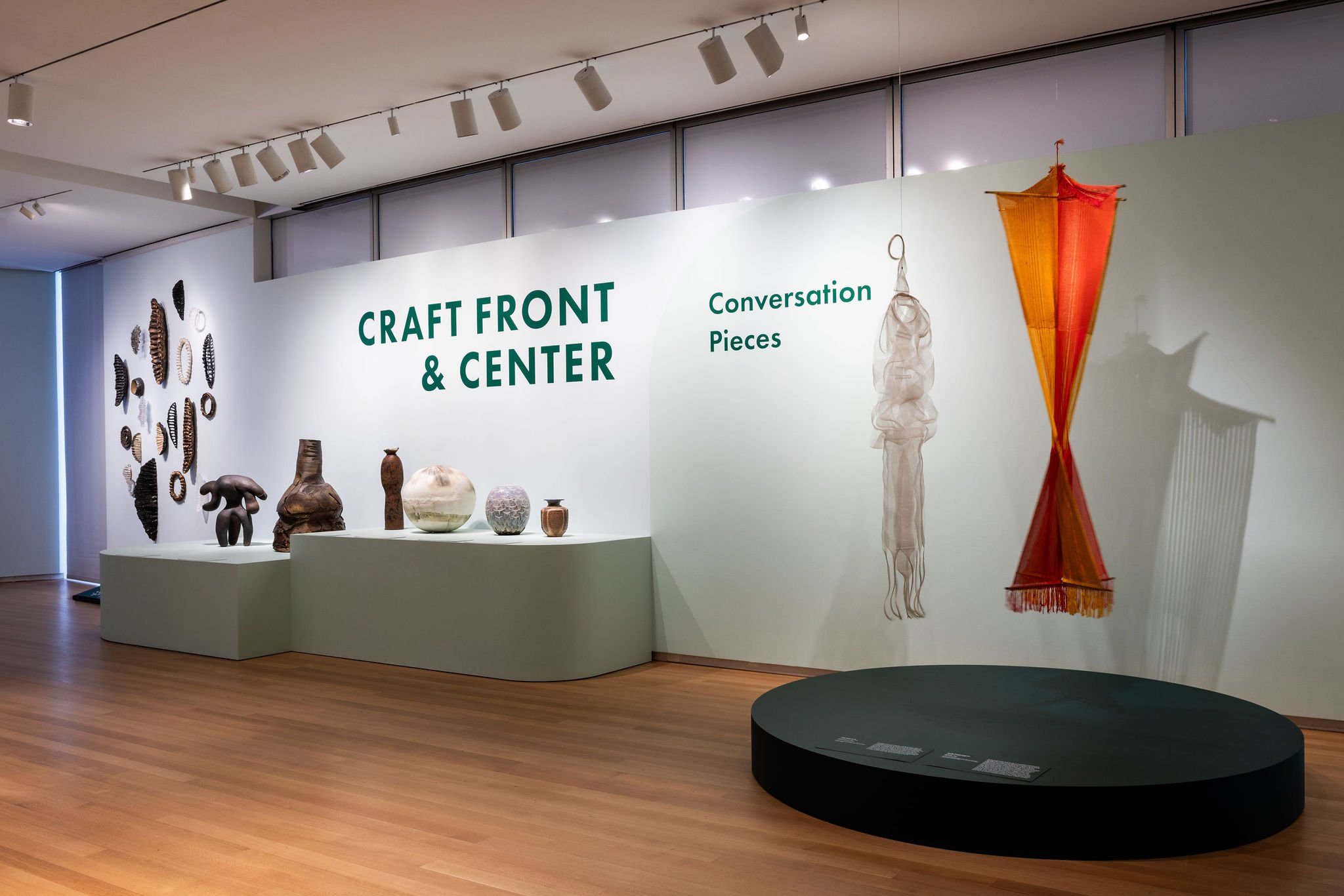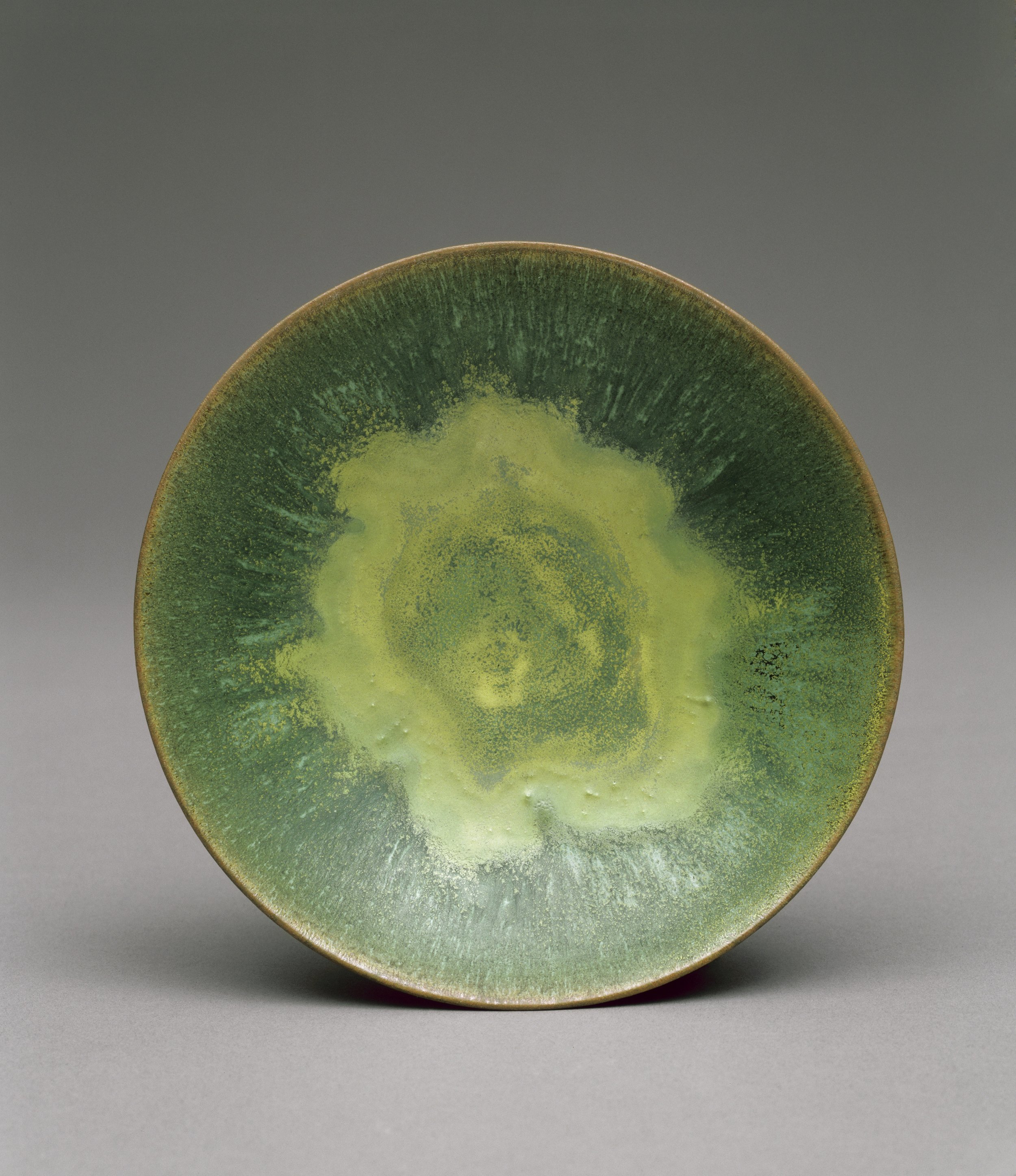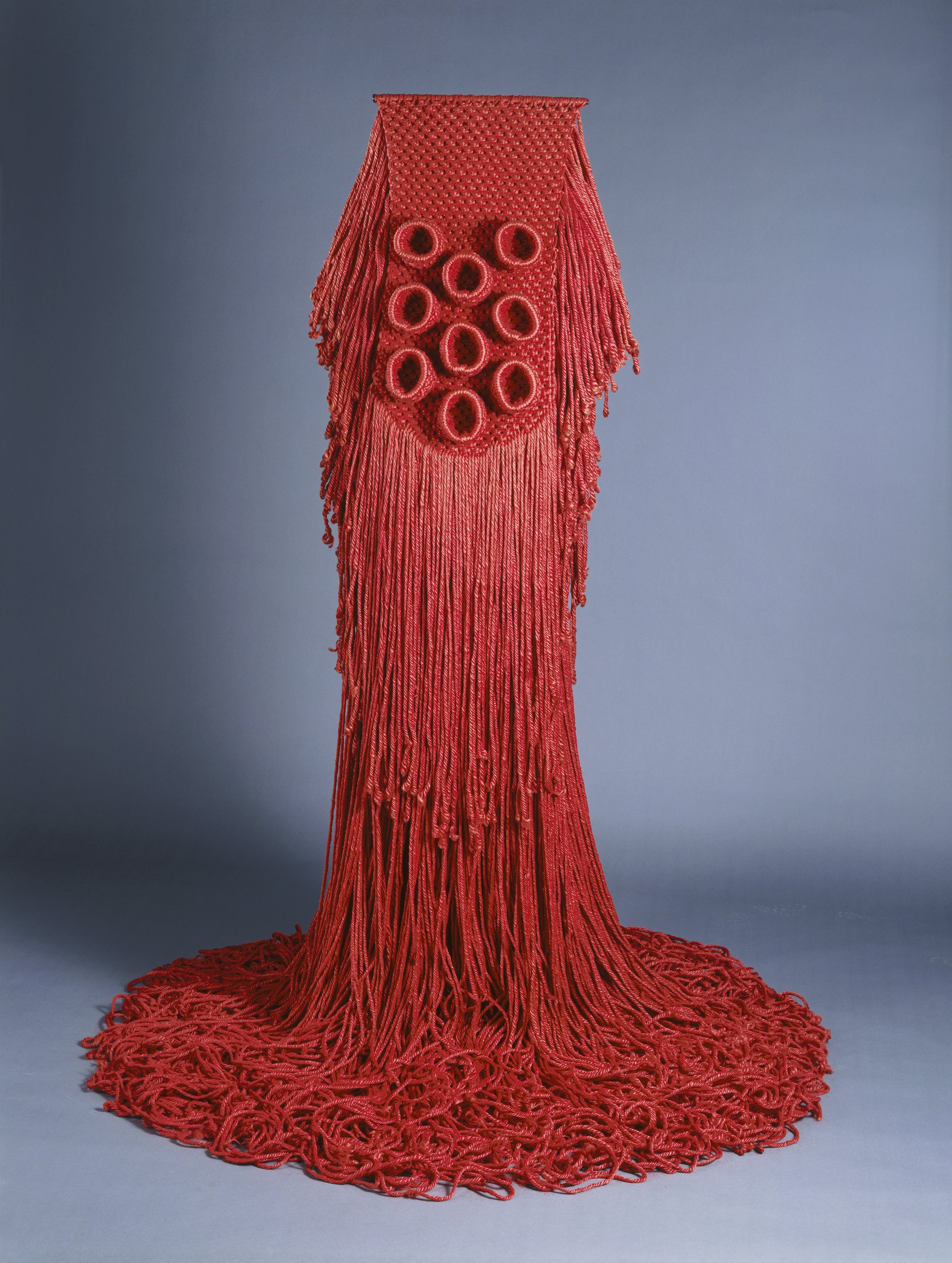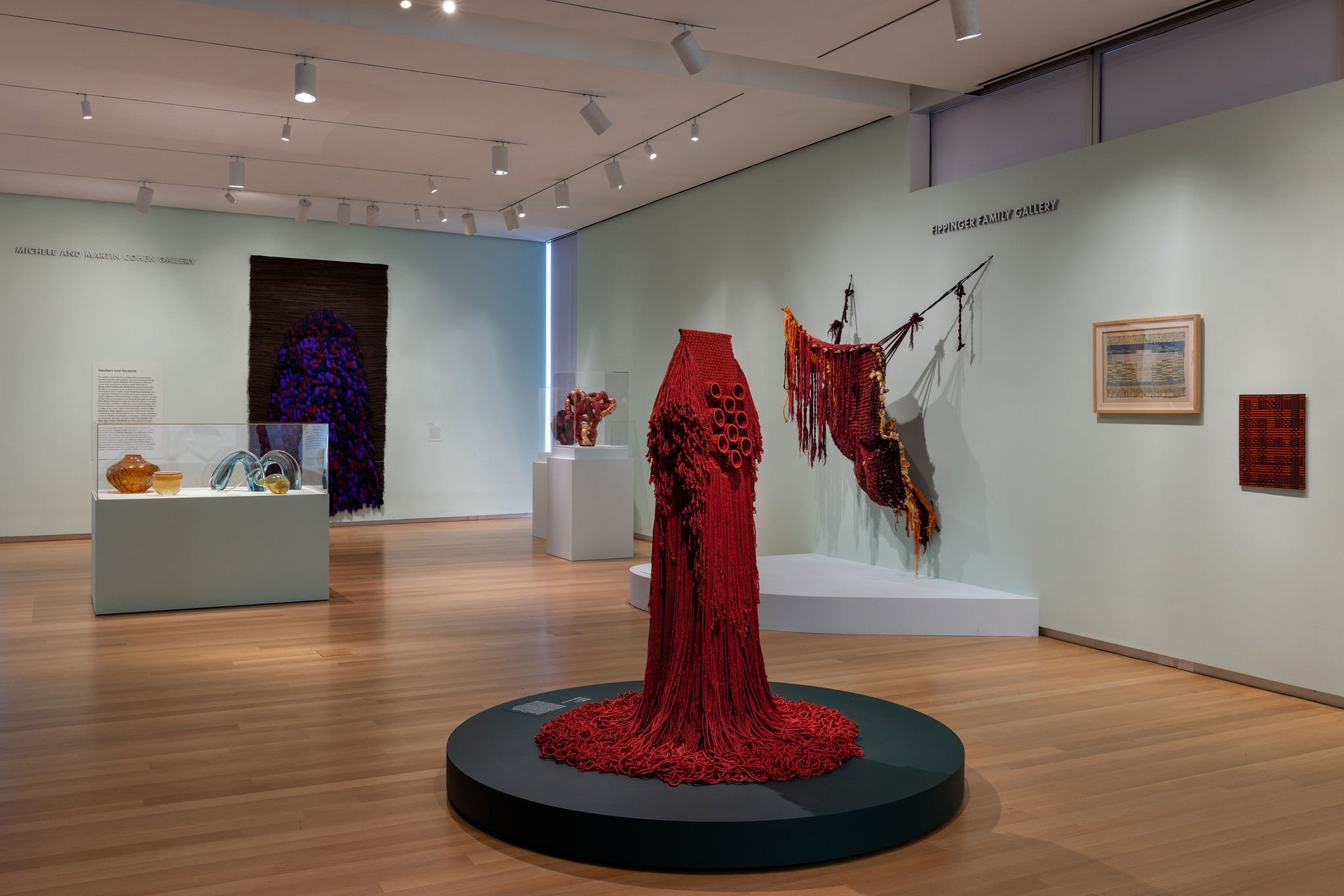Nico Williams: Aaniin, I See Your Light
Installation view, Nico Williams: Aaniin, I See Your Light. Brooklyn Museum, May 31–October 2024.
First Nations artist Nico Williams (Anishinaabe, born 1989) is activating the Brooklyn Museum’s outdoor plaza and American Art galleries this summer with Nico Williams: Aaniin, I See Your Light. The site-specific installation features the artist’s prismatic beadwork and large-scale iridescent jingles, which will transform the Museum into a place to play, explore, and celebrate Anishinaabe ways of being. Aaniin means both “hello” and “I see your light” in Anishinaabemowin, making the title of this interactive installation a greeting and an invitation to join in. Through this project, the Museum builds on its commitment to amplify Indigenous voices.
For generations, Anishinaabe artists have created beadwork that shares cultural knowledge and recognizes beauty as a form of medicine. Williams reflects on this tradition in his Breeze series, photographs of which will be installed on the Iris Cantor Plaza. Inspired by objects from the Museum’s collection of Indigenous art, the beaded patterns in this series overlay Anishinaabe geometric designs with visual motifs found in 19th-century beadwork and ribbon-work designs. Original pieces from the Breeze series will be on view in the American Art galleries through August 18, 2024.
Possibly Anishinaabe artist. Legging. Wool, silk, cotton, beads. Brooklyn Museum; Brooklyn Museum Collection, 05.66. (Photo: Brooklyn Museum)
The Iris Cantor Plaza will also be decorated with giant jingles inspired by the colorful metal adornments that Anishinaabe women use to decorate regalia. Originally made from tobacco tins and employed for healing practices, jingles are now worn by dancers from many Indigenous nations when competing at powwows. Williams’s kaleidoscopic versions are embossed with a pattern from an Anishinaabe sugar mold in the Museum’s collection (also on view in the galleries). Visitors are encouraged to gently play with jingles and help celebrate this long-standing tradition. The outdoor installation is on view through October 2024.
Installation view, Nico Williams: Aaniin, I See Your Light. Brooklyn Museum, May 31–October 2024.
“I’m excited for people to experience my work at the Brooklyn Museum this summer, both on a larger scale outside the Museum and through the smaller pieces on display in the galleries,” says Williams. “It’s wonderful to receive support from the Museum. Our art is our culture, so it’s meaningful to present it to the Brooklyn community. I’m overjoyed to be able to share Anishinaabe practices and all the exciting visual components that come along with them.”
Installation view, Nico Williams: Aaniin, I See Your Light. Brooklyn Museum, May 31–October 2024.
“As the first Indigenous artist ever featured on the plaza, Nico Williams both reflects upon and expands the artistic legacy of his community,” says Dare Turner, Curator of Indigenous Art at the Brooklyn Museum. “His work commandingly transforms the front of the Museum and celebrates the enduring vibrancy of Anishinaabe culture. In doing so, he affirms Indigenous artists’ rightful place within the world of museums, within Brooklyn, and within the fabric of society at large.”
Nico Williams: Aaniin, I See Your Light is organized by Dare Turner, Curator of Indigenous Art, with Grace Billingslea, Curatorial Assistant, Arts of the Americas and Europe, Brooklyn Museum.
Please visit the Brooklyn Museum’s site for more information about the exhibit. The Museum can also be found on Instagram, TikTok, YouTube, and Facebook.
Maurizio Cattelan: Sunday
MAURIZIO CATTELAN Sunday, 2024, installation view © Maurizio Cattelan Photo: Zeno Zotti Courtesy the artist and Gagosian
We are completely immersed in violence every day, and we’ve gotten used to it. The repetition has made us accept violence as inevitable.
—Maurizio Cattelan
NEW YORK, April 30, 2024—Gagosian is pleased to announce the opening of Sunday, Maurizio Cattelan’s first solo gallery exhibition in more than two decades and his solo debut at Gagosian. Similar to America—a functional solid gold toilet that he installed at the Solomon R. Guggenheim Museum, New York, in 2016—Cattelan’s new project, which is on view at the gallery’s 522 West 21st Street location, once again challenges the contradictions of American society and culture, and touches on sensitive issues faced by the world at large.
MAURIZIO CATTELAN Sunday, 2024, installation view © Maurizio Cattelan Photo: Maris Hutchinson Courtesy Gagosian
In a new installation, Sunday (2024), Cattelan compounds the response to economic inequality embodied by America (2016), using precious metal to deconstruct the country’s relationship to the accessibility of weapons (a condition against which privilege affords no defense). Panels of stainless steel, plated in 24-karat gold, have been “modified” by gunfire. The components’ formerly smooth surfaces are left riddled with craters and holes, evoking a history of guns in art that stretches from Edouard Manet’s The Execution of Emperor Maximilian (1868–69) to Chris Burden’s Shoot (1971) and William Burroughs’s shotgun paintings.
Visitors to Gagosian’s 21st Street location are immediately confronted by a towering, 17-foot-tall wall of the gilded panels that stretches some 68 feet wide. In front of it is November (2024), a marble fountain that portrays a slouching figure urinating on the ground. Cattelan characterizes the work as “a monument to marginality,” an image of a reality that we habitually ignore. Echoing Manneken Pis (1619), a famous public sculpture of a boy urinating into a fountain, it presents the viewer with an uncomfortable contravention of societal norms. But, as Bonami demands, “If you’re free to buy an assault rifle in a department store, what’s wrong with pissing in public?”
MAURIZIO CATTELAN Sunday, 2024, installation view © Maurizio Cattelan Photo: Maris Hutchinson Courtesy Gagosian
Cattelan traces the opulent composition of both new works back to the Catholic spiritual tradition in which he was raised, also pointing out that the ease of melting down and reusing gold gives the material a fungible, unfixed nature that allows it to effectively disappear. Even when dealing with such sensitive subjects, however, he remains a “Sunday” artist at heart, avoiding explicit judgment in favor of presenting reality as he observes it.
Born in Padua, Italy, in 1960, Cattelan is one of the most provocative figures in the art world. Often dismissed as a prankster, he is a deeply political artist whose work investigates issues that affect us all. In Sunday, Cattelan affirms his ability to address art history and current affairs simultaneously, presenting them as two parallel but paradoxically convergent tracks. Cattelan is, in the words of the exhibition’s curator Francesco Bonami, “the most famous Italian artist since Caravaggio.” While the claim may seem overblown, the popularity of the artist’s recent exhibitions at UCCA Center for Contemporary Art, Beijing, and the Leeum Museum of Art, Seoul, confirm his ability to engage both art-world audiences and a global public.
Cattelan’s exhibition The Third Hand is on view at the Moderna Museet, Stockholm, until January 12, 2025. His work is also on view in With My Eyes, the Vatican’s exhibition for the Holy See Pavilion at the 60th Biennale di Venezia, through November 24, 2024.
MAURIZIO CATTELAN Sunday, 2024, installation view © Maurizio Cattelan Photo: Zeno Zotti Courtesy the artist and Gagosian
Maurizio Cattelan was born in Padua, Italy, in 1960, and lives and works in Milan and New York. Collections include the Museum of Modern Art, New York; Solomon R. Guggenheim Museum, New York; Museum of Contemporary Art, Los Angeles; Castello di Rivoli Museo d’Arte Contemporanea, Turin, Italy; and Migros Museum für Gegenwartskunst, Zurich. Exhibitions include Felix, Museum of Contemporary Art, Chicago (2002–03); Museum of Contemporary Art, Los Angeles (2003); Museum Ludwig, Cologne, Germany (2003); Now, Musee d’Art moderne de la ville de Paris/ARC at the Chapelle des Petits Augustins, Ecole nationale superieure des Beaux-Arts, Paris (2004); Museum für Moderne Kunst, Frankfurt am Main, Germany (2007); New Works, Tate Modern, London (2007); Kaputt, Fondation Beyeler, Riehen/Basel (2013); Victory Is Not an Option, Blenheim Palace, Woodstock, England (2019); and We, Leeum Museum of Art, Seoul (2023). In 2011, Cattelan’s work was the subject of All, a retrospective at the Solomon R. Guggenheim Museum, New York. The Last Judgment, his first solo exhibition in China, was on view at UCCA Center for Contemporary Art, Beijing, from 2021 to 2022. His work has also been featured in the Biennale di Venezia (1993, 1997, 1999, 2002, 2003, 2011, and 2024); Manifesta 2, Luxembourg (1998); Istanbul Biennial (1998); and Whitney Biennial, New York (2004). In 2002, Cattelan cofounded the Wrong Gallery, New York, and in 2010, he cofounded Toiletpaper, a biannual visual magazine.
MAURIZIO CATTELAN Photo: Courtesy of the artist
The exhibition is curated by Francesco Bonami; there was an opening reception on Tuesday, April 30, from 6–8pm. The exhibition is being held at the 522 West 21st Street, New York gallery location.
For more information about this exhibition and others presented by Gagosian please visit the gallery’s site here. The gallery can also be found on Pinterest, X, YouTube, Facebook, Instagram, and Artsy.
Rachel Garrard : TIME WILL NOT WAIT FOR US
Installation View: Rachel Garrard, TIME WILL NOT WAIT FOR US 31 MAY – 29 JUNE 2024 Courtesy of the artist & KÖNIG GALERIE
KÖNIG TELEGRAPHENAMT is pleased to present the exhibition TIME WILL NOT WAIT FOR US by Rachel Garrard, her first solo presentation with the gallery. The exhibition brings together Garrard›s most recent body of work, showcasing her exploration of abstraction through the intertwining of the natural world, perception, and imagination.
Garrard›s artistic practice encompasses a range of both mediums and techniques, including painting, sculpture, sound, and video. Her work is deeply rooted in extensive research into contemporary science, the fundamental elements of nature, the mathematics of harmonious forms, and the potential energy in material objects. Through this interdisciplinary approach, Garrard has developed a distinct symbolic language that aims to connect subjective experience with the cosmic and the universal.
In her paintings, such as DIRECTION IN SPACE and PASSING THROUGH (both 2024), she layers pigments collected from rocks and minerals directly onto the canvas until abstract universes emerge. Her use of natural materials seeks to link the terrestrial with inner landscapes, where the geometry, shapes, and colors of the paintings evoke dreamlike spaces, impossible architectures, and indecipherable symbols, functioning as a threshold between the visible and the invisible. The metaphysical and luminous quality of Garrad’s works engender a rich sensorium of synesthetic experience.









Installation View: Rachel Garrard, TIME WILL NOT WAIT FOR US 31 MAY – 29 JUNE 2024 Courtesy of the artist & KÖNIG GALERIE
In addition to her paintings, the exhibition includes a series of 24 drawings titled INNER LANDSCAPES, 2024 as well as a series of sculptures made from steel and wood: ASCENSION, PARALLEL WORLDS, and SPACE (all 2021). Like the manner in which the paintings seem to correspond to one another through a carefully selected dialogue of forms, so do the sculptures, though in comparison to the paintings, the emphasis is heavier, weighted, and even.
The exhibition›s theme is informed by the current tensions within global politics and the challenges facing the nat- ural world. Garrard sets these against the potential she sees in cosmic structures as a reliable system that manages to hold everything together. In a time of uncertainty and divisiveness, Garrard believes in anchoring her work in the unchanging principles that govern the universe.
The exhibition opened on May 31 and will be on view until June 29, 2024. For more information about this exhibition and others at the KÖNIG TELEGRAPHENAMT please visit their site here The gallery can be found on YouTube, Instagram, and Facebook.
Michael Ray Charles : Afrochemistry
(Forever Free) Head 1, 2005 Latex acrylique et penny de cuivre sur toile | Acrylic latex and copper penny on canvas 226 × 150 cm — 89 × 59 in Photo © Remei Giralt
TEMPLON presents the third solo exhibition of work by African American artist Michael Ray Charles with the invaluable help of the exhibition’s curator, Hedwig Van Impe. “Afrochemistry” features a series of five large canvases and twelve small red nose portraits on cardboard centring on the representation of black identity.
Since the 1990s, Michael Ray Charles has become a widely recognised artist with a pioneering approach to investigating African-American questions. He draws on his inexhaustible fund of energy and capacity to transcend linguistic, cultural and geographic boundaries to create visual archives that stand as a personal chronicle of an African-American history rooted in both terror and light, freedom and slavery, racism and humanity, guilt and responsibility.
(Forever Free) Head 4, 2005 Latex acrylique et penny de cuivre sur toile | Acrylic latex and copper penny on canvas 226 × 150 cm — 89 × 59 in Photo © Remei Giralt
With Afrochemistry, Charles delicately juggles between idea and image to explore the way African-Americans are represented physically and the resulting moral prejudices. The figures depicted in close-up radiate a feeling of depth and truth that has the disconcertingly powerful effect of questioning our perceptions and emotional connection with others. The features Charles gives the faces, as expressive as they are static, not only offer an examination of sensitive social issues but also serve as a catalyst for social change in modern-day America.










Toutes les images / All images : Courtesy the artist and Templon, Paris —Brussels — New York
Born in 1967 in Lafayette, Louisiana, USA, Michael Ray Charles currently lives and works in Austin, Texas, USA, and Gand, Belgium. He spent most of his youth in California and Louisiana. He studied design and advertising for three and a half years before being awarded a BFA degree in 1989. He went on to obtain an MFA in 1993 at the University of Houston, Texas, before teaching at the University of Texas in Austin. His work features in a wide range of public collections, including the Museum of Modern Art in New York, the Museum of Fine Arts in Houston, Arizona State University Art Museum, and the San Antonio Museum of Art in Texas. He has been represented by Galerie Templon since 2021.
For more information about Michael’s artwork and his exhibition, please visit Templon’s site. The gallery can also be found on Instagram, artnet, Facebook, YouTube, and Artsy.
Tracey Emin : By the time you see me there will be nothing left
Installation View: Tracey Emin, By the time you see me there will be nothing left 24 May — 24 July 2024 courtesy of Xavier Hufkens and @Thomas Merle
Tracey Emin’s new exhibition with the gallery revolves around a seminal theme in her oeuvre—love in all its many guises. In a new series of paintings, ranging from the intimately scaled to the monumental, Emin explores the intricacies of the human emotions, revealing a profound understanding of our innermost workings. Gestural brushstrokes and bold use of colour evoke intimacy of the human body and its emotions laid bare. While Emin’s commitment to painting has remained steadfast throughout her career, recent years have seen a renewed focus on this core element of her art. This revived attention is evident as she immerses herself deeper into the realm of painting, infusing her art with her personal experiences of love and mortality.
I watched myself die and come alive, 2023
Love permeates Tracey Emin’s entire body of work. It transcends mere emotion, manifesting as both a physical act and a mental state. It can be felt as much by the body as by the mind. Emin shows love in its myriad form—from the wondrous to the painful, the obsessive to the elusive. Central to these paintings is the symbiotic relationship between love and time, exploring its past, present, and future manifestations. You Loved Me—Then and I Fucking Loved You capture moments of nostalgia and longing, rooted in the past, while Kissing, Lust and A Feeling embody the immediacy of the present. Please Keep Loving me echoes a sentiment of enduring hope, reflecting Emin’s belief in the resilience and continuity of love.
I wanted to be clean, 2023
Inextricably linked to the ideas of love and time, however, is death. While not a subject that Emin has ever shied away from in her work—she created a poignant series of paintings about the loss of her mother, for example—it is one that acquires a deeply personal meaning in the context of her recent, life-threatening illness. There’s nothing Left of her, and I Melted away both attest to this confrontation with mortality. In I watched Myself die and come alive, we see the artist on a table in a domestic setting, watched over by a shrouded figure. The work is a clear allusion to resurrection: staring death in the face and returning to life. The work has a dream-like quality: a table can have a homely or surgical function; it is not clear if the spectral figure belongs to the constructed reality or the subconscious.
We all bleed, 2023
Dreams and sleep, and their antitheses—nightmares and insomnia—are also weaved through the exhibition, alongside the ghosts of past masters. Her painting The Nightmare, for example, echoes the Swiss artist Henry Fuseli’s work of the same name from 1781: a dark incubus atop a pale, supine woman. The image reflects Emin’s deep engagement with art history, as seen in previous works inspired by Edvard Munch. From My Bed (1998) to Insomnia Room (2019), the artist’s nocturnal hours, both good and bad, invariably seep into her work. Several paintings in the exhibition, including I Kept Dreaming, Night Time, and Sleeping with my eyes open extend this trajectory. Water also makes its presence felt, both in the myriad shades of blue that can be seen in the paintings, but also as a motif. It embodies various symbolic interpretations, serving as a symbol of purity and renewal (I wanted to be clean) to one of fear and anxiety (I Kept Drowning).




Installation View: Tracey Emin, By the time you see me there will be nothing left 24 May — 24 July 2024 courtesy of Xavier Hufkens and @Thomas Merle
Most of the works in the exhibition depict the artist—either alone or entwined with another—in a prone position: in a bed, on a table, a chaise longue or sofa. Emin has frequently depicted beds in her work, presenting them as places with both positive and negative connotations: they can be sites of pain and pleasure, or dreams and torments. They remind us of home, but also of hospitals and convalescence. They are where we are born and, traditionally, where we die. But in four vertical self-portraits, the artist is not in repose but erect, facing the viewer.
Entitled This is Me, Always A Mirror, You could drink me and I Felt So Much Older, they hint at a process of emotional realignment and acceptance. With the same linear quality as the faces she created for the doors of the National Portrait Gallery in London, Emin’s self-portraits show the artist looking out of the frame and into the world.
Photo Credit : Harry Weller
Tracey Emin (b. 1963, London) lives and works between London, the South of France and Margate, UK. In 2023, she opened an eponymous foundation and art school in Margate, which offers residencies to emerging international artists and stages exhibitions. Recent public commissions include The Doors (2023), a set of bronze doors for the National Portrait Gallery, London; The Mother (2022), a large outdoor bronze for the Munch Museum, Oslo; and I Want My Time With You (2018), a large neon work for St Pancras Station, London.
Recent solo exhibitions include the Munch Museum, Oslo (2021); the Royal Academy of Arts, London (2020); Musée d’Orsay, Paris (2019); Château La Coste, Aix-en-Provence, France (2017); Leopold Museum, Vienna (2015); Museum of Contemporary Art, Miami, Florida (2013); Museo de Arte Latinoamericano de Buenos Aires (2012); Turner Contemporary, Margate, UK (2012); Hayward Gallery, London (2011); Kunstmuseum Bern, Switzerland (2009); Scottish National Gallery of Modern Art, Edinburgh (2008); Centro de Arte Contemporáneo, Malaga, Spain (2008); Art Gallery of New South Wales, Sydney (2003); and Stedelijk Museum, Amsterdam (2002).
Tracey Emin represented Great Britain at the 52nd Venice Biennale in 2007. In 2012, she was appointed Commander of the Most Excellent Order of the British Empire for her contributions to the visual arts.
For more information about this exhibition and others, please visit Xavier Hufken’s site here. The gallery can also be found on Instagram, Facebook, and YouTube.
Thomas Struth : Nature & Politics
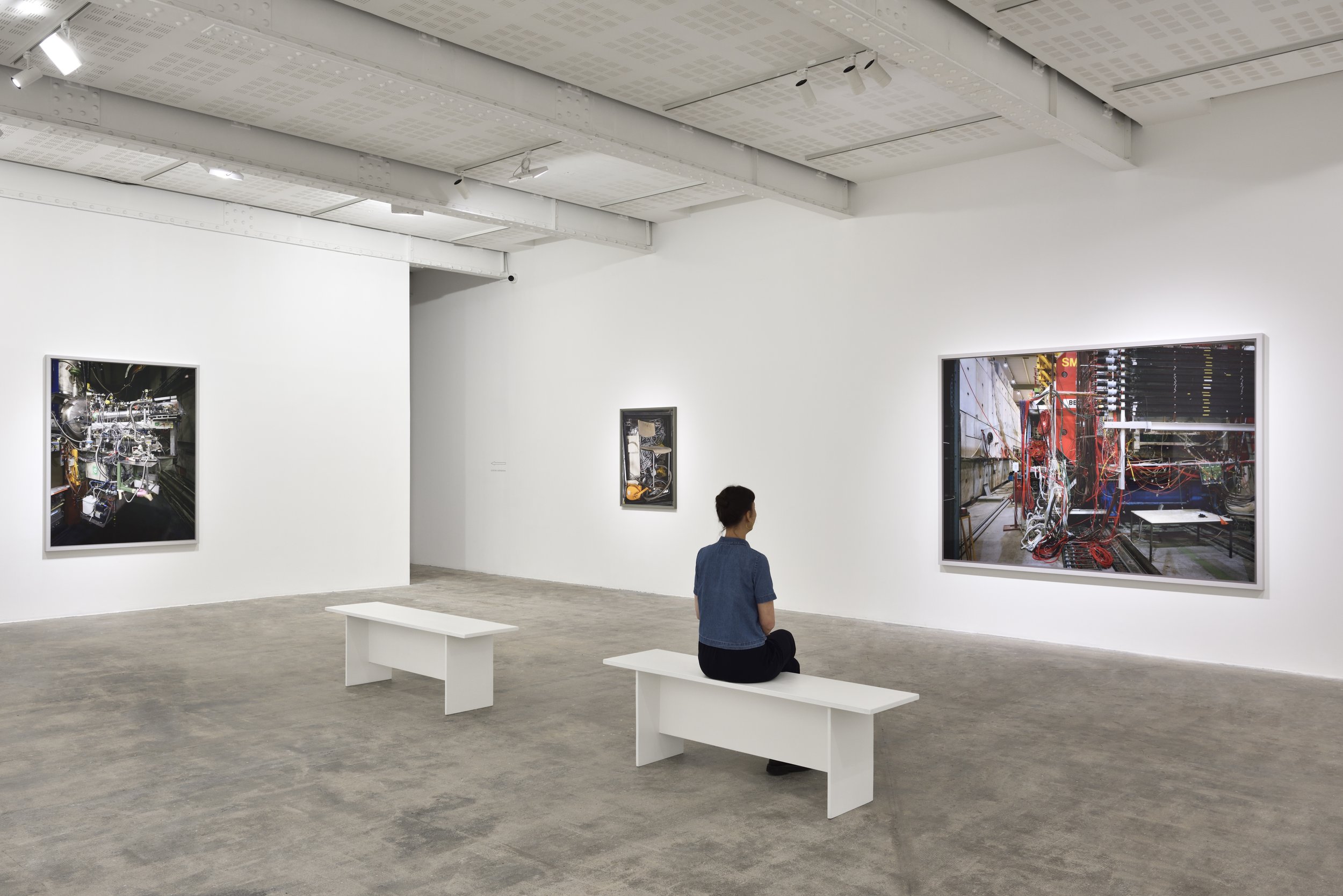

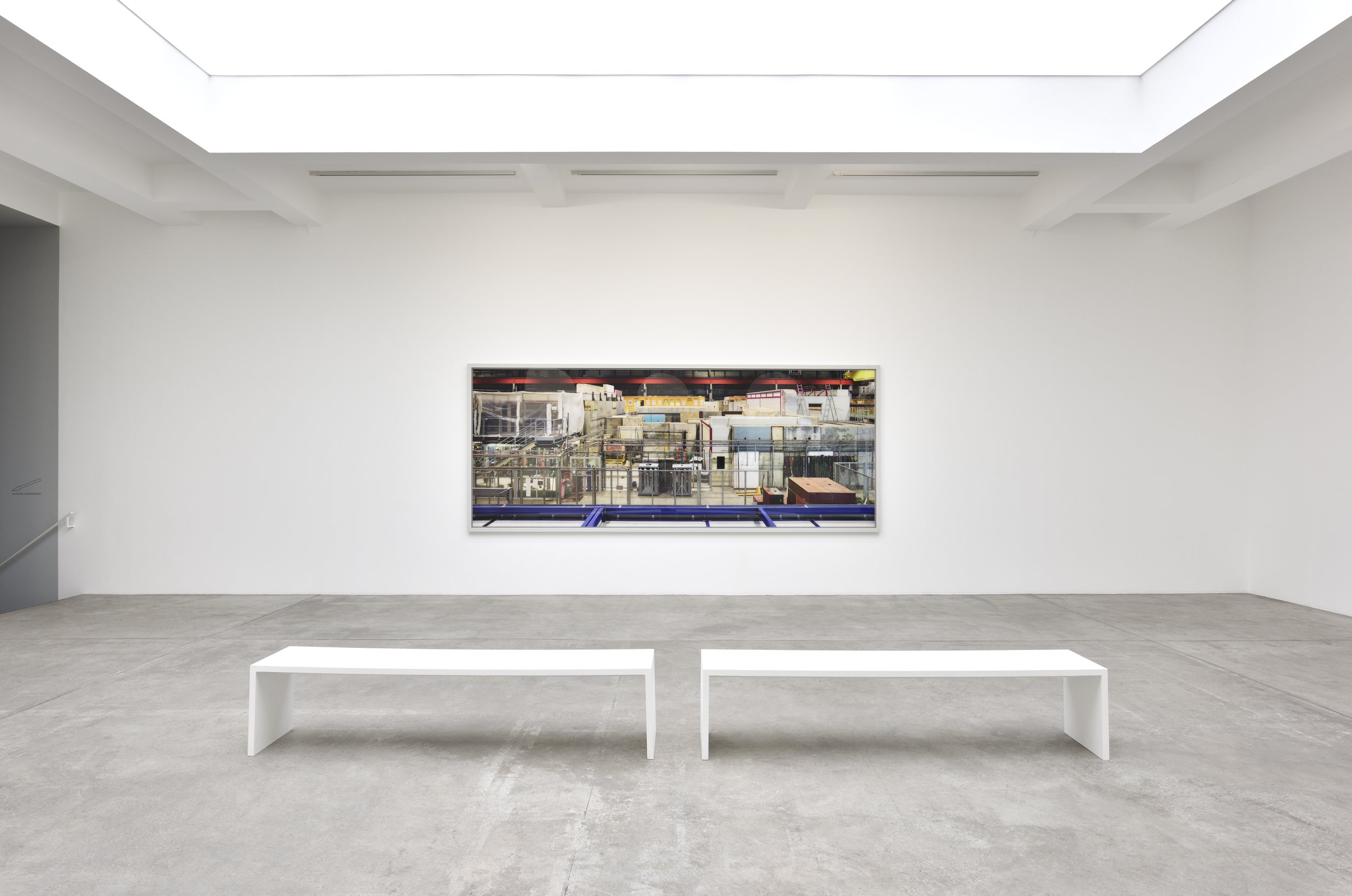


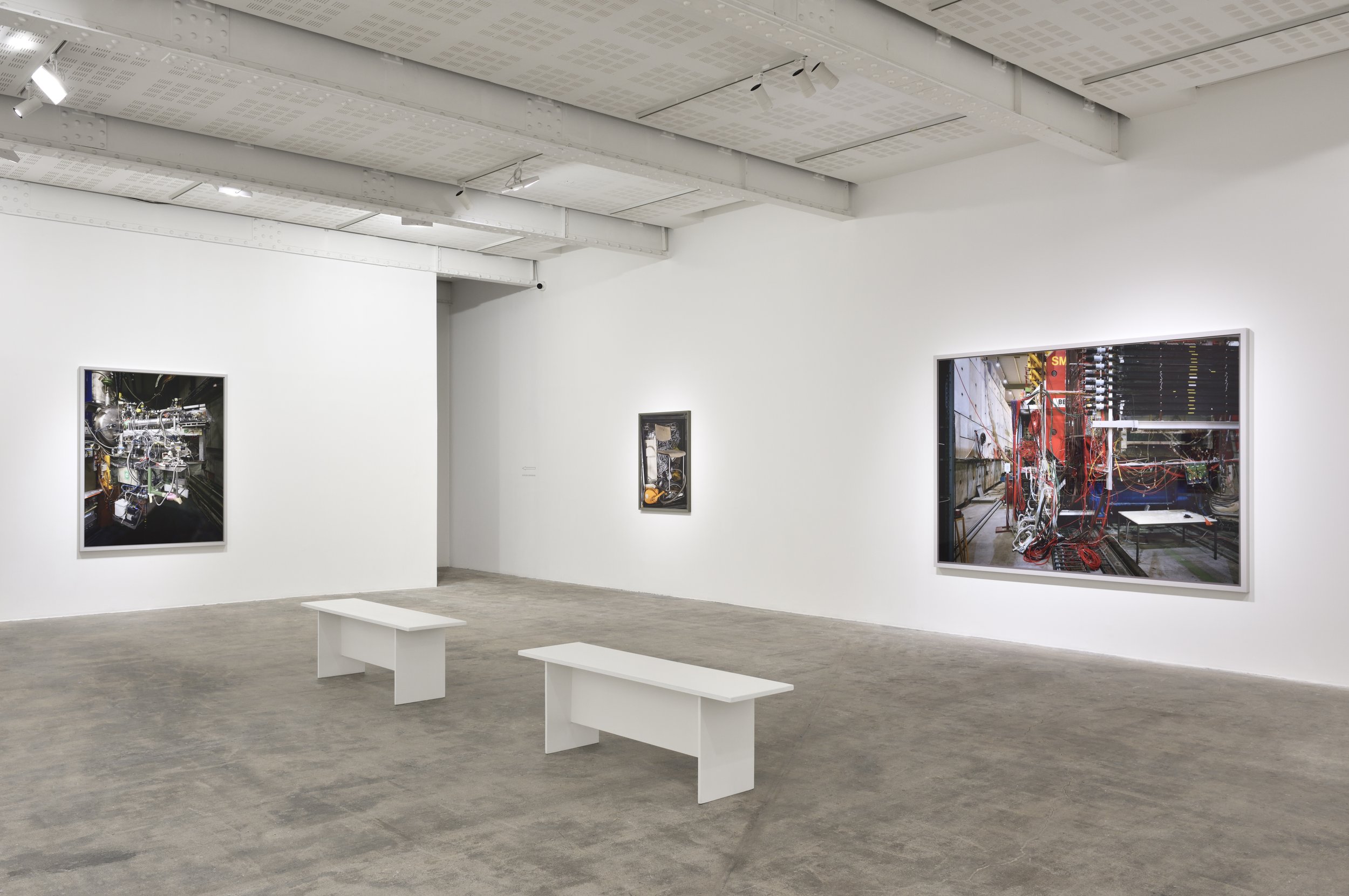

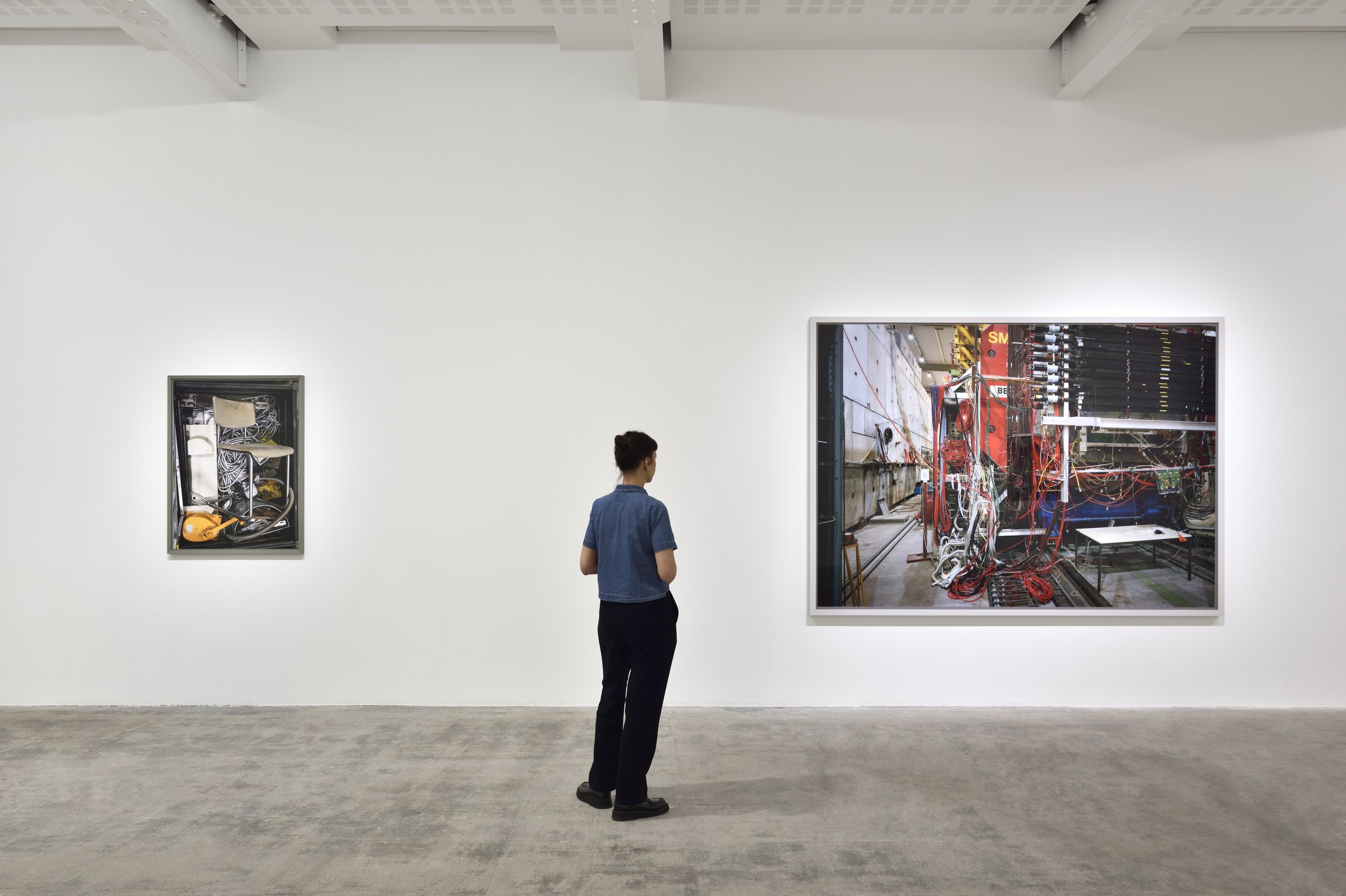
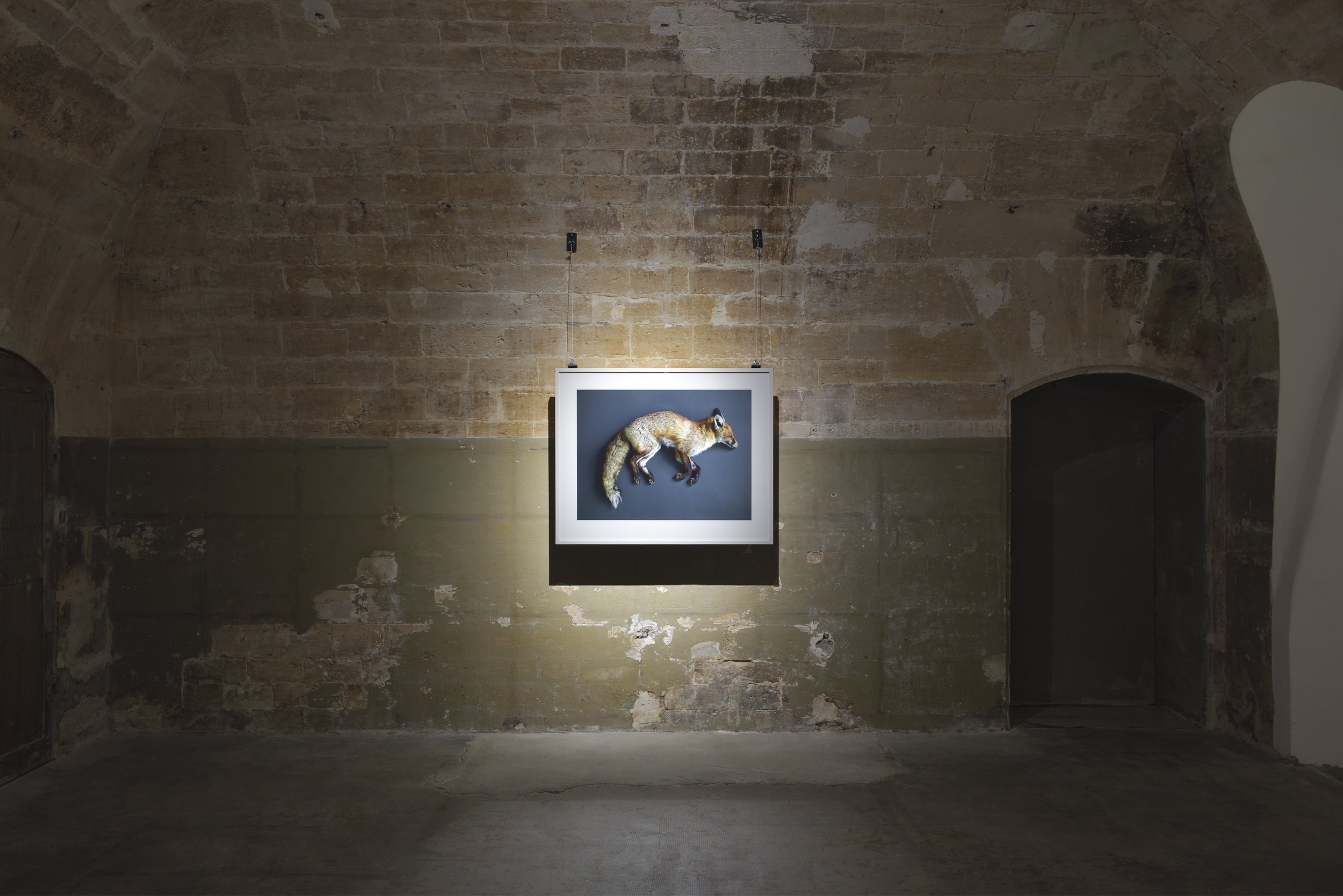
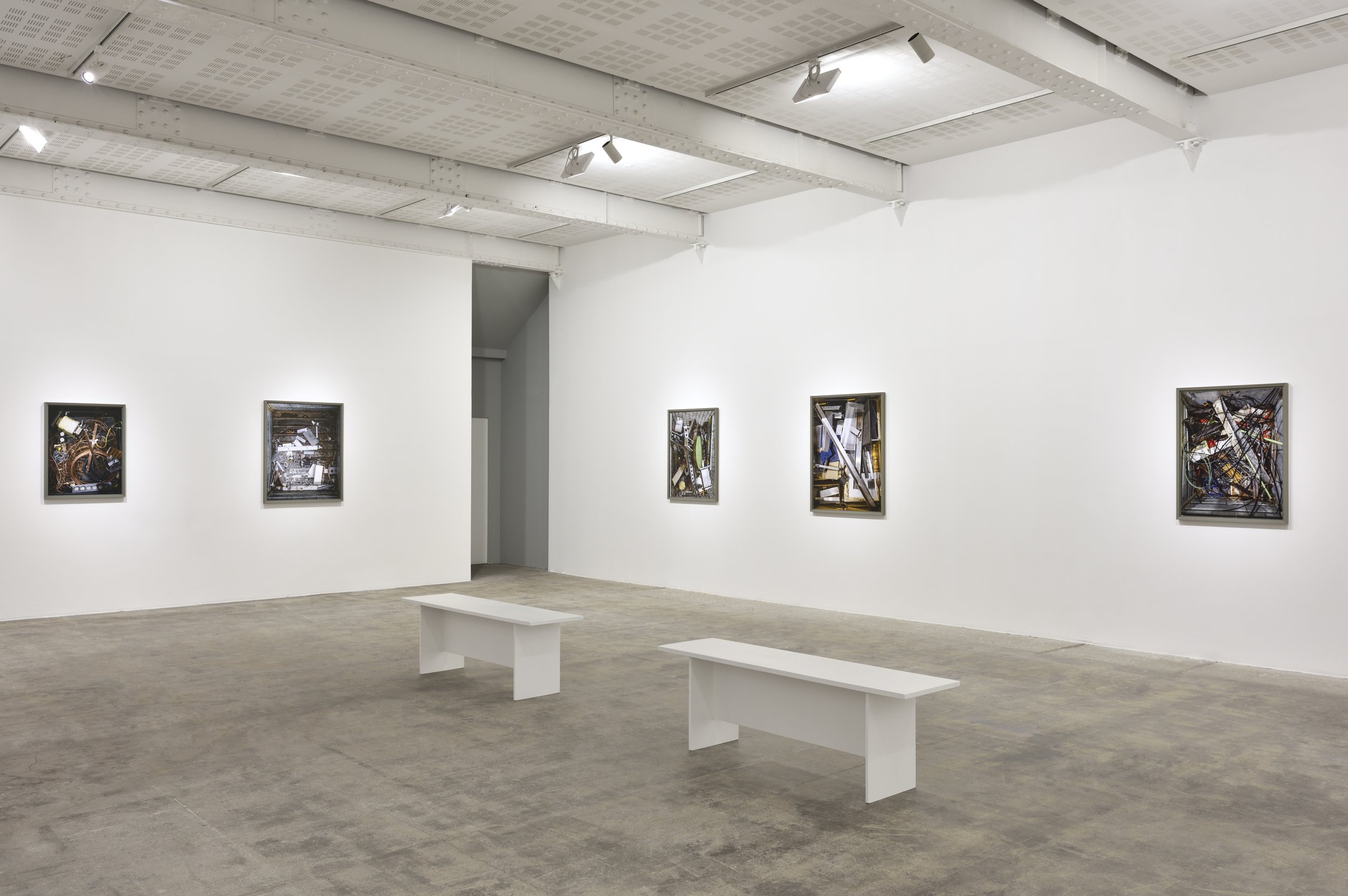
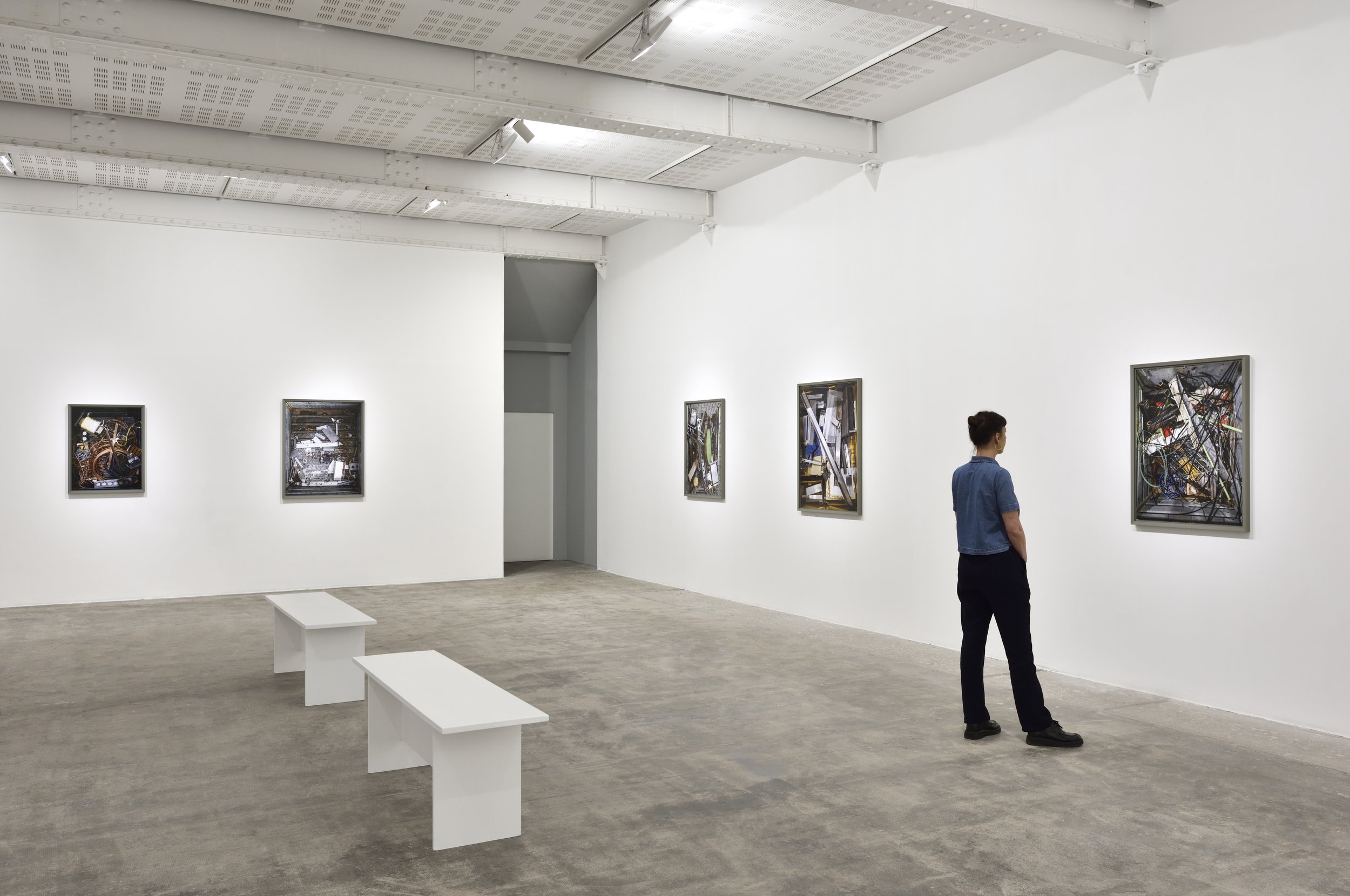



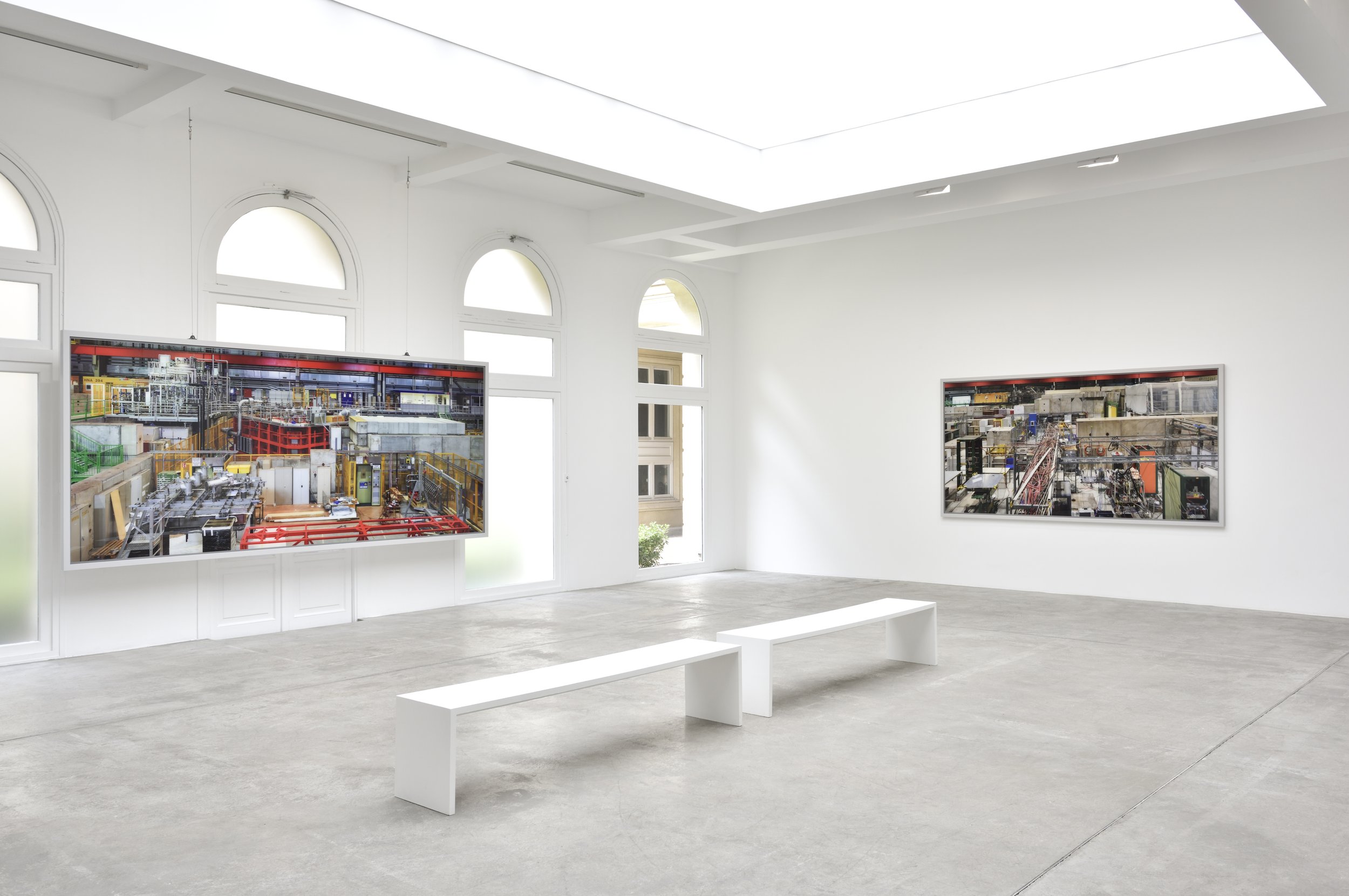
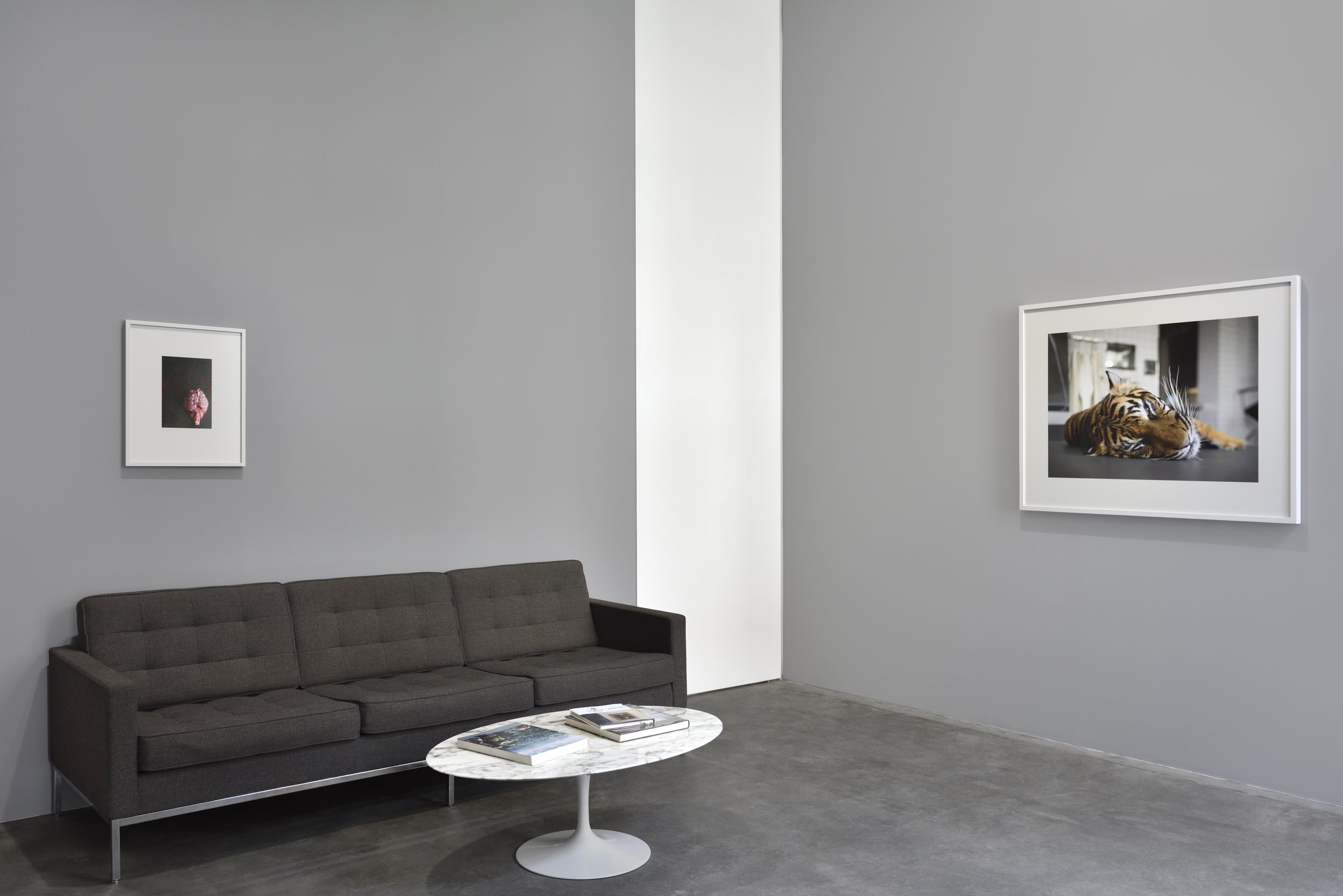

Exhibition view: Thomas Struth; Nature & Politics, Galerie Marian Goodman Paris 25 May – 26 July 2024 Photo credit: Rebecca Fanuele © Thomas Struth and Marian Goodman Gallery Courtesy of the artist and Marian Goodman Gallery
“My work is about the theater of life in different chapters.” – Thomas Struth, 2023
Marian Goodman Gallery is pleased to present a new solo exhibition by Thomas Struth in Paris. Nature & Politics is the internationally acclaimed artist’s first solo show in France dedicated to his eponymous body of work begun in 2007. The exhibition focuses on photographs taken over the past few years at the European Organization for Nuclear Research (CERN) and the Leibniz Institute for Zoo and Wildlife Research (IZW), two of the world's most prestigious scientific research centers, where the scale and complexity of experimentation eludes most of us. Through the photographs in Nature & Politics, Thomas Struth explores our relationship with science and technology, the way we collectively defy nature and our inextinguishable desire to push back the limits of human knowledge.
Container 3, CERN, Meyrin, 2023 Inkjet print 107 x 80 cm © Thomas Struth Courtesy of the artist and Marian Goodman Gallery
Renowned for his photographic work since the 1970s, Struth is driven by the idea that art should “show what others don't see.” With Nature & Politics, he has developed a unique body of works taken in places of advanced technology rarely accessible to the public, such as physics institutes, pharmaceutical factories, space stations, arsenals, and operating rooms. Since 2019 he has been able to enter the various sites of CERN, the world's largest particle physics center, located on either side of the French-Swiss border near Geneva.
On the first floor of the gallery, several meter-long photographs reveal monumental scientific structures that constitute CERN's Prévessin-Moëns and Meyrin sites. Beam Line Zone 1, Beam Line Zone 2 and ProtoDUNE, each detail infrastructures in Hall EHN1 (Experimental Hall North area 1), the organization's largest building. These panoramic immersive views show complex, visually unintelligible structures that resemble immense technological “landscapes.” Their characteristics and colors are almost reminiscent of sculptural installations. Marked by the absence of any humanity – reminiscent of the deserted New York City streets Struth photographed in the 1970s - these constructions are nonetheless the product of human genius. Like the cathedrals of their day, they represent one of mankind’s greatest technological achievements, enabling us to investigate the origins of the universe.
Container 5, CERN, Meyrin, 2023 Inkjet print 96 x 72 cm © Thomas Struth Courtesy of the artist and Marian Goodman Gallery
On the lower level of the gallery, works that capture the intricacies of CERN’s mechanisms, such as Magnet 2 and X-ray Telescope, are shown in counterpoint to the Containers series, originally scattered throughout CERN's various halls, and recently the subject of interest to the artist. In contrast to the imposing infrastructures presented on the first floor, these pictures, taken from an omniscient perspective, are smaller in scale and represent remnants of technological discovery. Within the containers, materials and objects are layered, having been temporarily discarded, for potential reuse in future experiments. This random detritus, taken out of context by Struth, becomes an ordered composition that frames the accumulations as if they were artworks in themselves.
In the final room of the exhibition, the CERN works give way to Animals, another group of photographs taken at the Leibniz Institute for Zoo and Wildlife Research (IZW) in Berlin, where Struth has been visiting regularly since 2016. The IZW's mission is to study the diversity and evolution of the world's wildlife, both free-living and captive, and in particular the anthropogenic impact on species and their ecosystems. Once again, Struth points his lens at activities little known to the public: the laboratory's researchers, just hours after the natural death of an animal, methodically dissect it to analyze the causes of its demise. Each work shows, against a solemn dark gray background, an animal's remains before dissection, like a prelude to a kind of ritual. These post-mortem photographs, with their painterly aesthetic, follow in the long tradition of memento mori: "I've tried to represent animals in a beautiful and dignified way. I'm interested in the idea of abandonment: once you die, the whole circus you proactively create, the theater, comes to a complete halt. These images should be like punches, the memory of death like a wake-up call". But the subject of the series is not just the death of the animal; as the state of the brain, photographed just after it has been removed, underscores, it is the way in which the science of our Anthropocene era seizes upon this death for the purposes of study that is at the core of Struth's reflections.
Thomas Struth, September 2019 Photo credit: Vanessa Enders Courtesy of the artist and Marian Goodman Gallery
Thomas Struth, born 1954 in Geldern, Germany, lives and works in Berlin. He studied at the Kunstakademie in Düsseldorf. Recent comprehensive exhibitions of his work include Figure Ground, his largest show to date, which was presented at Haus der Kunst in 2017 in Munich before traveling to the Guggenheim Museum Bilbao in 2019, as well as Nature & Politics presented successively at the Folkwang Museum in Essen, the Martin-Gropius-Bau in Berlin, the High Museum in Atlanta, the Moody Center for the Arts in Houston, the St. Louis Museum of Art and the MAST Foundation in Bologna between 2016 and 2019.
Recently, Struth has had solo exhibitions at the Hilti Art Foundation, Vaduz, Lichtenstein (2019), Aspen Museum of Art, United States (2018) and Metropolitan Museum of Art, New York (2014). The major retrospective Photographs 1978-2010 traveled from Kunsthaus Zürich (2010) to K20 Kunstsammlung Nordrhein-Westfalen, Düsseldorf (2011) and from Whitechapel Gallery, London (2012) to Museu Serralves, Porto (2011-2012). His photographs have also toured the world in international group shows, including Capturing the moment at Tate Modern London (2023/2024) and ... et labora at Fondation Vincent van Gogh in Arles (2019-2020), among others. Struth also participated in Common Ground, the Venice Architecture Biennale (2012), Future Dimension, the Venice Biennale (1990) and Documenta IX (1992).
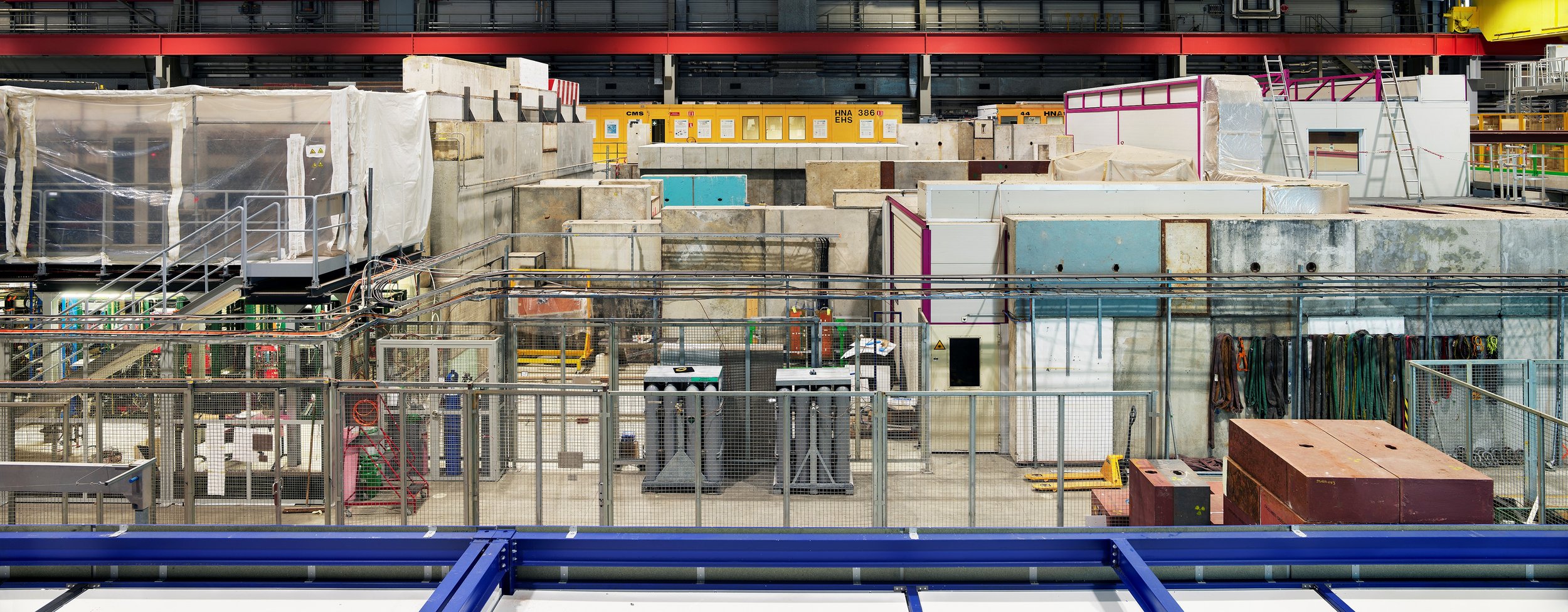
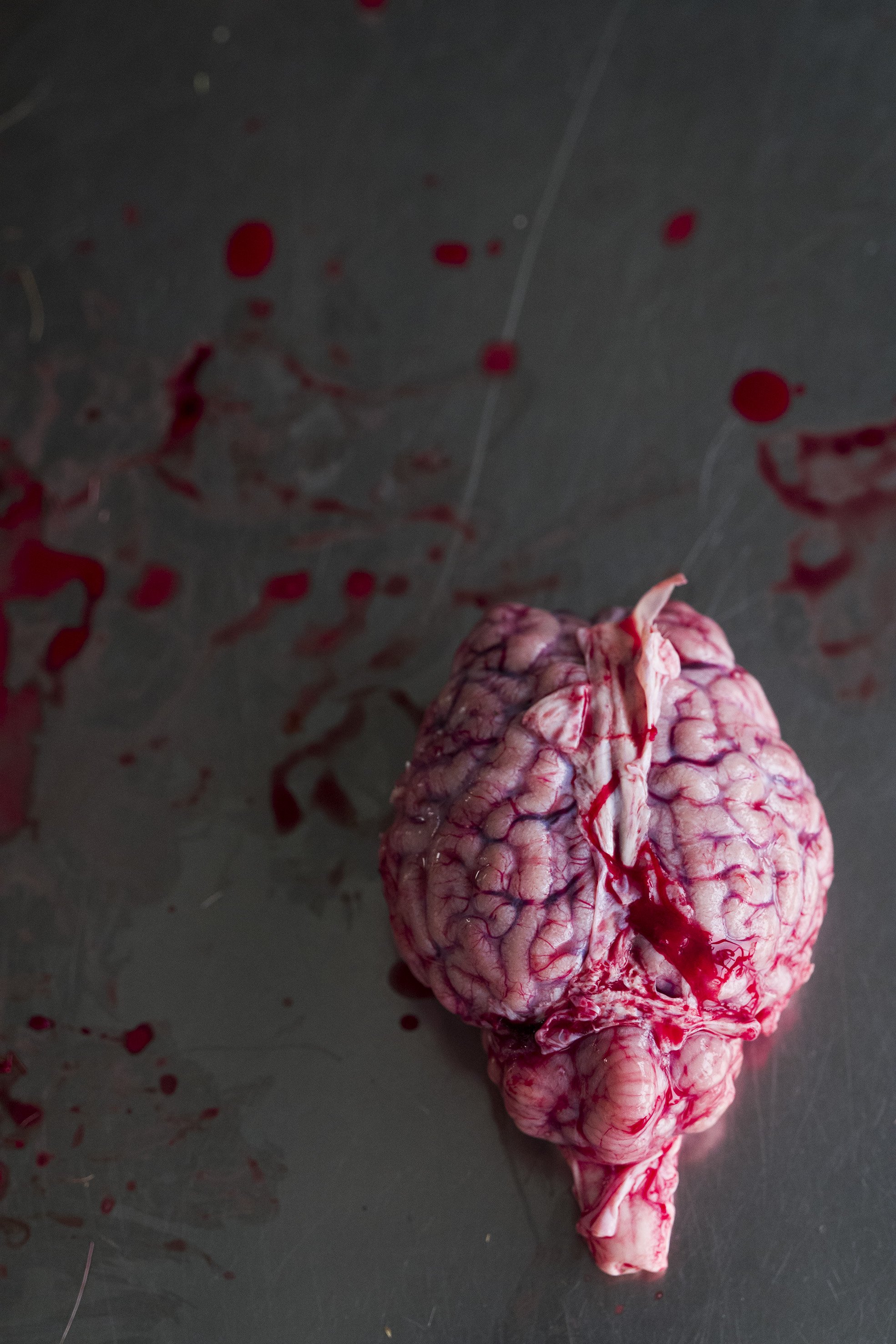

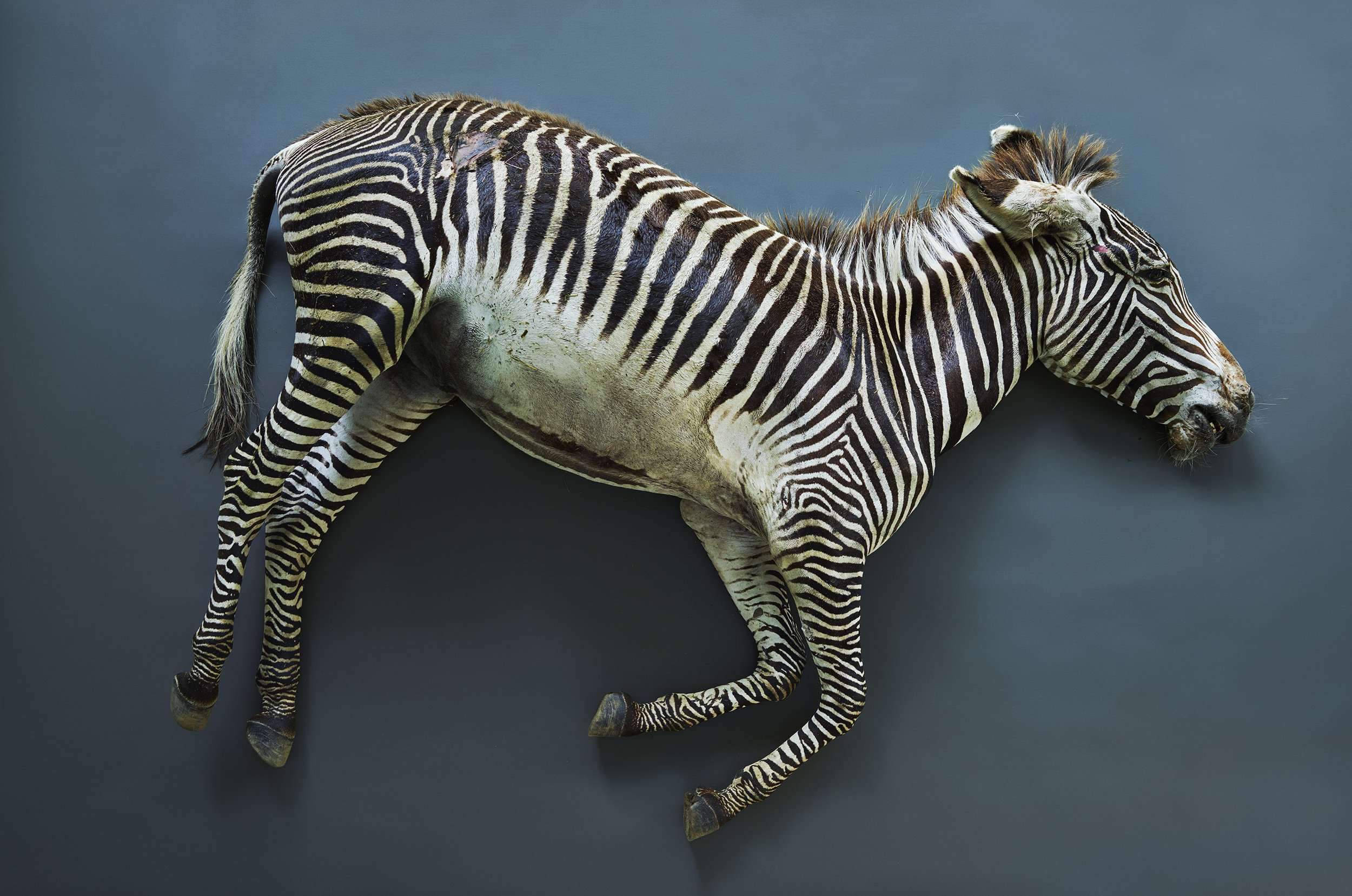
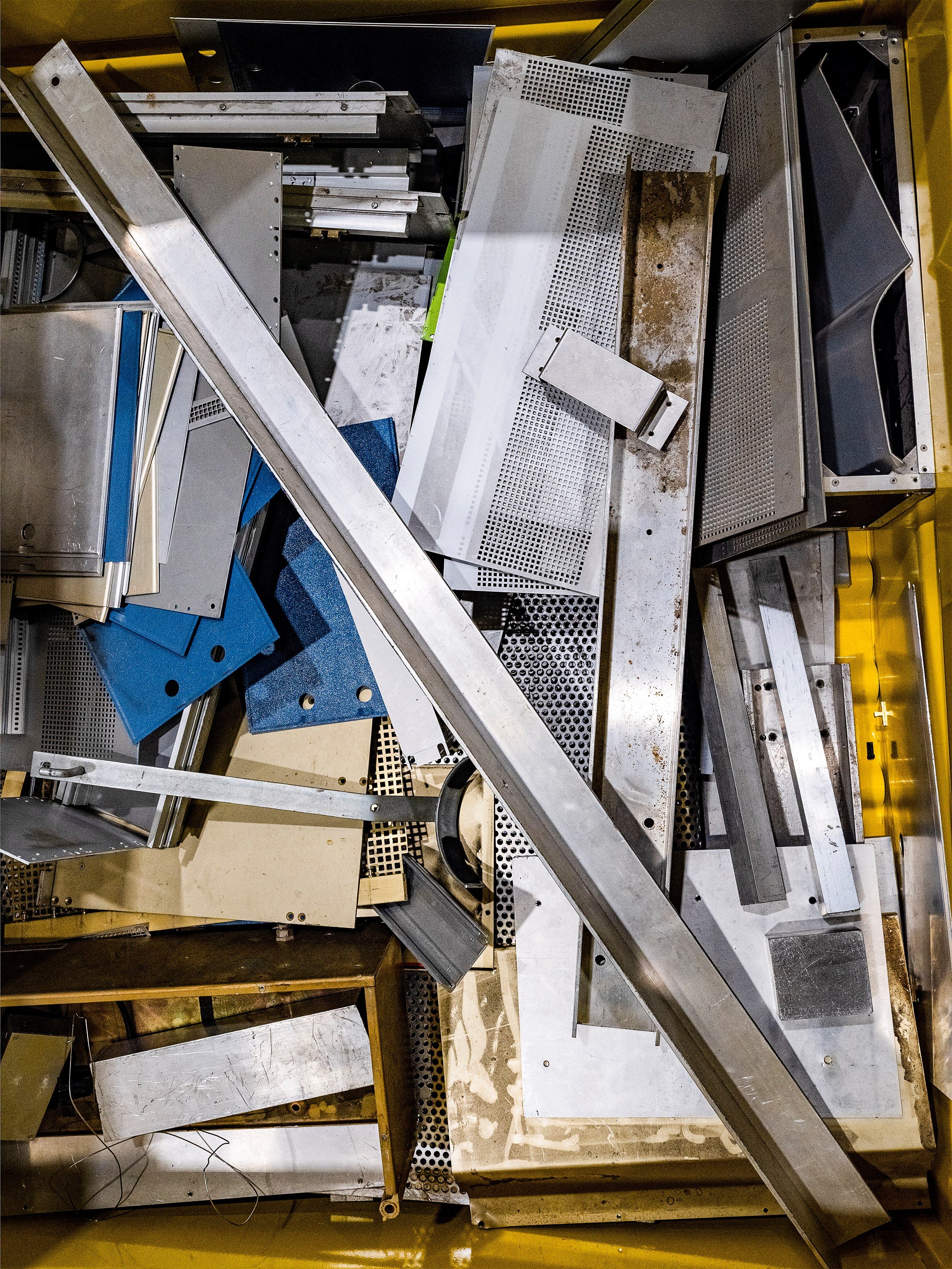

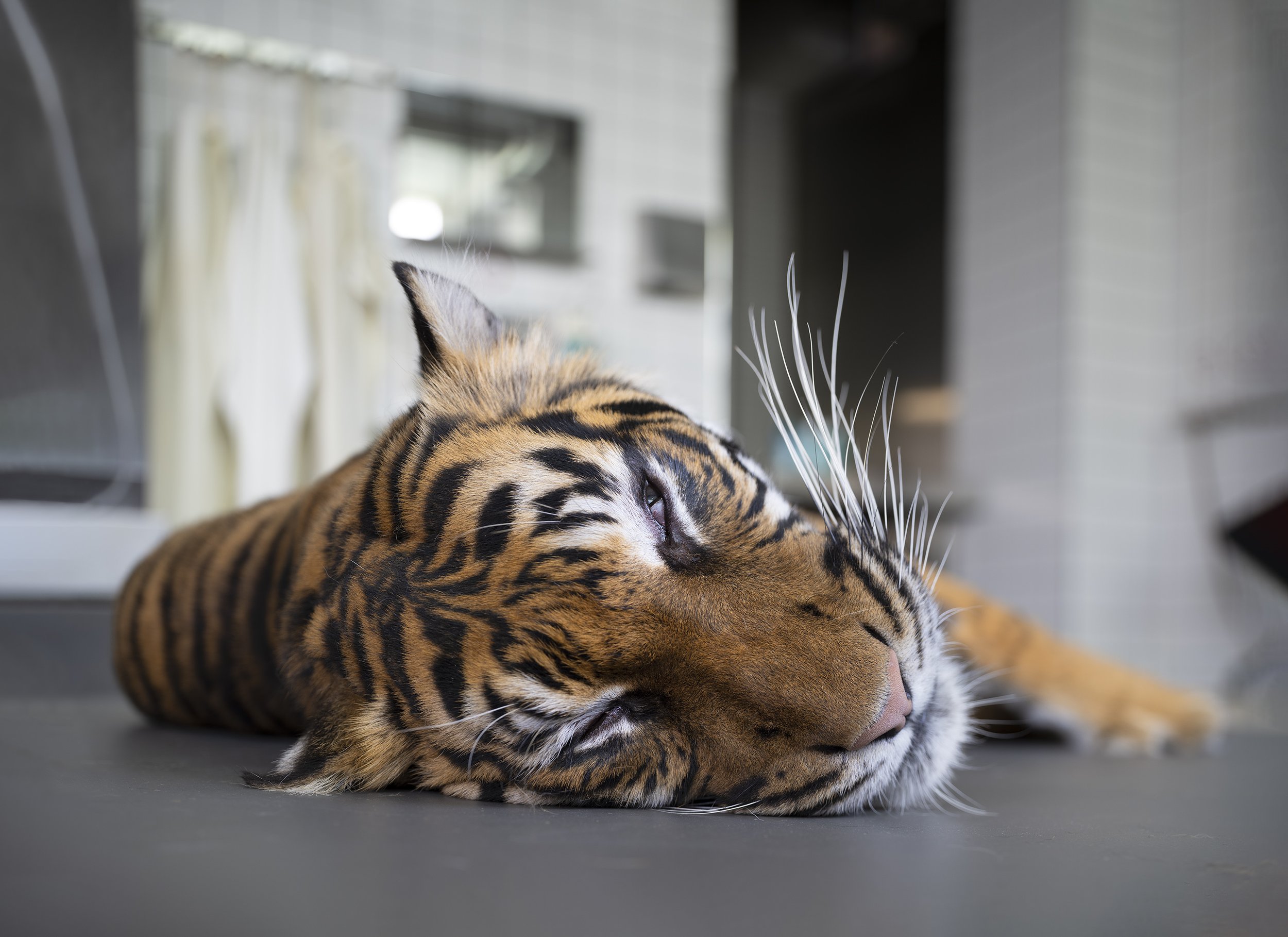

Struth's artworks are in the collections of the Art Institute of Chicago, the Centre Pompidou in Paris, the Dallas Museum of Art, the Hamburger Bahnhof in Berlin, the Kunsthaus Zürich, the Los Angeles County Museum of Art, the Metropolitan Museum of Art in New York, the Museum of Contemporary Art in Los Angeles, the Solomon R. Guggenheim Museum in New York, the Museum of Modern Art in New York, the Tate in London and the Walker Art Center in Minneapolis, among others.
The exhibit opened on May 25th and will be on view until July 26, 2024. The Gallery had a public opening on Saturday, May 25th, from 6 pm to 8 pm, with Thomas Struth. For more information about the exhibit, please visit the Marian Goodman Gallery’s site. The gallery can also be found on Instagram, YouTube, Facebook, and Artsy.
*Hover over the image to find the caption.
Tara Donovan: Stratagems
Tara Donovan: Stratagems 540 West 25th Street, New York, NY 10001 May 3 – August 16, 2024 Photography courtesy Pace Gallery
New York – Pace is pleased to present an exhibition of new work by Tara Donovan at its 540 West 25th Street gallery in New York. The exhibition opened May 3 and will be on view until August 16; the show, titled Stratagems, spotlights a group of sculptures made entirely of found, scavenged, and upcycled CD-ROM discs. Coinciding with Frieze New York, the artist’s presentation at the gallery was complemented by a Pace Live performance from choreographer Kim Brandt.



Known for her process- and system-based work across sculpture, installation, drawing, and printmaking, Donovan often explores the talismanic qualities of everyday materials and objects, from buttons, Styrofoam cups, pencils, and pins to readymade screens and Slinky toys. Drawing on the formal language of Minimalism and Postminimalism, Donovan’s works both use and mis-use such nontraditional materials, transforming them into visually dazzling compositions without obliterating their fundamental essences or histories as objects from everyday life. Through acts of accumulation, aggregation, and iteration, she transmutes her materials into shapeshifting works of art, which explore the possibilities—and limits—of human perception.












Tara Donovan: Stratagems 540 West 25th Street, New York, NY 10001 May 3 – August 16, 2024 Photography courtesy Pace Gallery
Marking her eleventh solo show with Pace, Stratagems will be the first exhibition dedicated to Donovan’s three- dimensional sculptures mounted in New York since 2021. Comprising 11 new sculptures, the show will be presented on the gallery’s seventh floor, which features floor-to-ceiling windows overlooking the Chelsea skyline. Built atop concrete pedestals, each of Donovan’s vertically-oriented sculptures is composed of stacks of CDs, varying in height from seven to ten feet tall. Breathing new life into the banal and outmoded medium of the compact disc, these works will be activated by the natural light that floods the gallery space. Depending on the time of day and the viewer’s perspective, a range of optical effects unfold across the refractive surfaces of the works. Mutable and seemingly alive, Donovan’s latest sculptures respond directly to the presence of the viewer’s body as it traverses space, reflecting her deep interest in the relationship between perceptual nuances and material transfigurations. At the same time, these works invite the viewer to contemplate the transformation of an obsolete medium—once used for the storage and transmission of digital information—into a prism for embodied experience.
Tara Donovan, Stratagem VI, 2024 SCULPTURE CDs 88" × 11-1/2" × 11-1/2" (223.5 cm ×29.2cm×29.2cm) No. 91444 © Tara Donovan, courtesy Pace Gallery
During Frieze week in New York, choreographer Kim Brandt staged a performance with six dancers amid Donovan’s exhibition at Pace. Presented by Pace Live—the gallery’s interdisciplinary platform for live art performances, musical acts, conversations, and other events—Brandt’s performance shared certain affinities with Donovan’s work and riff on the sculptures in the show, developing through an accumulation of scores that invited dancers to explore spiraling as generative movement. Brandt, who has previously presented her work at MoMA PS1 and SculptureCenter in New York, the Museum of Contemporary Art Chicago, and many other institutions, developed a practice that investigates the body as a dynamic material constantly negotiating context-specific relationships to time and space. Further details about her performance at the gallery will be announced in due course.
Tara Donovan, Stratagem X, 2024 SCULPTURE CDs 88"×17"×17"(223.5cm×43.2 cm × 43.2 cm) No. 91446 © Tara Donovan, courtesy Pace Gallery
Stratagems will open during the final days of When Forms Come Alive, a group show at the Hayward Gallery in London featuring Donovan’s work, was on view through May 6.
Portrait of Tara Donovan Courtesy Pace Gallery
For over 20 years, Tara Donovan (b. 1969, Flushing, New York) has created large-scale installations, sculptures and drawings that utilize everyday objects to explore the transformative effects of accumulation and aggregation. Known for her commitment to process, she has earned acclaim for her ability to exploit the inherent physical characteristics of an object in order to transform it into works that generate unique perceptual phenomena and atmospheric effects. Donovan’s many accolades include the prestigious MacArthur Foundation “Genius” Award (2008); and the first annual Calder Prize (2005), among others. For over a decade, numerous museums have mounted solo exhibitions of Donovan’s work including the Museum of Contemporary Art, San Diego (2004 and 2009); Saint Louis Art Museum, Missouri (2006); Metropolitan Museum of Art, New York (2007-08); Institute of Contemporary Art, Boston (2008); Indianapolis Museum of Art, Indiana (2010); the Milwaukee Art Museum, Illinois (2012); Louisiana Museum of Modern Art, Humlebæk, Denmark (2013), Arp Museum Bahnhof Rolandseck, Remagen, Germany (2014); Parrish Museum, Watermill, New York (2015); Jupiter Artland, Edinburgh, Scotland (2015); Museum of Contemporary Art Denver, Colorado (2018); and the Smart Museum of Art, University of Chicago, Illinois (2019). Her work is held in the collections of major institutions such as the Indianapolis Museum of Art, Indiana; Los Angeles County Museum of Art, California; the Metropolitan Museum of Art, New York; and the Whitney Museum of American Art, New York, among others. Pace Gallery has represented Donovan since 2005. The artist lives and works in Brooklyn, New York.
Pace is a leading international art gallery representing some of the most influential contemporary artists and estates from the past century, holding decades-long relationships with Alexander Calder, Jean Dubuffet, Barbara Hepworth, Agnes Martin, Louise Nevelson, and Mark Rothko. Pace enjoys a unique U.S. heritage spanning East and West coasts through its early support of artists central to the Abstract Expressionist and Light and Space movements.
Since its founding by Arne Glimcher in 1960, Pace has developed a distinguished legacy as an artist-first gallery that mounts seminal historical and contemporary exhibitions. Under the current leadership of CEO Marc Glimcher, Pace continues to support its artists and share their visionary work with audiences worldwide by remaining at the forefront of innovation. Now in its seventh decade, the gallery advances its mission through a robust global program— comprising exhibitions, artist projects, public installations, institutional collaborations, performances, and interdisciplinary projects. Pace has a legacy in art bookmaking and has published over five hundred titles in close collaboration with artists, with a focus on original scholarship and on introducing new voices to the art historical canon.
Today, Pace has seven locations worldwide, including European footholds in London and Geneva as well as Berlin, where the gallery established an office in 2023. Pace maintains two galleries in New York—its headquarters at 540 West 25th Street, which welcomed almost 120,000 visitors and programmed 20 shows in its first six months, and an adjacent 8,000 sq. ft. exhibition space at 510 West 25th Street. Pace’s long and pioneering history in California includes a gallery in Palo Alto, which was open from 2016 to 2022. Pace’s engagement with Silicon Valley’s technology industry has had a lasting impact on the gallery at a global level, accelerating its initiatives connecting art and technology as well as its work with experiential artists. Pace consolidated its West Coast activity through its flagship in Los Angeles, which opened in 2022. Pace was one of the first international galleries to establish outposts in Asia, where it operates permanent gallery spaces in Hong Kong and Seoul, along with an office and viewing room in Beijing. In spring 2024, Pace will open its first gallery space in Japan in Tokyo’s new Azabudai Hills development.
The exhibition opened on May 3 and will be on view until August 16, 2024, at Pace Gallery 510 West 25th Street in New York. For more information about this exhibition and others, please visit the Pace Gallery’s website here. Pace Gallery can be found on Instagram and Artsy, too.
Huong Dodinh: TRANSCENDENCE
Huong Dodinh: TRANSCENDENCE 540 West 25th Street, New York, NY 10001 May 3 – August 16, 2024 Photography courtesy Pace Gallery
New York – Pace is pleased to present an exhibition of new and historic works by Huong Dodinh at its 540 West 25th Street gallery in New York which opened on May 3rd and will close on August 16. Titled TRANSCENDENCE, the show, which marks the artist’s first-ever solo presentation in the US, brings together paintings and works on paper she has created over the course of her career, from the 1960s to the present day. Coinciding with the 2024 edition of Frieze New York, TRANSCENDENCE accompanied a new catalog from Pace Publishing, which was released during the exhibition.
Dodinh was born in Soc Trang, Vietnam in 1945. Forced to flee the country, her family sought refuge in Paris in 1953 after the outbreak of the First Indochina War. Dodinh has lived and worked in the French capital ever since, cultivating a solitary life in service of her artistic pursuits. Insulating herself from art market trends, she has maintained a commitment to authenticity, purity, contemplation, and truth in her work since she began painting in the 1960s.
Over the last six decades, Dodinh has devoted her practice to three central tenets—light, density, and transparency—through which she explores the fluidity of line, form, and negative space. By adopting a private and intensely regimented lifestyle, the artist has developed a distinctive way of making that blurs the boundaries between art and the everyday. Working alone and without any assistants in her Paris atelier, Dodinh takes personal ownership over every step in her process, from sourcing mineral powders for her pigments in Provence to mounting her canvases and applying her paint. Creating her own pigments and organic binders by hand, Dodinh applies thin layers of paint multiple times to forge transparent yet dense surfaces. Through her use of natural materials, she produces vibrant visual effects through absorptions and reflections of light in her elegant, minimalist compositions.






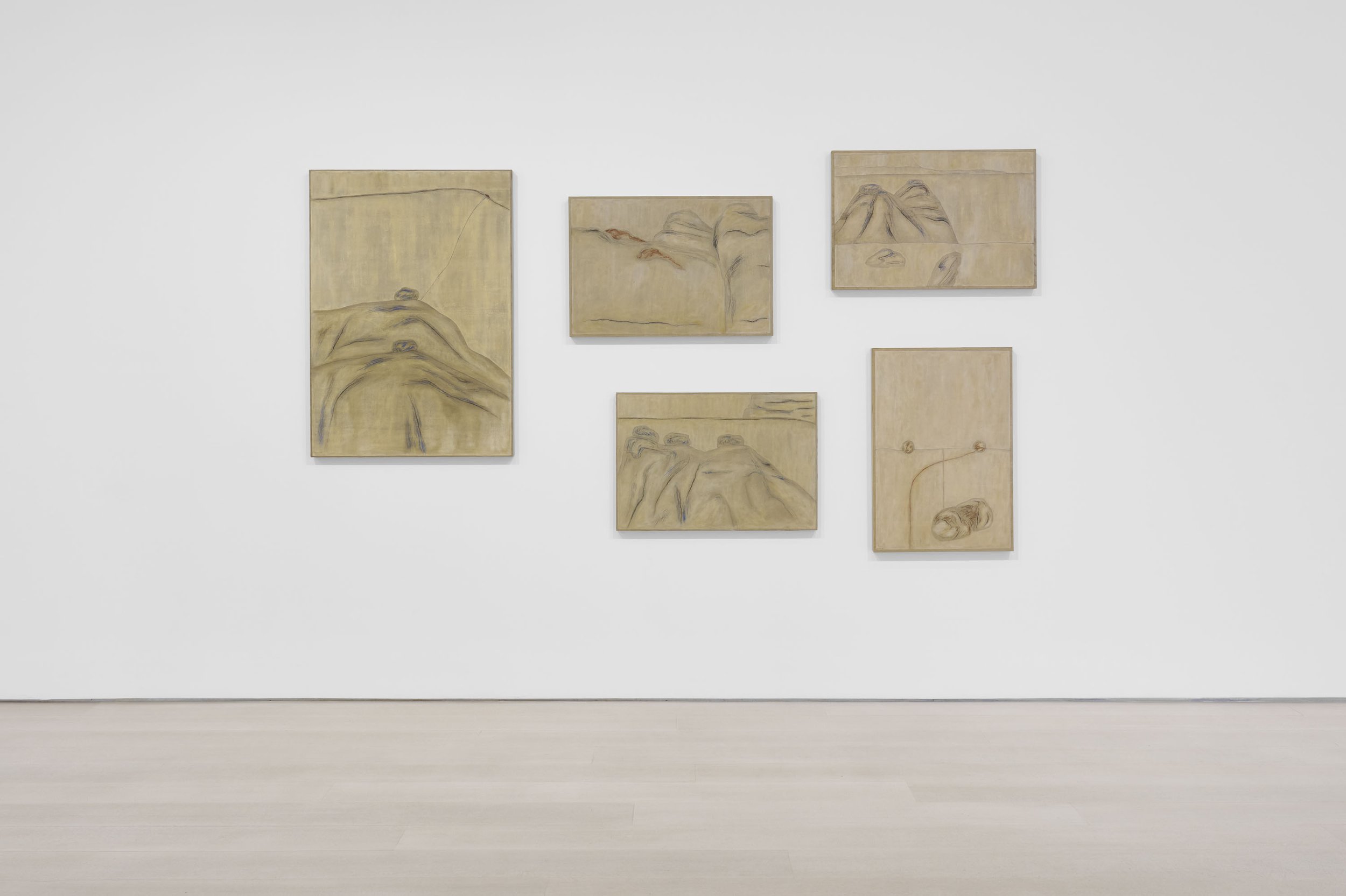
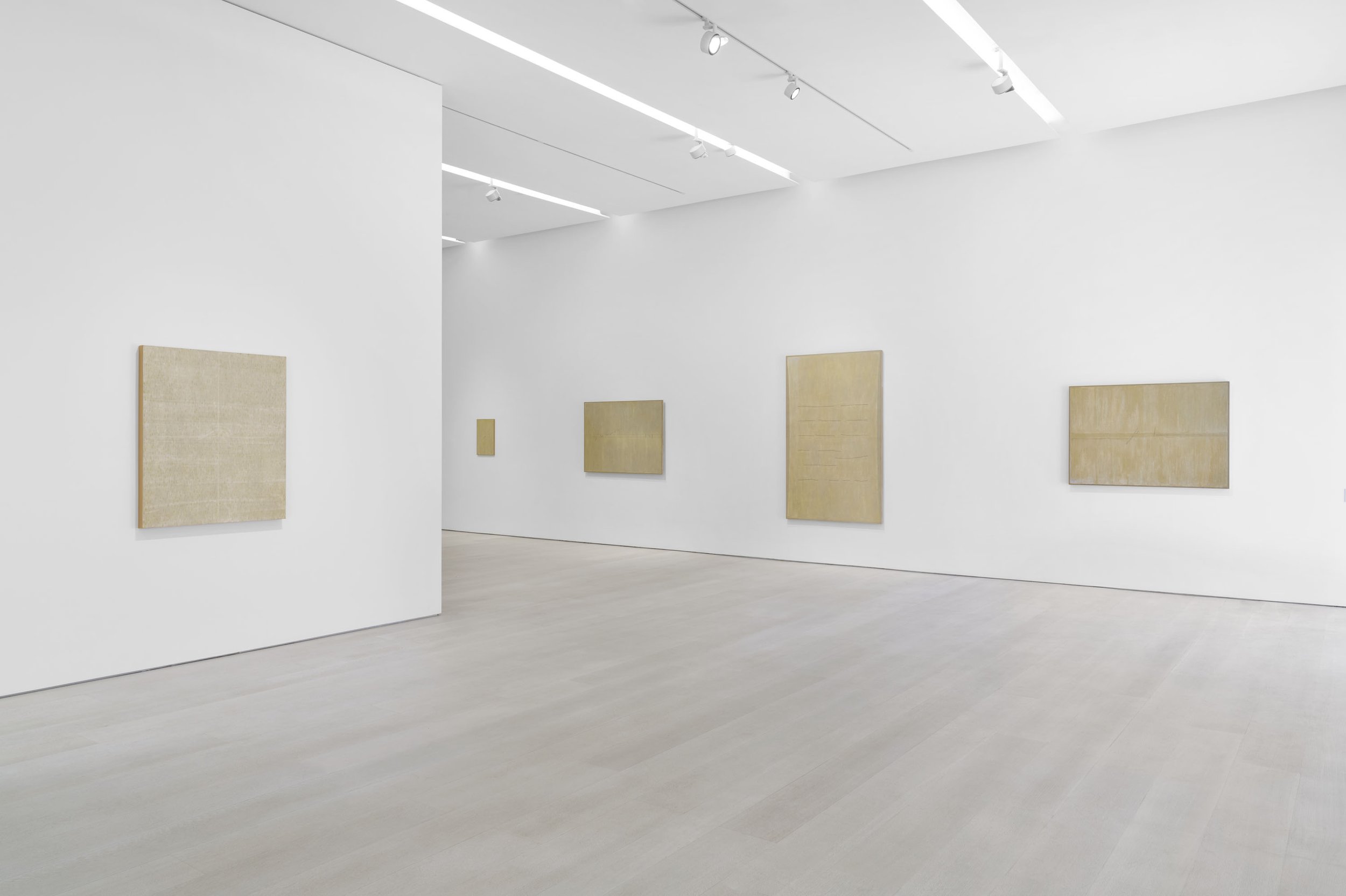
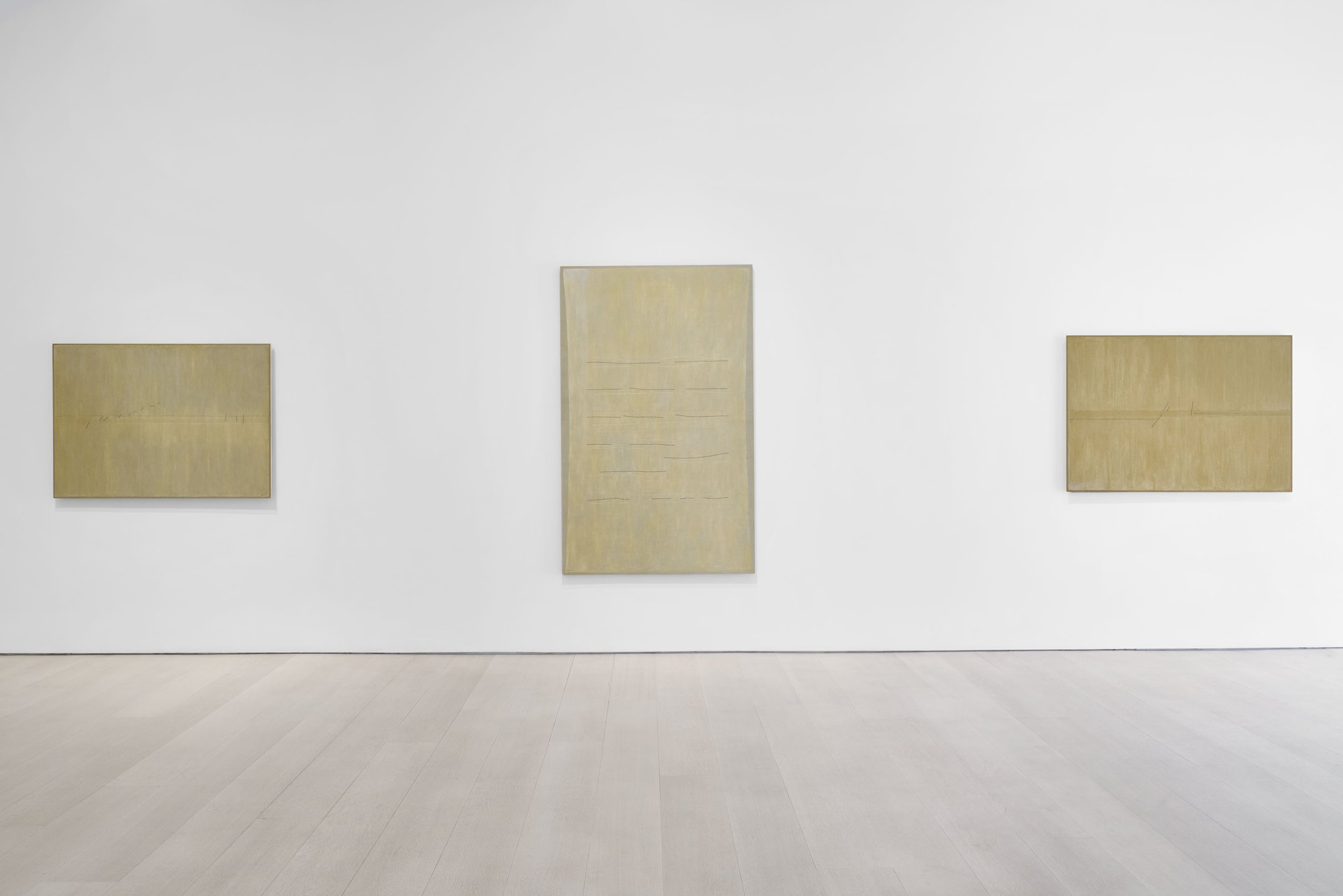
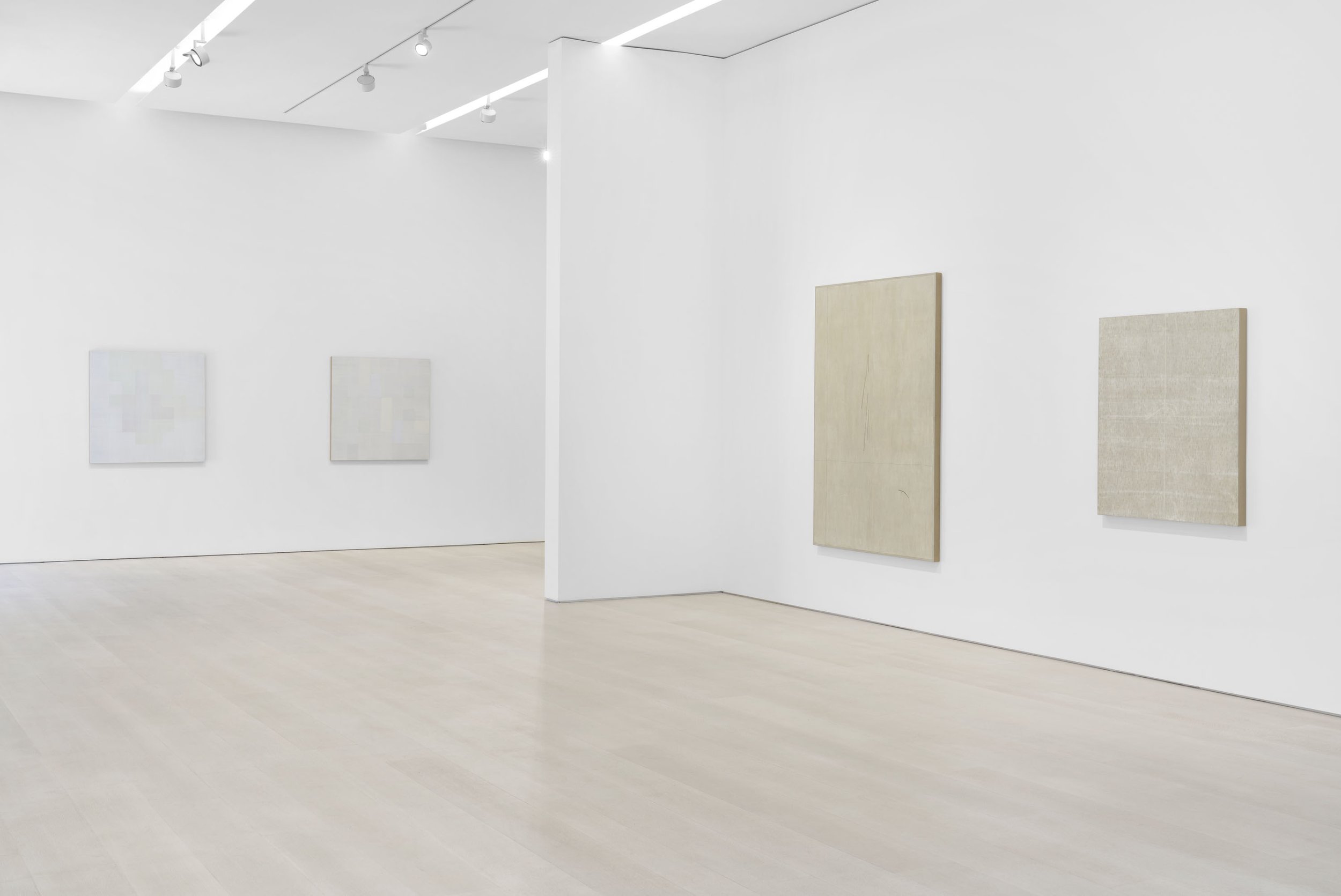


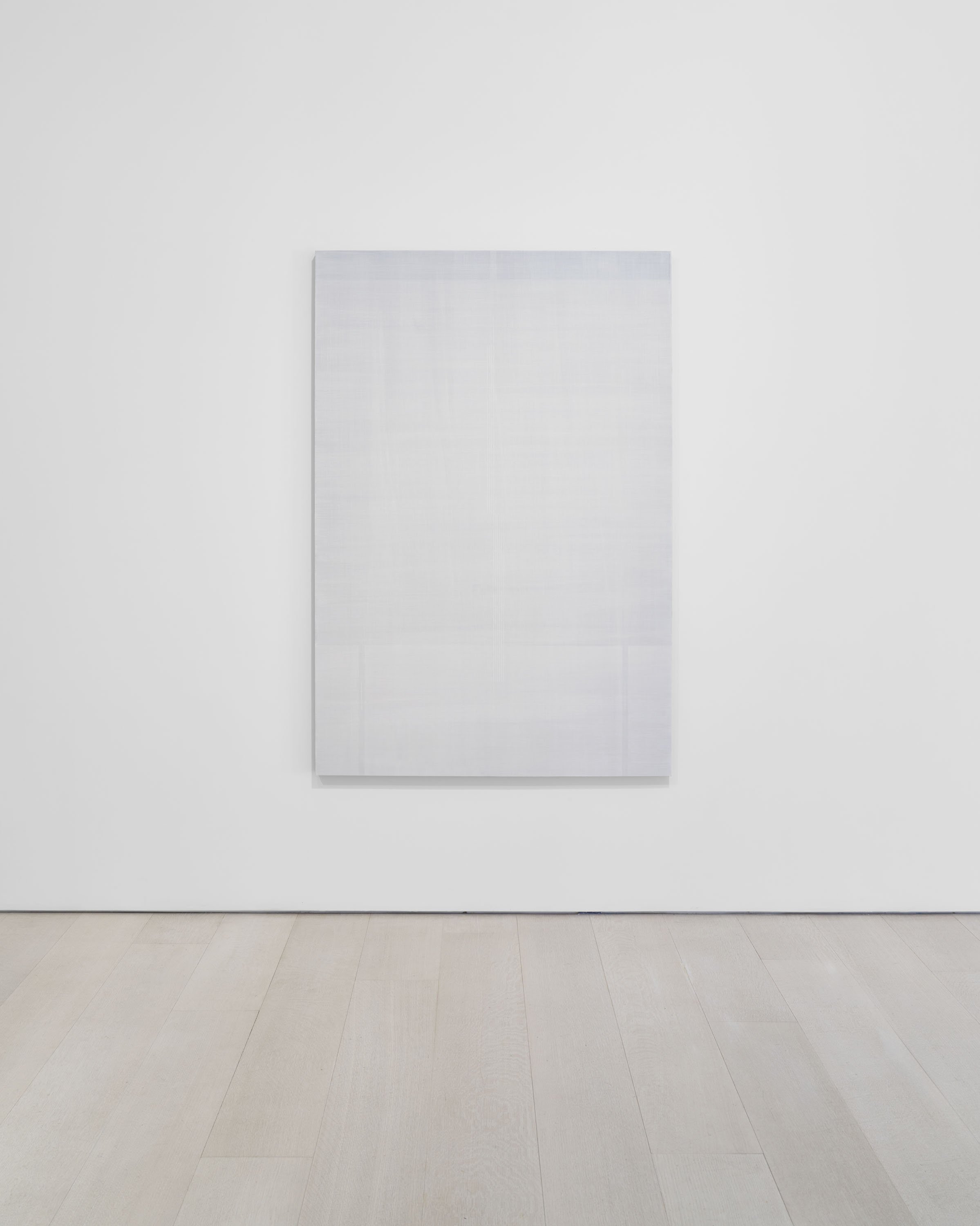
Huong Dodinh: TRANSCENDENCE 540 West 25th Street, New York, NY 10001 May 3– August 16 2024 Photography courtesy Pace Gallery
For the opening of her exhibition at Pace in May—which marks her second solo presentation with the gallery, following her show in Seoul last year—the artist traveled to New York for the first time in her life. Holistically, the nearly 30 paintings and works on paper that will figure in Dodinh’s debut New York exhibition speak to her longstanding interest in conveying ideas about silence, light, and pure feeling through a language of abstraction.
TRANSCENDENCE begins with a rare figurative scene that the artist made in 1966. Rendered in pastel, La Neige depicts, as its title suggests, a landscape of snow-covered houses and streets. Dodinh encountered snow for the first time when she emigrated from Vietnam to France, and, with this early composition, she explored her relationship to her new natural environment. In works from the following decades, when she leaned increasingly toward total abstraction, the artist continued to meditate on the ways that organic lines and shapes can reflect and represent the wonders of the natural world. Through her work, Dodinh strives to harmonize relationships and engage in a meaningful exchange with the world around her. As she has said, "Art is a process of opening oneself to others."
Recent exhibitions by the artist include her 2021 retrospective at the Guimet Museum in Paris and her solo presentation at the Museo Correr in Venice during the 2022 Venice Biennale.
Huong Dodinh (b. 1945, Soc Trang, Vietnam) was born in 1945 in Soc Trang, in the Mekong Delta, Vietnam. Dodinh and her family were forced to flee their war torn home in 1953 and sought refuge in Paris, where the artist continues to live and work today. At a boarding school in Rambouillet, Dodinh witnessed snow for the first time, marveling at the blending of land and sky. She calls this luminescent scene her artistic “epiphany” and it continues to inspire her painting. Dodinh studied at the prestigious École Nationale Supérieure de Beaux-Arts in Paris from 1965 to 1969, completing courses in a wide array of disciplines including engraving, lithography, frescoes, painting, and architecture. During this time, Dodinh was deeply affected by the violence of the Vietnam War and the uprisings of May 1968. After a three-year break, Dodinh was able to return to her artistic practice with a newfound sense of freedom. In the decades that followed, Dodinh dedicated herself to painting, occasionally exhibiting in Paris and often encountering fellow artists based in France such as Peter Matisse, Joan Mitchell, and Lisa de Kooning.
Dodinh is the recipient of several important awards and distinctions including, 1st Prize at the International Grand Prize for Painting in Cannes (1981), the Silver Cross of Merit and French Dedication (1996), and the Vice President Maison de la Culture d'Asie Orientale (1997). She presented a solo exhibition in 2021 at the Musée national des arts asiatiques - Guimet, and has participated in group presentations at FRAC de Champagne-Ardenne, Reims, as well as the major contemporary art exhibition Triptyque in Angers.
Pace is a leading international art gallery representing some of the most influential contemporary artists and estates from the past century, holding decades-long relationships with Alexander Calder, Jean Dubuffet, Barbara Hepworth, Agnes Martin, Louise Nevelson, and Mark Rothko. Pace enjoys a unique U.S. heritage spanning East and West coasts through its early support of artists central to the Abstract Expressionist and Light and Space movements.
Since its founding by Arne Glimcher in 1960, Pace has developed a distinguished legacy as an artist-first gallery that mounts seminal historical and contemporary exhibitions. Under the current leadership of CEO Marc Glimcher, Pace continues to support its artists and share their visionary work with audiences worldwide by remaining at the forefront of innovation. Now in its seventh decade, the gallery advances its mission through a robust global program— comprising exhibitions, artist projects, public installations, institutional collaborations, performances, and interdisciplinary projects. Pace has a legacy in art bookmaking and has published over five hundred titles in close collaboration with artists, with a focus on original scholarship and on introducing new voices to the art historical canon.
Today, Pace has seven locations worldwide, including European footholds in London and Geneva as well as Berlin, where the gallery established an office in 2023. Pace maintains two galleries in New York—its headquarters at 540 West 25th Street, which welcomed almost 120,000 visitors and programmed 20 shows in its first six months, and an adjacent 8,000 sq. ft. exhibition space at 510 West 25th Street. Pace’s long and pioneering history in California includes a gallery in Palo Alto, which was open from 2016 to 2022. Pace’s engagement with Silicon Valley’s technology industry has had a lasting impact on the gallery at a global level, accelerating its initiatives connecting art and technology as well as its work with experiential artists. Pace consolidated its West Coast activity through its flagship in Los Angeles, which opened in 2022. Pace was one of the first international galleries to establish outposts in Asia, where it operates permanent gallery spaces in Hong Kong and Seoul, along with an office and viewing room in Beijing. In spring 2024, Pace will open its first gallery space in Japan in Tokyo’s new Azabudai Hills development.
The exhibition opened on May 3rd and will be on view until August 16, 2024, at Pace Gallery 510 West 25th Street in New York. For more information about this exhibition and others, please visit the Pace Gallery’s website here. Pace Gallery can be found on Instagram and Artsy, too.
Joan Semmel : An Other View
Installation View: Joan Semmel, An Other View 25 April — 22 June 2024 courtesy Xavier Hufkens
Xavier Hufkens is pleased to present An Other View, American painter Joan Semmel (b.1932)’s inaugural exhibition with the gallery. The exhibition spans a period of five decades, showcasing the major developments in the artist’s oeuvre. The eight large-format oil paintings and two works on paper on display, created between 1971 and 2018, collectively attest to Semmel’s decades-long commitment to the representation of women, largely through the medium of her own body. The passage of time, permits the viewers to take an unvarnished look at natural ageing, as well as consider the socio- political engagement of ‘the personal is the political’ and the evolution of feminist issues across multiple decades, from the sexual liberation of the 70s to contemporary society’s veneration of youth.
Turning, 2018.
By adopting a resolutely non-objectifying stance — her own body as the subject— Semmel has created an oeuvre that not only challenges traditional representations of women but also explores themes such as identity, sexuality, and censorship. She does not consider her paintings to be self-portraits, but rather as touchstones: images that bring critical issues into focus, so that they can be confronted. While Semmel tends to work in series, the element that binds the oeuvre together— in addition to the focus on selfhood and self- representation — is the use of colour. Semmel’s approach to colouration is abstract, whereas her approach to figuration is unapologetically realistic.

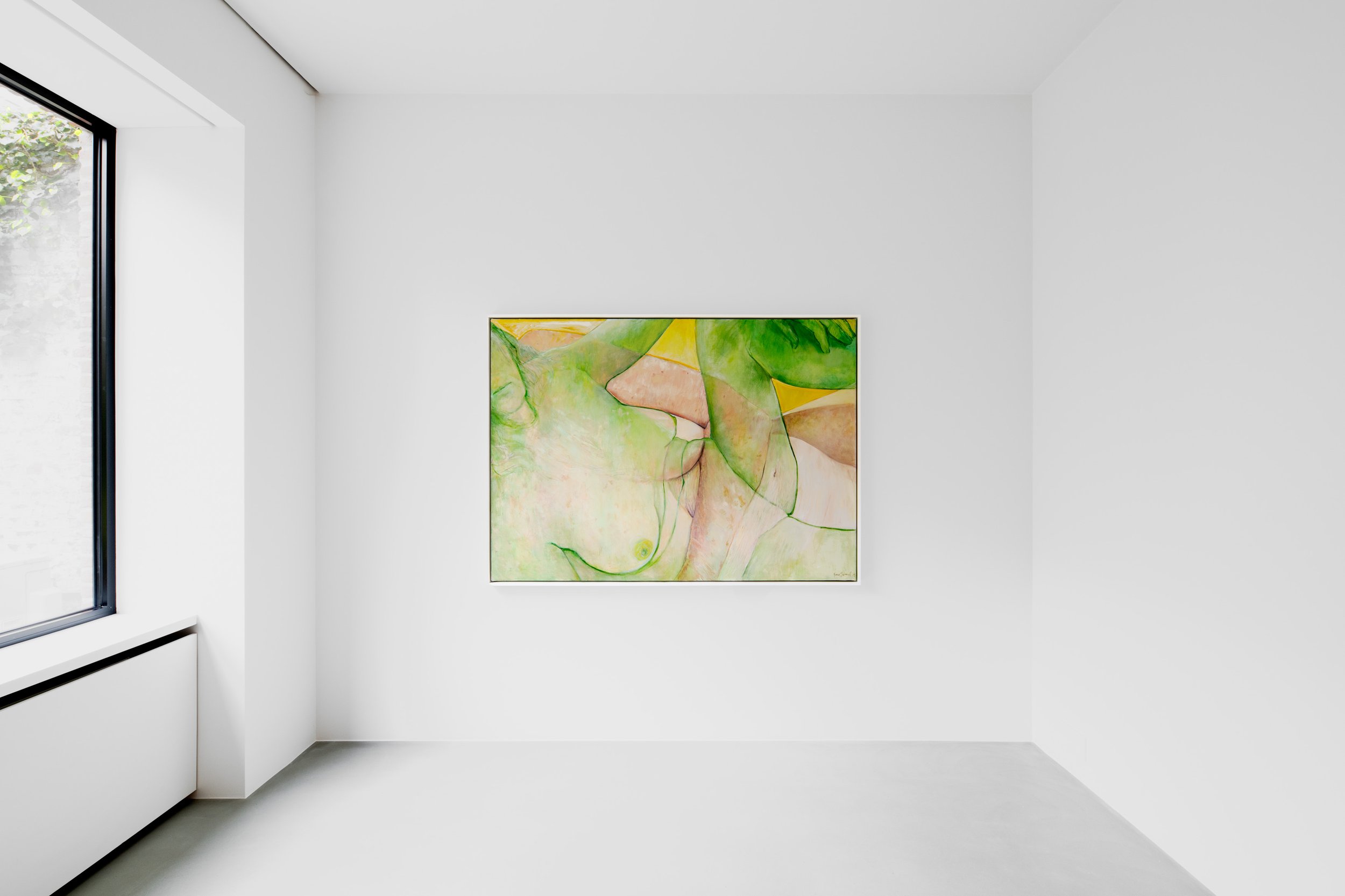
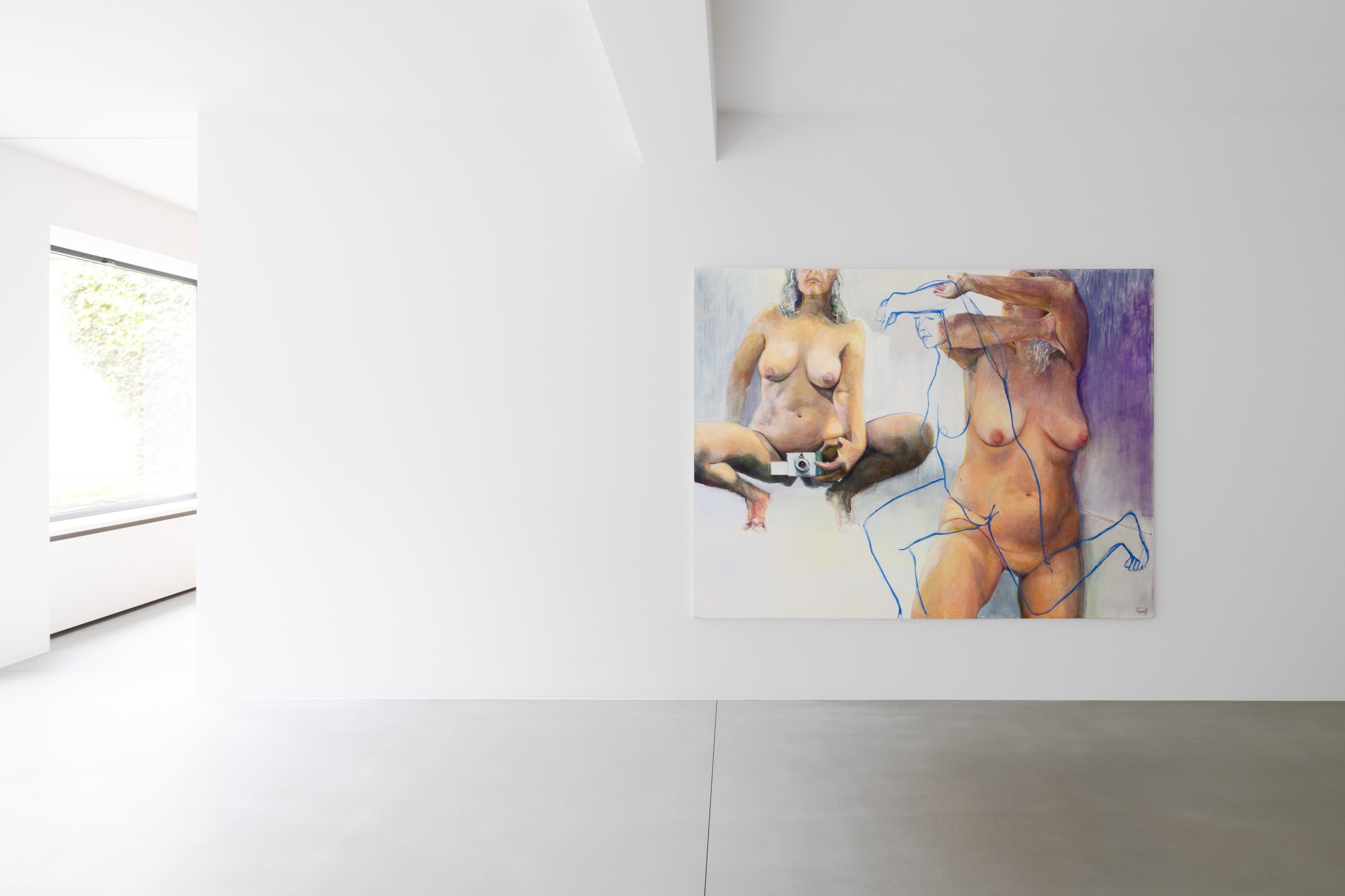
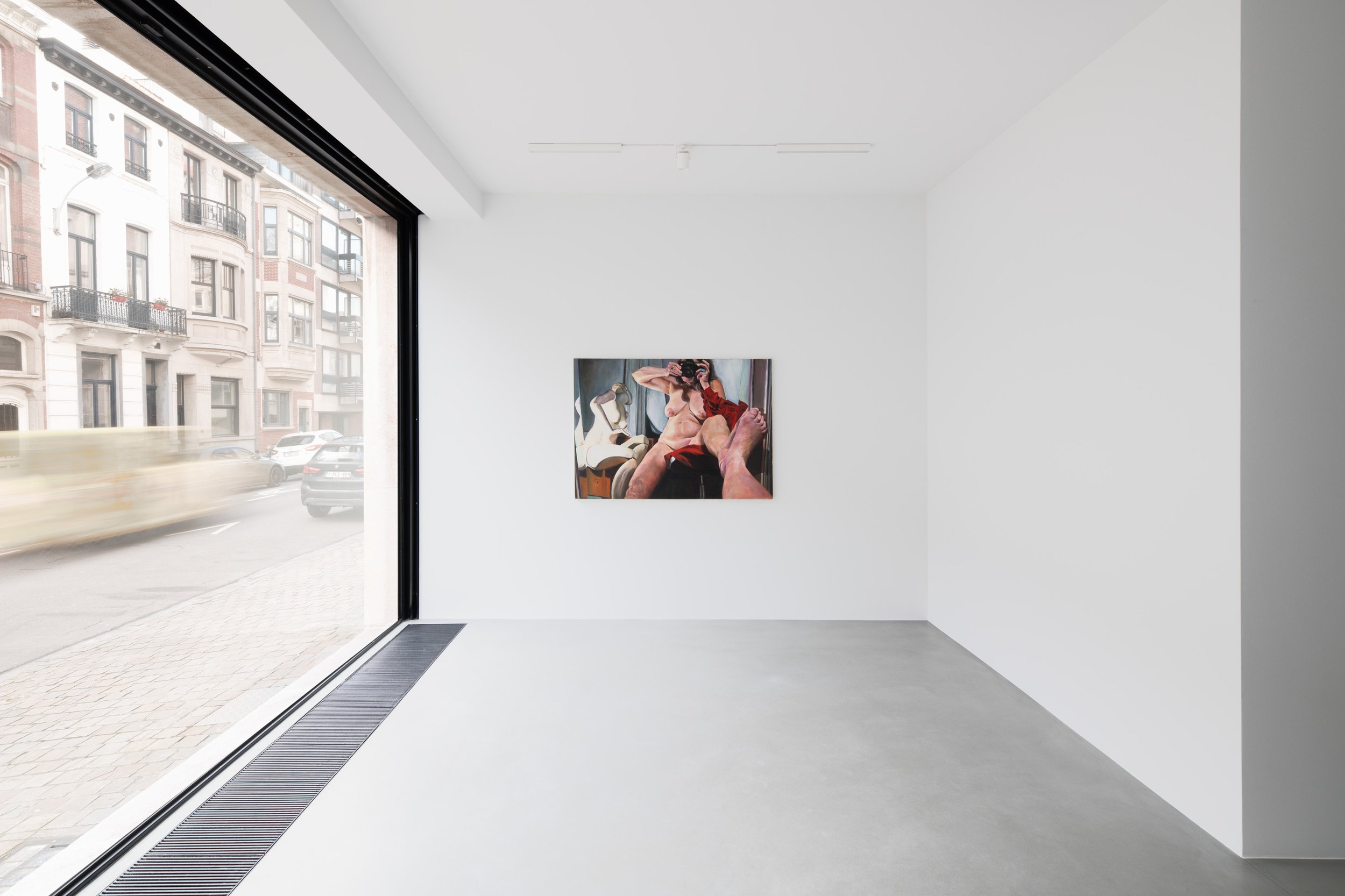
Installation View: Joan Semmel, An Other View 25 April — 22 June 2024 courtesy Xavier Hufkens
The earliest work in the exhibition is one of Semmel’s iconic sex paintings from 1971. Painted in reaction to the commercial exploitation of female bodies, Semmel sought to create an erotic visual language that would speak to women. Her belief that female repression begins in the sexual arena was another catalyst. Using the body as a structural form, and colours that betray her Abstract Expressionist roots, these pioneering works are intimate yet devoid of sentimentality. The contemporaneous Self-Image series, represented by two works on paper, mark a turning point in her practice: the beginning of the intense focus on her own body. A key aim was to challenge the male gaze in Western painting and popular culture. Hence her decision to become both observer and subject in her work, transcending the traditional themes of vulnerability and seduction. Crucially, she opted to paint her body from her own point of view, both in a literal and figurative sense. This is clear in a work like Weathered (2018): the viewer observes the female body from within the frame, so to speak, as if looking through the eyes of the artist.
Yellow Sky, 2015
Works such as Baroque (2002) and Disappearing (2006) highlight important devices in Semmel’s work: mannequins, mirrors and cameras. Each object has a clear purpose. Baroque features a discarded mannequin, which Semmel found on the streets of New York. The painting is a dark critique on consumer culture and, in her own words “the mass production of the desirable female image”. The lifeless forms allude to the cult of youth and how women can be ‘discarded’ once they reach a certain age. On the other hand, mirrors and cameras, which are also featured in Baroque, have an empowering function. Semmel points the camera at a mirror to take a self- portrait but, via the reflection, simultaneously trains it on the viewer. A tripling of the female body — real (the foot on the glass), artificial (mannequin) and illusory (reflection)— but also a reversal of the female gaze: through the camera, the viewer also becomes a subject of the work. A painting about looking and being looked at. The mirror alludes to the artificiality of images and the construction of identity, but also to art itself: paintings and photographs are illusions, never the reality. Disappearing, which is based on a photograph, is noteworthy for replicating the blur of the original image in pigments, thereby creating a sense of movement.
Joan Semmel’s work invites viewers to reconsider the ways in which women’s bodies are perceived and represented in art, in society, and in contemporary culture. Says the artist: “Reimagining the nude without objectifying the person, using my own body, made it clear that the artist was female and undercut the stereotypes of the male artist and the female muse. I wanted to subvert that tradition from within.”
Photo Credit : Taylor Miller (2019)
Joan Semmel (b. 1932, New York) lives and works in New York and East Hampton. She was recently the subject of a large-scale retrospective Skin in the Game that opened at the Pennsylvania Academy of the Fine Arts in 2021 and toured to the Herbert F. Johnson Museum of Art, Cornell University, Ithaca, in 2022. She presented A Lucid Eye at the Bronx Museum of the Arts, New York, in 2013. Public collections include the Art Institute of Chicago, IL; Brooklyn Museum, NY; The Museum of Modern Art, NY; Tate, London, United Kingdom; and Whitney Museum of American Art, NY, among others.
For more information about this exhibition and others, please visit Xavier Hufken’s site here. The gallery can also be found on Instagram, Facebook, and YouTube.
ABDOULAYE KONATÉ : L’âme des signes/The Soul of Signs
Toutes les images / All images : Courtesy the artist and Templon, Paris —Brussels — New York
Malian artist Abdoulaye Konaté is exhibiting his work for the very first time at Galerie Templon. The gallery’s Brussels space is hosting the L’Ame des Signes/The Soul of Signs exhibition, a brand new series of eight textile pieces.
Abdoulaye Konaté, known as the Master, was born in 1953 in Diré, Mali. He is a leading figure on the African contemporary art scene. In the 1990s, he swapped canvas and brushes for needle and thread as fabric developed into his favourite medium. His work combines Western modernism with African symbolism, addressing social and political issues such as religious fanaticism and social justice with a complex and shimmering palette that has become his signature over the years.
Toutes les images / All images : Courtesy the artist and Templon, Paris —Brussels — New York
The Soul of Signs exhibition covers the gallery walls in majestic hand-embroidered canvases. The artist creates them using offcuts of African Bazin fabric which he dyes then rearranges in entrancing shaded tones, from fiery red to midnight blue, emerald green to golden yellow. "Nature is an endless source of colour inspiration to me," explains the artist. "A butterfly, a bird, a chameleon or a starry sky inspire me every day to come up with new pigments."
Konaté uses fine thread to embroider mysterious linguistic symbols on his multi-hued canvases. He finds the symbols during his travels, on the rim of 16th-century Tunisian ceramics, for instance, or at the heart of Berber art museums. “These marks have their own soul because they bear within them the heritage of a culture,” explains the artist. “Today’s generations have a duty to ensure that not everything is forgotten, to make use of these keys to our past and adapt them to contemporary society.”
Toutes les images / All images : Courtesy the artist and Templon, Paris —Brussels — New York
Born in 1953 in Diré, Mali, Konaté lives and works in Bamako. He is a visual artist and major figure on the contemporary art scene of his country and the African continent. After graduating from the Institut National des Arts of Bamako in 1976, he studied at the Instituto Superior de Arte in Havana, Cuba, from 1978 to 1985. He headed the Exhibitions Division at the Musée National du Mali from 1985 to 1997 before taking charge of the Palais de la Culture in Bamako and Rencontres Photographiques de Bamako from 1998 to 2002. He then took up the post of head of the Conservatoire des Arts et Métiers Multimédia "Balla Fasseké Kouyaté" in Bamako, Mali.
Toutes les images / All images : Courtesy the artist and Templon, Paris —Brussels — New York
His work has been shown in numerous solo exhibitions, including at the Espace Dominique Bagouet in Montpellier (2021), Zeitz MOCAA in Cape Town (2020), Fondation CDG in Rabat, Morocco (2017), Arken Museum of Modern Art, Copenhagen(2016), Fondation Festival sur le Niger in Mali (2012), Galerie Nationale d’Art in Dakar (2011), Biennale d’Art Contemporain in Dakar (2010), Forum für Kunst in Germany (2009), Musée National du Mali in Bamako (1992), and Musée de l’IFAN in Senegal (1992). He has been invited to take part in a wide range of group exhibitions, such as at La Villette in Paris (2017), 57th Venice Biennale (2017), Biennale d’Art Contemporain in Dakar (2016), Norrköping Konstmuseum in Sweden (2015), National Museum of African Art, Smithsonian Institute in the USA (2013), Musée d’Art Moderne de la Ville de Paris (2013), Stedelijk Museum in the Netherlands (2012), Institut du Monde Arabe in Paris (2011), Bienal de La Habana in Cuba (2009), Gwangju Biennale in South Korea (2008), Documenta – Kassel in Germany (2007), and Palais des Beaux-Arts in Brussels (2003).
His work features in public collections at institutions including the Metropolitan Museum of Art in the USA, Smithsonian Museum in the USA, Stedelijk Museum in the Netherlands and D’ak’art, Biennale de l’Art Africain Contemporain in Senegal.
For more information about Abdoulaye’s artwork and his exhibition, please visit Templon’s site. The gallery can also be found on Instagram, artnet, Facebook, YouTube, and Artsy.
EDI RAMA
Courtesy of Marian Goodman Gallery
“Politics is the battle of everyday life. And art is like a prayer.” – Edi Rama
Marian Goodman Gallery is pleased to present a new solo exhibition by Edi Rama, artist and current Prime Minister of Albania. This first major monographic exhibition in Paris, where Rama lived in the 1990s, offers a panorama of his artistic practice through drawings on paper, printed wallpaper, ceramic sculptures and a hand-embroidered folding screen. The ensemble, the result of an unprecedented creative process, underscores the artist's close relationship with color. Color has been essential to Rama, both in his political career and in his artistic practice, for its ability to convey elements of the psyche but also for its potential to change our perceptions and invigorate dialogue between individuals.
EDI RAMA Untitled, 2024 Ceramic 25 5/8 x 28 3/8 x 25 5/8 in. (65 x 72 x 65 cm) Photo credit: Rebecca Fanuele © Edi Rama Courtesy of the artist and Marian Goodman Gallery
For Rama, drawing stems from a “need to find a balance between the inner gaze and outer gaze.” In the spirit of automatic drawings which focus on the unconscious mind, and to improve his concentration and listening skills, Rama draws during meetings and telephone calls in his ministerial office. “The only thing I know is that they are part of my working time. It is about working and it is like something inside me that is trying to escape the working frame.” Once completed, the drawings, which have become emblematic of his oeuvre, consist of complex compositions, made of bright colors partially covering A4 printed notes or daily appointment schedules.
The presence of hundreds of colored markers on his official desk dates back to the time when, as the Mayor of Tirana, he launched the ambitious project of repainting the city's facades of social housing in vivid colors. This initiative, documented by his long-time friend Anri Sala in his video Dammi i colori (2003), was intended not only to beautify the city, but also to revitalize the community; by using color as a means for social impact, Rama wanted to create a sense of belonging and communication with the inhabitants. “I do not think there is another city in Europe, be it the richest, where people discuss so passionately and collectively about colors. The hottest discussion in the coffee bars, in homes, in the streets was what the colors were doing to us,” explains Edi Rama in the 2003 video.








When Rama started drawing in his ministerial office, he also decided to display his colorful works as well as incorporating them as motifs for a wallpaper on site. The immersive installation that comprises Rama's office has been transposed to the first space of the exhibition, with a newly-designed wallpaper. Large polychromatic ceramic sculptures, which seem to embody the three-dimensional translation of his works on paper, are presented on custom-made pedestals. Conceived as ronde-bosse, that play with color, texture and shape, they invite the viewer to examine them from multiple angles. Extravagant and atypical at the same time, each resemble an architecture of whimsy and ingenuity.
EDI RAMA Untitled, 2024 Paravent, printed fabric, embroidery, ceramic and bronze sculpture 64 3/4 x 71 5/8 x 2 in. (164.5 x 182 x 5 cm) Photo credit: Rebecca Fanuele © Edi Rama Courtesy of the artist and Marian Goodman Gallery
For the first time, Rama also includes in its exhibition a folding screen on which his multicolored drawings are hand-embroidered, combined with a composition inspired by X-rays of the famous cycle The Battle of San Romano painted by Florentine Renaissance artist Paolo Uccello in the early 1440s.
EDI RAMA Untitled, 2023 Mixed media on paper 7 7/8 x 11 3/4 in. (20 x 30 cm) Photo credit: Rebecca Fanuele © Edi Rama Courtesy of the artist and Marian Goodman Gallery
The second space of the exhibition is imbued with the atmosphere of the studio where he models, paints and fires his ceramic pieces. Unlike his drawings, Rama's ceramics are made in his spare time in a studio outside the Kryeministria. Since his very first set of works, exhibited in 2016 in our New York gallery, the artist has deepened his knowledge and technique of ceramics, as evidenced by new small wall sculptures in glazed ceramic, pieces combining ceramic and bronze, and those composed from multiple fragments.
Born in 1964, Edi Rama lives and works in Tirana. A former professor of painting at the Tirana Academy of Fine Arts and a former player on the national basketball team, he is also the author of several books. He has served as Prime Minister of Albania since 2013. Alongside his political career, which began in 1998, Rama regularly exhibits his work, which has been the subject of several solo shows, most recently Improvisations, Zappeion, Athens, Greece (2023) and Edi Rama: Work, which traveled from Kunsthalle Rostock, Germany (2028) to the Nevada Museum of Art, Ren (2019)
EDI RAMA Untitled (Paris), 2024 (DETAIL) Archival pigment inkjet on 11 mil, latex based, nylon reinforced wallpaper installation Dimensions variable Photo credit: Rebecca Fanuele © Edi Rama Courtesy of the artist and Marian Goodman Gallery
Rama took part in Viva Arte Viva, the 57th Venice International Art Biennale in 2017. He has also exhibited his work at numerous institutions, including the New Museum in New York (2016), the Musée d'art contemporain de Montréal (2011), the MNAM - Centre Pompidou in Paris (2010), and Rama took part in Viva Arte Viva, the 57th Venice International Art Biennale in 2017. He has also exhibited his work at numerous institutions, including the New Museum in New York (2016), the Musée d'art contemporain de Montréal (2011), the MNAM - Centre Pompidou in Paris (2010) and the Haus der Kunst in Munich (2004).






Exhibition view: Edi Rama, Galerie Marian Goodman Paris 8 June – 26 July 2024 Photo credit: Rebecca Fanuele © Edi Rama and Marian Goodman Gallery Courtesy of the artist and Marian Goodman Gallery
There was an opening reception on Saturday, June 8th, from 6 to 8 p.m., at 66 rue de Temple in Paris. The exhibition will close on July 26th of this year. For more information about the exhibit, please visit the Marian Goodman Gallery’s site. The gallery can also be found on Instagram, YouTube, Facebook, and Artsy.
*Hover over the image to find the caption.
Craft Front & Center: Conversation Pieces
Installation view of Craft Front & Center: Conversation Pieces at the Museum of Arts and Design, New York Photo by Jenna Bascom; courtesy the Museum of Arts and Design. Image dimensions: 2048px x 1366px
Craft Front & Center: Conversation opened on June 1 2024. Each Piece explores craft’s collaborative approach to learning and working by placing pioneering twentieth-century craft artists into dialogue with twenty-first century artists who are rethinking craft techniques and materials. Showcasing MAD’s permanent collection, the exhibition brings together more than sixty historic, recently acquired, and commissioned works in a range of artistic media; most prominently, the central craft materials of ceramic, glass, and fiber. “While all art hinges on the exchange of ideas, craft-based art is particularly dependent on the relationships between artists,” said Alexandra Schwartz, MAD’s Curator of Modern & Contemporary Art, Design & Craft. “Techniques such as weaving, blowing glass, or throwing pots are skills that must be taught. As a result, artists who use craft techniques tend to be especially attuned to craft traditions—and invested in upending them.”
Gertrud Natzler and Otto Natzler Bowl (H814), 1957. Photographer: Photo: Ed Watkins. Image dimensions: 4585px x 5307px
Three overlapping thematic sections illuminate how craft’s collaborative approach to learning and working informs creative practices. The “Teachers and Students” section presents works by artist educators alongside works by their pupils. Notable pedagogic relationships represented include California College of Arts and Crafts faculty Trude Guermonprez and her mentee Kay Sekimachi, University of California, Berkeley faculty Paul Voulkos and students Jun Kaneko and Mary Ann Unger, and Cranbrook Academy of Art’s Maija Grotell, who trained Toshiko Takaezu and Katherine Choy. The section also includes artists who studied together at the same academies and workshops, many of whom went on to work together and influence one another throughout their career, such as Bauhaus alumni Marguerite Friedländer-Wildenhain and Anni Albers.
Claire Zeisler Red Wednesday, 1967. Photographer: Eva Heyd Image dimensions: 4347px x 5764px
The “Collaborations” section provides an expansive view of artistic partnerships. Founders of the artist collective AYDO Studio, A young Yu and Nicholas Oh create multimedia projects that explore their Korean American heritage and incorporate Korea’s craft traditions, often in audacious and unexpected ways. Designer Pedro Barrail works with a team of indigenous craftspeople in Paraguay to produce furniture that challenges perceived divisions between ancient craft techniques and contemporary design. Composing a stoneware portrait of her own mother inspired by a carved ivory likeness of a sixteenth-century German aristocrat, artist Rachelle Dang forms a collaboration with the ivory’s unnamed artist.
Installation view of Craft Front & Center: Conversation Pieces at the Museum of Arts and Design, New York Photo by Jenna Bascom; courtesy the Museum of Arts and Design. Image dimensions: 2048px x 1366px
The “Generational Dialogues” section examines how the creative resonances of the studio craft movement continue to influence artists and designers today. It includes experimental works of fiber art created by Sheila Hicks and Claire Zeisler and artists who continue to push the boundaries of the medium, such as Vadis Turner and Kira Dominguez Hultgren. To further explore the significance of dialogue among artists, MAD asked ceramic artists Marie Herwald Hermann and Anders Herwald Ruhwald, who share a studio in Chicago, to collaboratively select works from the permanent collection to be shown alongside their own. Hermann’s works, created specifically for the exhibition, directly reference the works of Ruth Duckworth. Ruhwald apprenticed with Jun Kaneko and his works on view were influenced by his mentor.
EXHIBITION CREDITS
Craft Front & Center has been made possible by a major grant from the National Endowment for the Humanities and Museum of Arts and Design together: Democracy demands wisdom. The exhibition is also supported, in part, by public funds from the New York City Department of Cultural Affairs in partnership with the City Council and the New York State Council on the Arts with the support of the Office of the Governor and the New York State Legislature. Research was supported by a Craft Research Fund grant from the Center for Craft. Additional support from The Gladys Krieble Delmas Foundation.
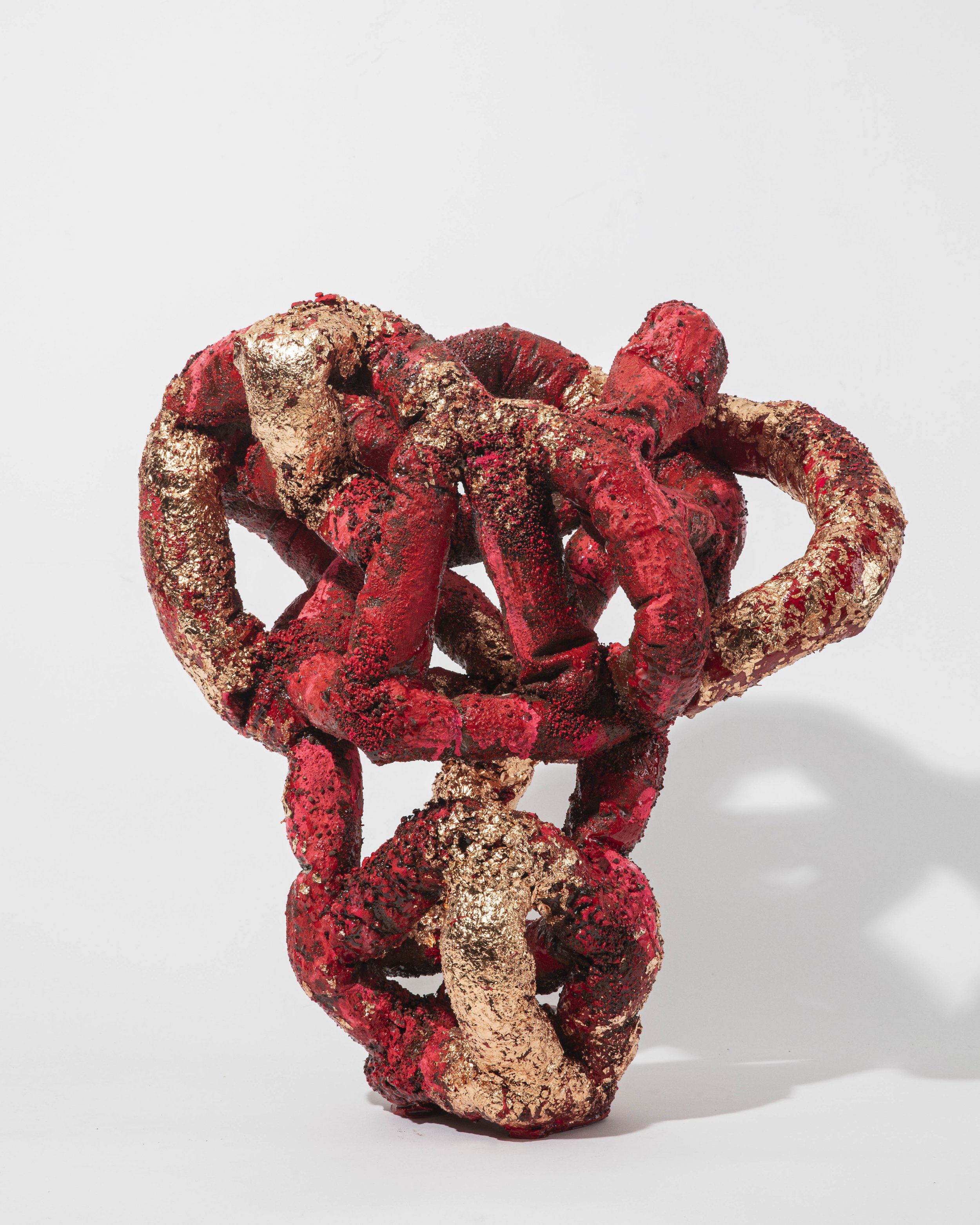
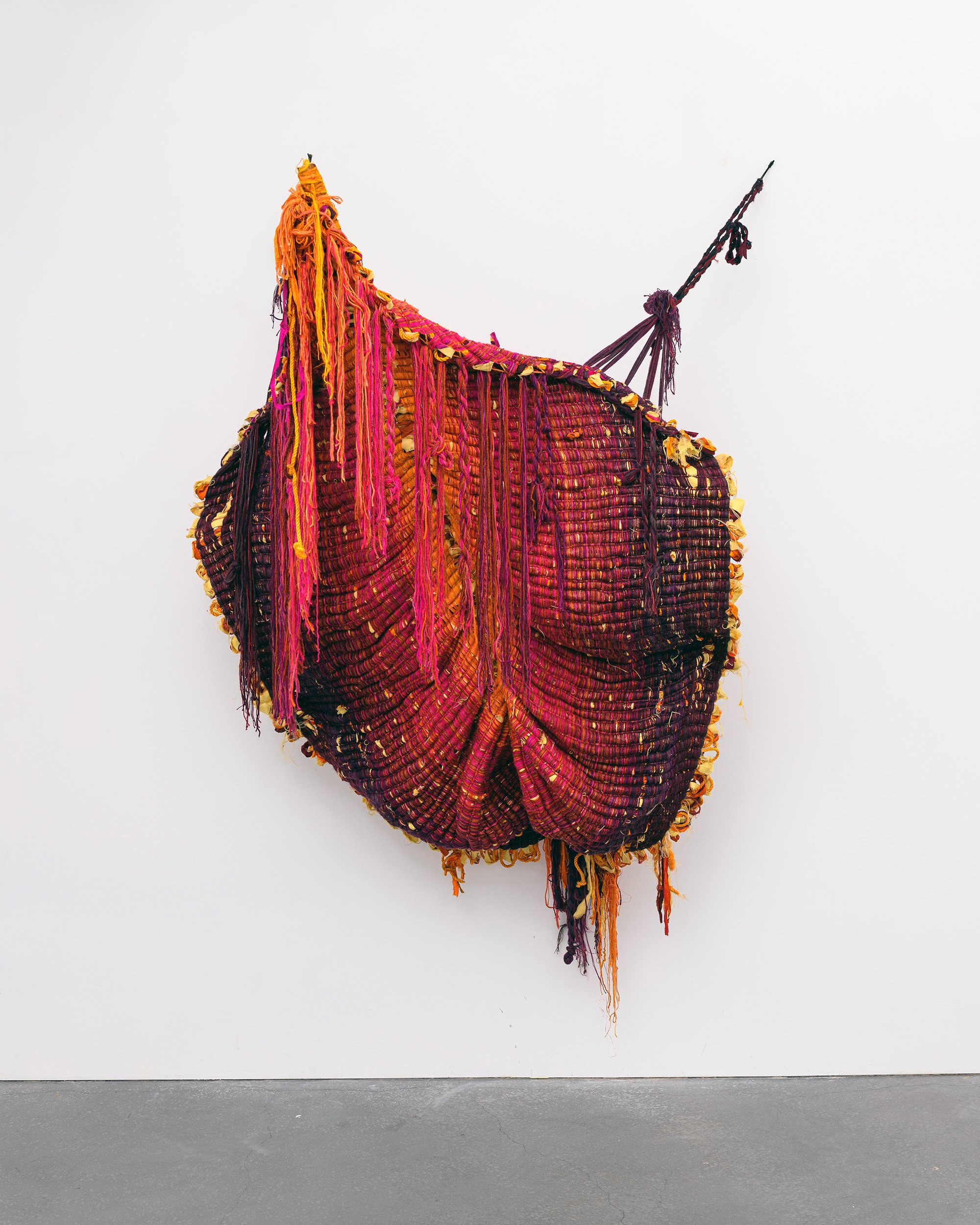
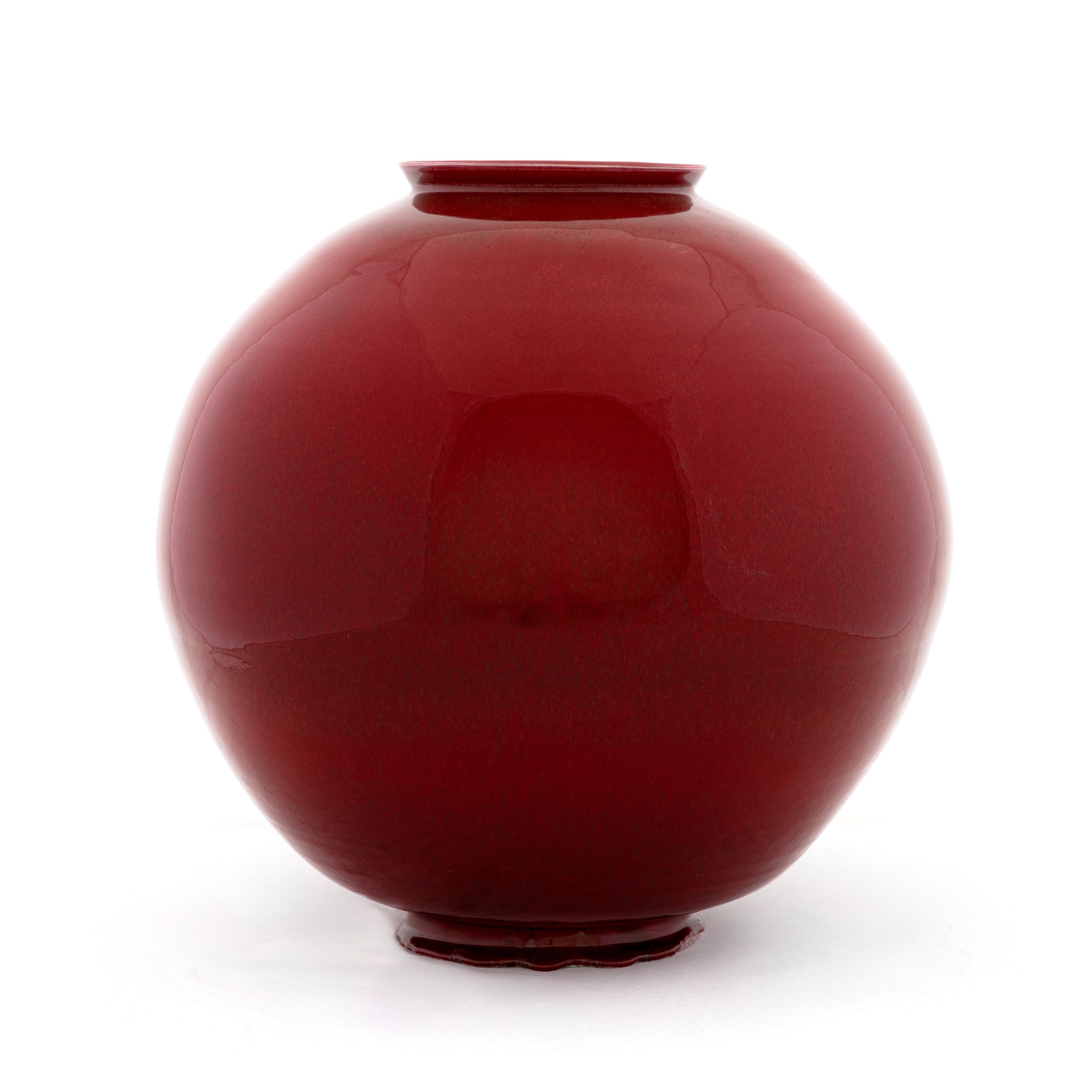

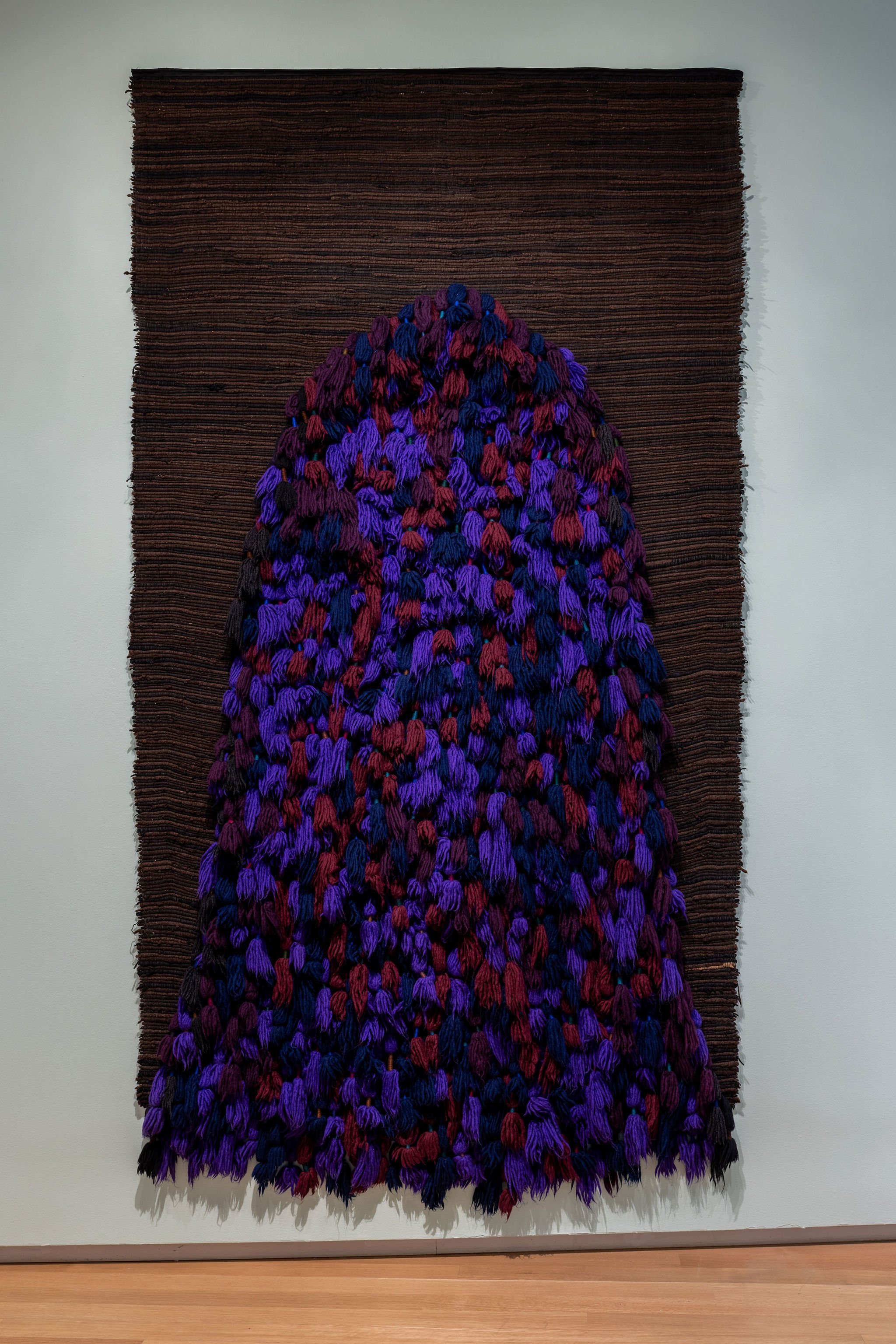
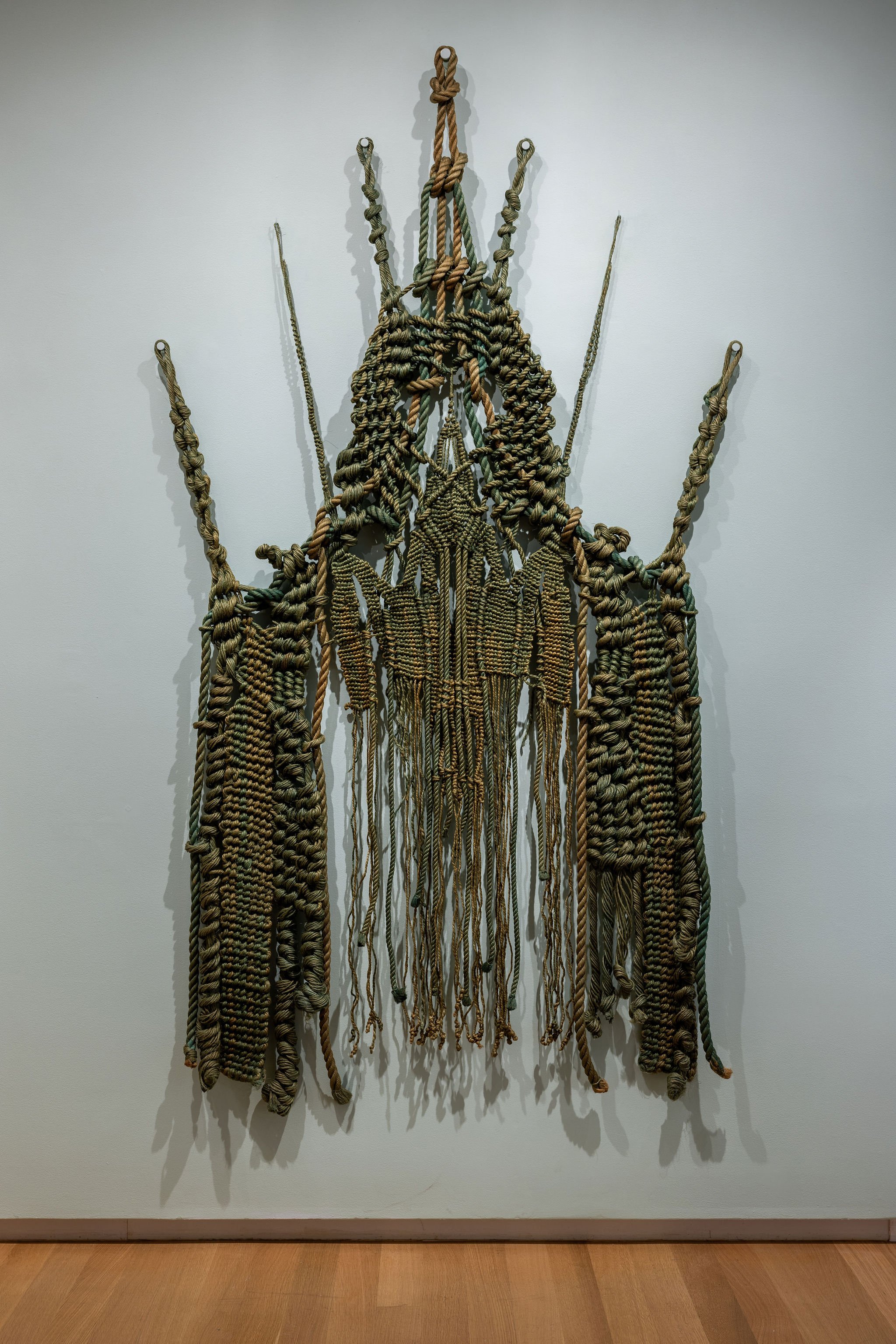

ARTISTS ON VIEW (ALPHABETICAL)
Anni Albers; AYDO Studio (A young Yu and Nicholas Oh); André Azevedo; Eve Biddle; Dale Chihuly; Katherine Choy; Rachelle Dang; Kira Dominguez Hultgren; Ruth Duckworth; Marguerite Friedländer-Wildenhain; Françoise Grossen; Maija Grotell; Trude Guermonprez; Marie Herwald Hermann; Sheila Hicks; Tony Jojola; Jun Kaneko; Liliana Ovalle & Colectivo 1050º; Harvey Littleton; Gertrud Natzler; Otto Natzler; Pedro Barrail & Artisans of Pai Tavytera; Anders Herwald Ruhwald; Kay Sekimachi; Toshiko Takaezu; Peter Ting; Vadis Turner; Mary Ann Unger; Peter Voulkos; Claire Zeisler.
Installation view of Craft Front & Center: Conversation Pieces at the Museum of Arts and Design, New York Photo by Jenna Bascom; courtesy the Museum of Arts and Design. Image dimensions: 2048px x 1366px
ABOUT THE MUSEUM OF ARTS AND DESIGN
The Museum of Arts and Design (MAD) champions contemporary makers across creative fields and presents the work of artists, designers, and artisans who apply the highest level of ingenuity and skill. Since the Museum’s founding in 1956 by philanthropist and visionary Aileen Osborn Webb, MAD has celebrated all facets of making and the creative processes by which materials are transformed, from traditional techniques to cutting-edge technologies. Today, the Museum’s curatorial program builds upon a rich history of exhibitions that emphasize a cross-disciplinary approach to art and design, and reveals the workmanship behind the objects and environments that shape our everyday lives. MAD provides an international platform for practitioners who are influencing the direction of cultural production and driving twenty-first-century innovation, and fosters a participatory setting for visitors to have direct encounters with skilled making and compelling works of art and design.
For more information about this exhibition and other exhibitions at the Museum of Arts and Design, please visit their site here. MAD can also be found on Facebook, Instagram, and YouTube.
Joyce J. Scott: Walk a Mile in My Dreams
Joyce J. Scott: Walk a Mile in My Dreams features a new large-scale commission and nearly 140 objects across the full arc of the artist’s career BALTIMORE, MD On March 24, the Baltimore Museum of Art (BMA) opened the 50-year career retrospective of artist Joyce J. Scott (b. 1948, Baltimore, MD), encompassing the full range and depth of her prolific and genre- defying practice. Joyce J. Scott: Walk a Mile in My Dreams features nearly 140 works from the 1970s to the present—including sculpture, jewelry, textiles, artwear garments, performance compilations, prints, mixed-media installations, and a new large-scale commission. The astonishing virtuosity and ingenuity of Scott’s work in every medium seamlessly coalesces with her lifelong vision to confront racism, sexism, classism, and “all the ‘isms’ society offers” through impish and audacious humor, expressions of beauty, and a humanistic engagement with global events. Her innate ability to move across medium and genre, leveraging her materials to speak fearlessly to subjects of deep personal and communal meaning make her one of the most significant artists of our time and deserving of greater scholarly study and public recognition. Joyce J. Scott: Walk a Mile in My Dreams is co-organized by the BMA and the Seattle Art Museum (SAM) and co-curated by Cecilia Wichmann, BMA Associate Curator of Contemporary Art, and Catharina Manchanda, SAM Jon and Mary Shirley Curator of Modern and Contemporary Art, with support from Leslie Rose, Joyce J. Scott Curatorial Research Assistant. The exhibition will be presented in Baltimore as a special ticketed exhibition from March 24 through July 14, 2024, and in Seattle from October 17, 2024, through January 20, 2025. Joyce J. Scott: Walk a Mile in My Dreams is accompanied by a fully illustrated 288-page catalog that offers new scholarship, artist reflections, and a selection of vital out-of-print source materials.
Installation view of Joyce J. Scott: Walk a Mile in My Dreams at the Baltimore Museum of Art, March 2024. Photo by Mitro Hood.
“Joyce J. Scott is a living legend and a pillar of Baltimore’s artistic community. Her multidisciplinary practice is in a word, magnetic, distinguished in its ability to conjure moments of beauty and awe, while also bringing people into conversation about challenging subjects in a way that is open and embracing. Her work is deeply rooted in both local and global contexts, vibrating with a resonance that is utterly and uniquely Joyce,” said Asma Naeem, the BMA’s Dorothy Wagner Wallis Director. “The
Joyce J. Scott. Joyce's Necklace. c. 1978-85. Rotasa Collection. © Joyce Scott courtesy Goya Contemporary. photo: Ian Reeves
BMA has had the honor of engaging audiences with Scott’s work for many years through exhibitions, public programs, and acquisitions. We are thrilled now to present this comprehensive exhibition that highlights the remarkable range of her career.” Scott has embraced her identity as an artist and performer since childhood. At home in Baltimore, her mother, the artist Elizabeth Talford Scott (1916–2011)—who is also currently the subject of a solo exhibition at the BMA and eight partner sites across Baltimore City—taught her to sew and express herself creatively. Scott considers this knowledge her inheritance: both the specific techniques and aesthetic traditions carried by enslaved people from Africa to the Americas and the awareness of her own life’s potential as part of a continuum.
In the 1970s, Scott began what would become a lifelong commitment to artistic learning and engagementwith global cultures. Her extensive travels have taken her to many countries, including Mexico, Cuba, Peru, Mali, Senegal, Scotland, South Africa, Thailand, and Italy, where she connected with local artisans and community members through a shared embrace of textiles, beads, and glass. As a result, Scott’s work has responded to global events—from the AIDS crisis to South African Apartheid and to American police brutality—and served to memorialize personal and collective transformations and traumas.


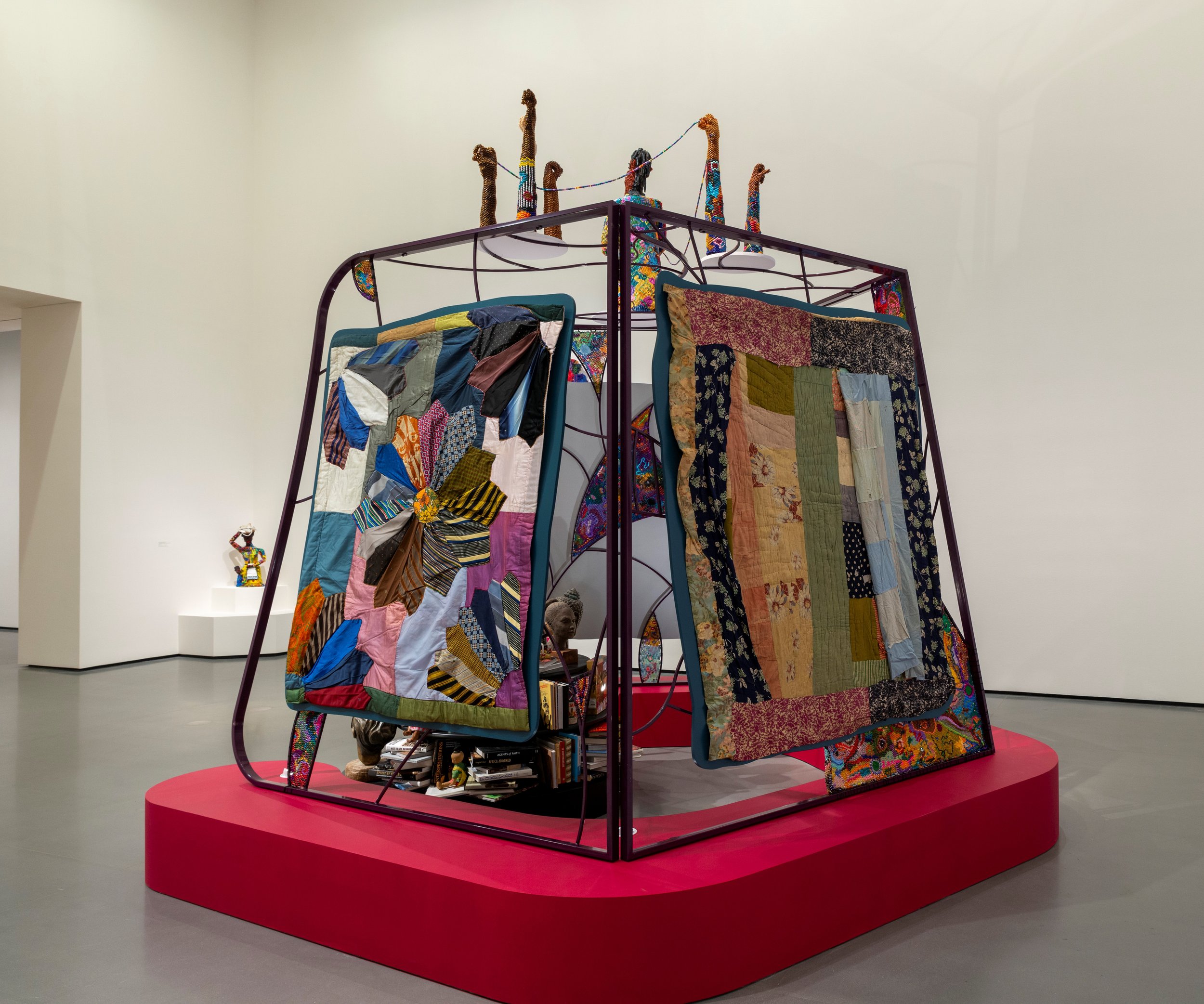







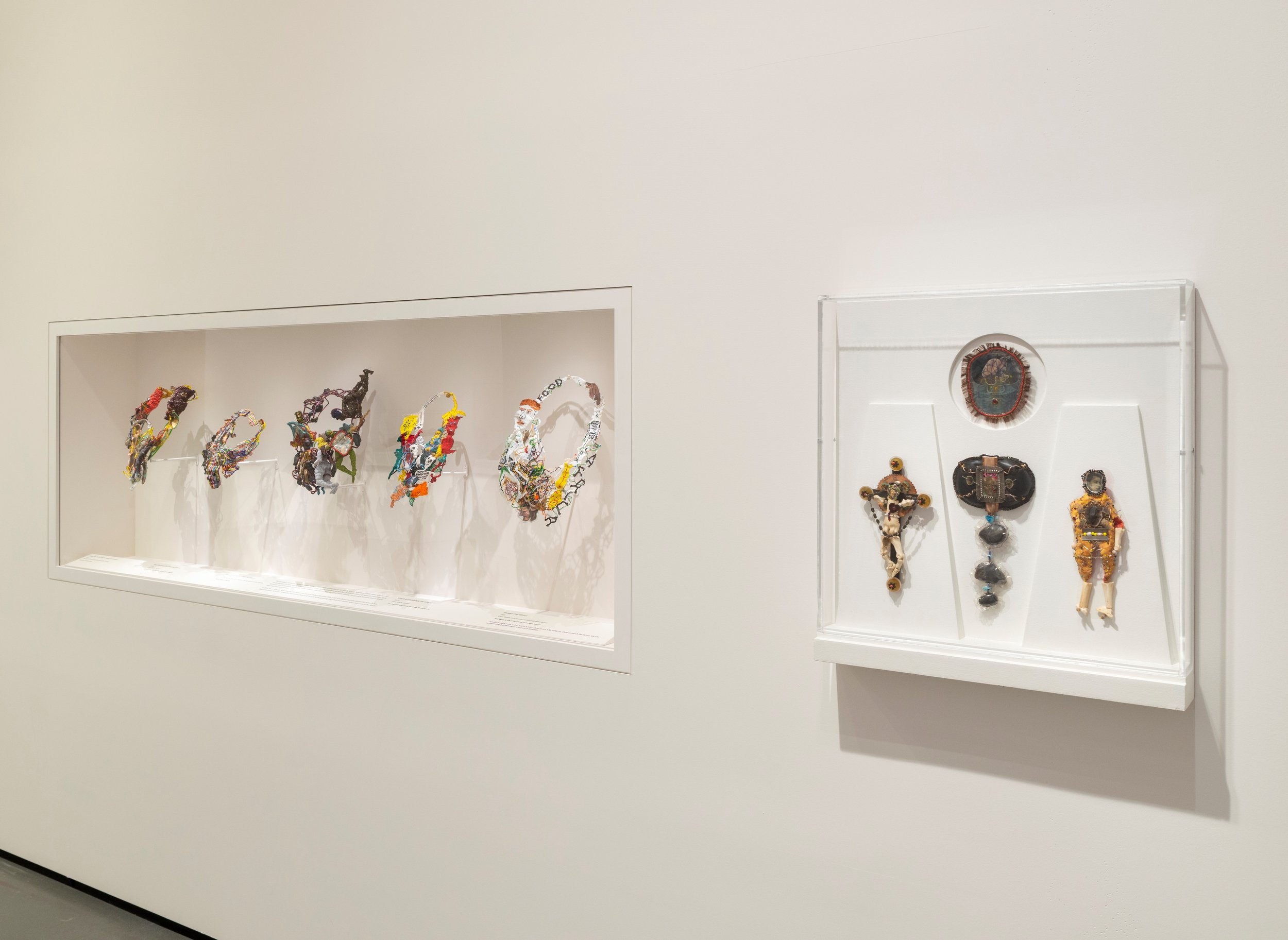




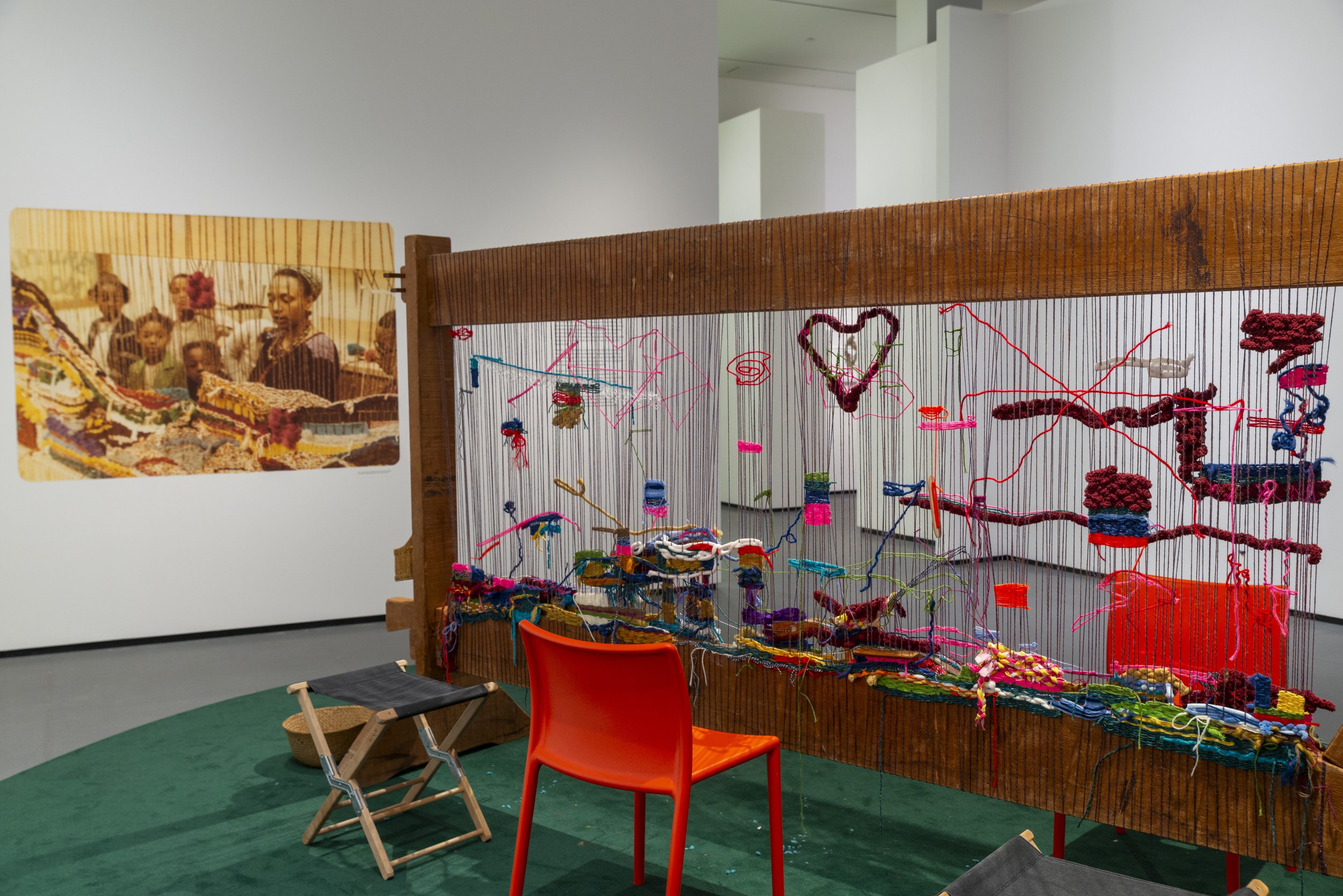
Installation view of Joyce J. Scott: Walk a Mile in My Dreams at the Baltimore Museum of Art, March 2024. Photo by Mitro Hood.
Joyce J. Scott: Walk a Mile in My Dreams draws on the BMA’s long commitment to Scott’s work, from the first acquisition in 1984 to a mid-career retrospective co-organized with the Maryland Institute College of Art’s groundbreaking Exhibition Development Seminar in 2000 and many recent acquisitions.
Kay Lawal and Joyce Scott for the Thunder Thigh Revue's Women in Substance performance, Baltimore. 1985. Philip Arnoult papers, Special Collections, Sheridan Libraries, Johns Hopkins University. © Joyce Scott courtesy Goya Contemporary, photo: Peggy Fox
The exhibition also reflects Scott’s longstanding engagement in the Seattle region through residencies at such venues as Pilchuck Glass School in 1992 and also includes a major sculpture recently acquired by SAM. The BMA’s exhibition is organized in ten thematic sections, with pivotal works reflecting the artist’s cyclical return to motifs and materials over time as she brings forward new ideas and fosters dialogue to support personal healing and critical social change. Additionally, the exhibition includes an expansive array of archival photography drawn in part from the artist’s personal collection. Among the exhibition highlights are:
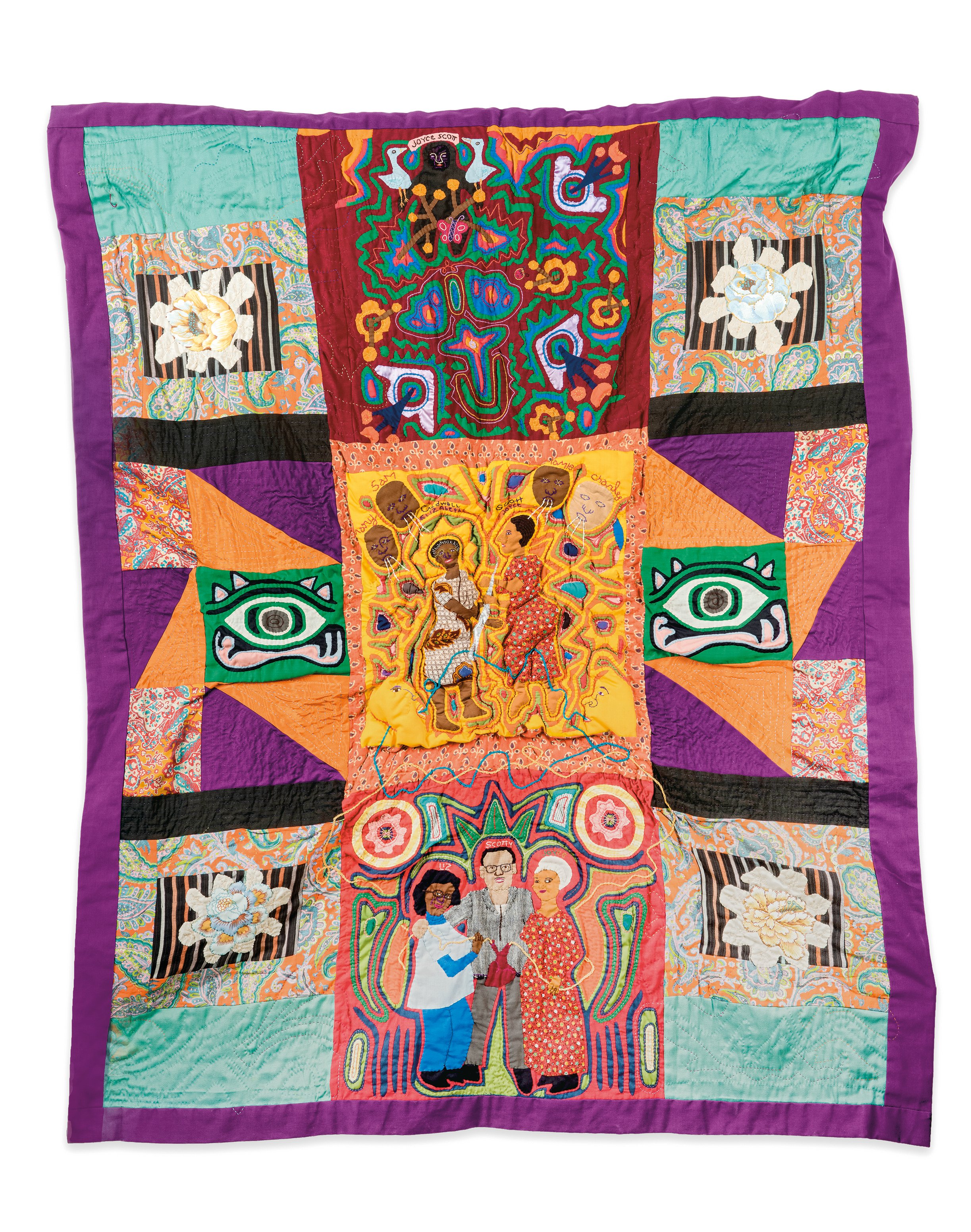
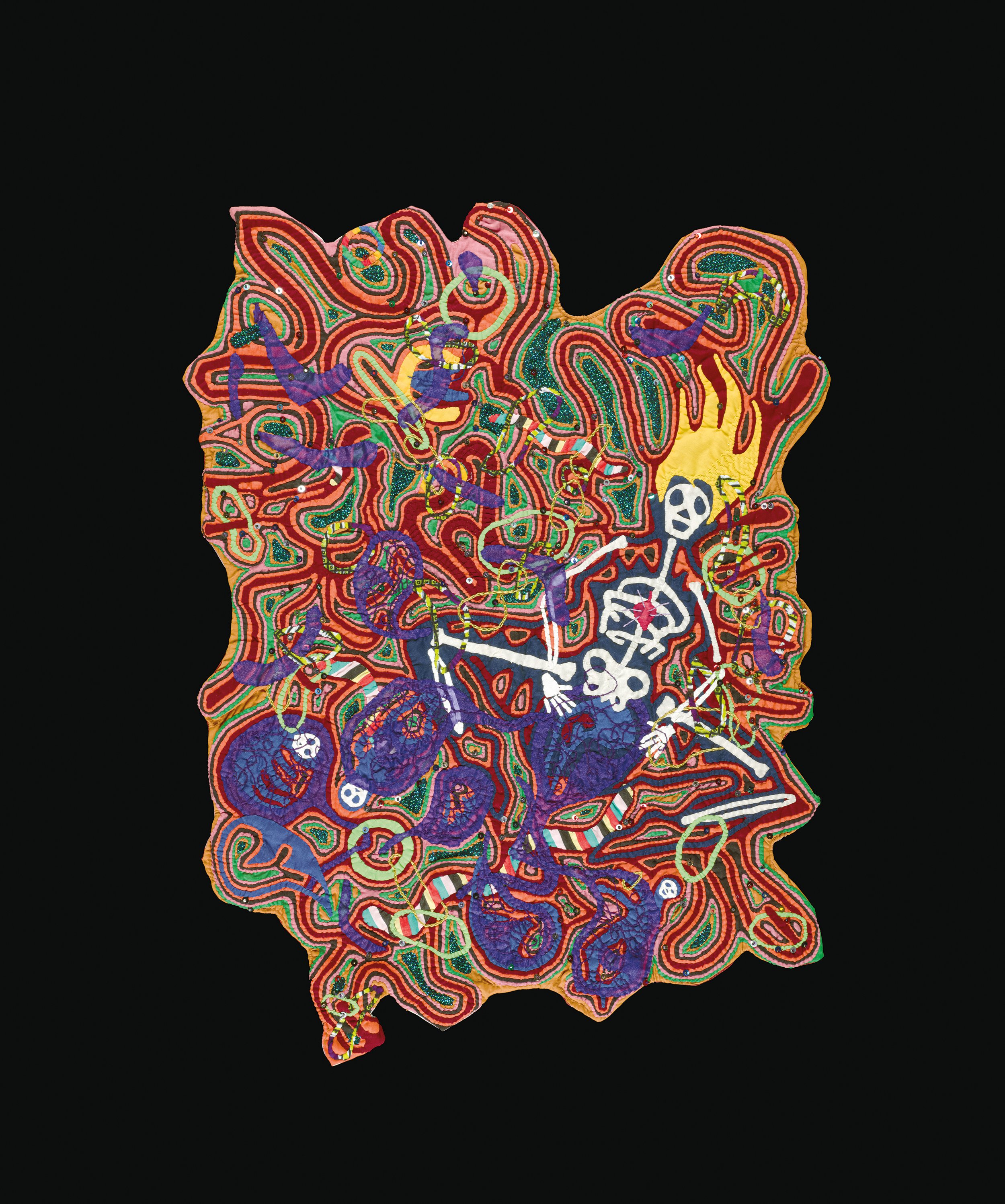












• A new large-scale commission titled The Threads That Unite My Seat to Knowledge (2024) that gathers heirloom family quilts to honor generations of makers in Scott’s family and create a storytelling environment within the exhibition.
• A fashion vignette featuring expressive garments Scott made for herself and friends beginning in the 1970s and sculptural necklaces such as What You Mean Jungle Music (1987) and Hunger (1991) that bridge performance and sculpture, showing how wearing difficult truths can incite conversations about social justice.
• Significant examples from iconic cycles of work reunited for the first time in many years, including Scott’s "Mammy/Nanny” series of the 1980s-90s; riffs on the watermelon trope such as Man Eating Watermelon (1986); and works from her “Still Funny” series that show Scott confronting American history and racial violence in the U.S. and abroad.
Joyce J. Scott performs Walk a Mile in My Drawers, Theatre Project, Baltimore, May 18-19, 2006. Image courtesy of Kel C. Millionie. Photo by Kel C. Millionie
• Ephemera and rare performance footage that bring to life Scott’s earliest performances with Robert Sherman (late 1970s); her legendary “Thunder Thigh Revue” act with Kay Lawal- Muhammad (1985-90); and solo theater pieces such as “Generic Interference/Genetic Engineering” (1988-95) and “Walk a Mile in My Drawers” (2006).
• A communal weaving area echoes Scott’s improvised performances from the 1970s and invites a new generation to discover this collaborative artform. The loom and tables will be periodically activated by Scott and other teaching artists with materials provided by Scrap B-More. Visitors may participate any time; completed works will be presented in the gallery then raffled with proceeds going to support a scholarship fund established by the artist at MICA.Joyce Scott
Joyce J. Scott. Mammie Wada. 1981. Baltimore Museum of Art: Gift of J.B. Hanson and Tom Haulk, Baltimore. © Joyce Scott courtesy Goya Contemporary, photo: Mitro Hood
“Joyce J. Scott’s sophisticated and virtuosic use of a wide range of materials brings beauty and biting irony to bear on subjects ranging from the traumatic to the joyous and transcendent,” said co-curators Wichmann and Manchanda. “Her intergenerational practice is radical in its commitment to community and place while building self-awareness and empathy. Those who already know Scott’s intimate and revelatory work will be astonished to see the many facets of her practice brought together—and those who encounter her work for the first time can expect to be blown away.”




Installation view of Joyce J. Scott: Walk a Mile in My Dreams at the Baltimore Museum of Art, March 2024. Photo by Mitro Hood.
Catalog
A fully illustrated 288-page catalog—co-published by SAM and BMA and distributed by Yale University Press—offers a critical resource that introduces the richness and complexity of Scott’s work through new scholarship, artist reflections, and a selection of vital out-of-print source materials. In addition to an introduction co-authored by Manchanda and Wichmann, the publication features two thematic interviews with the artist by Dr. Leslie King Hammond, Dean Emeritus of the Maryland Institute College of Art, and Valerie Cassel Oliver, Sydney and Frances Lewis Family Curator of Modern and Contemporary Art at the Virginia Museum of Fine Arts. Essays on key aspects of Scott’s work are contributed by scholars Tiffany E. Barber, Angela N. Carroll, Henry J. Drewal, Ashley Minner Jones, and Lowery Stokes Sims. A cross-generational group of artists—Oletha DeVane, Sonya Clark, Kay Lawal-Muhammad, Jeffrey Gibson, Malcolm Peacock, and William Rhodes—reflect on Scott’s influential role as artist, mentor, and educator. The out-of-print catalogue from Scott’s 30-year retrospective organized by guest curator George Ciscle at the BMA with students from MICA’s Exhibition Development Seminar remains a vital resource on Scott’s work and has been digitized and archived: artbma.org/kickinit

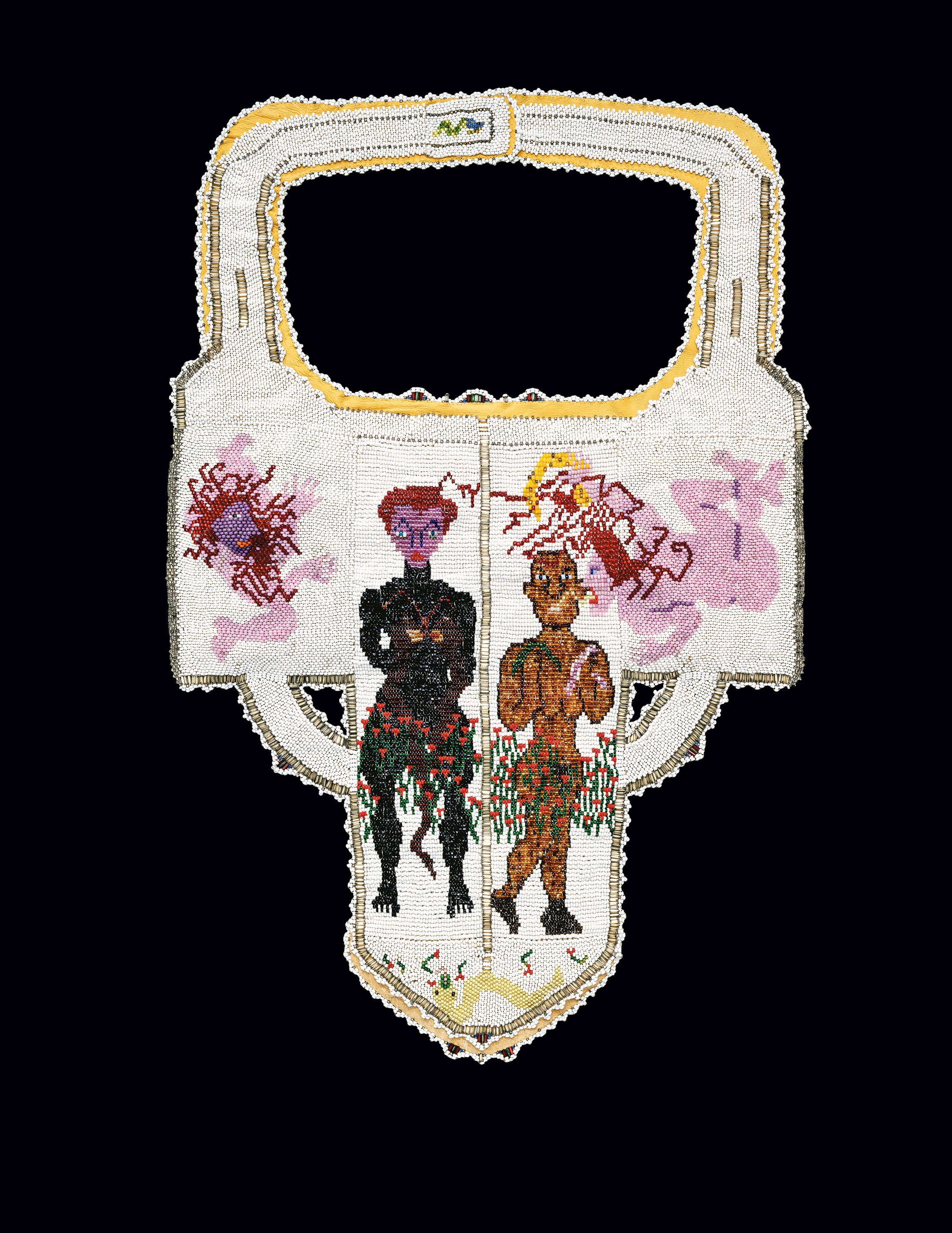


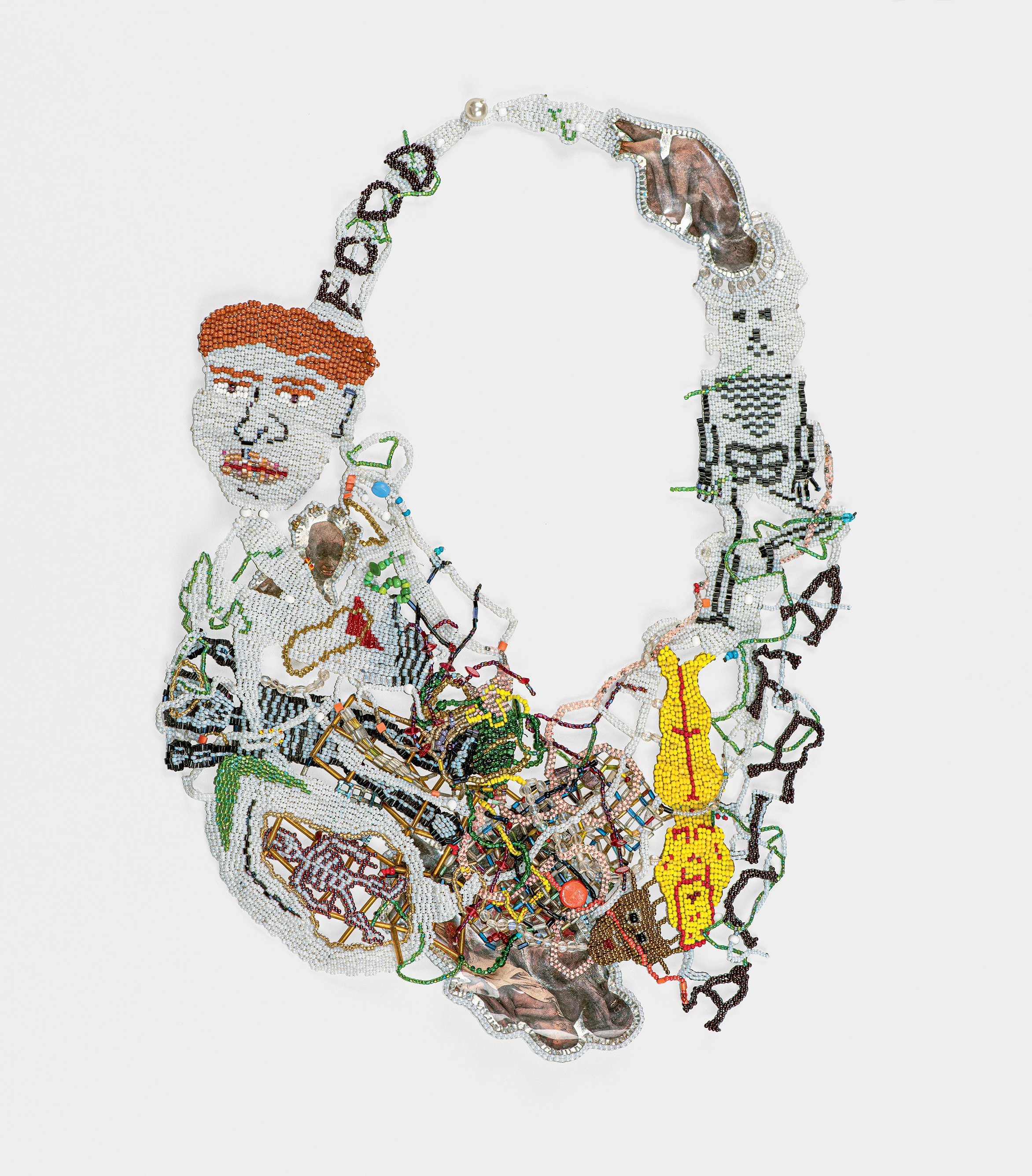
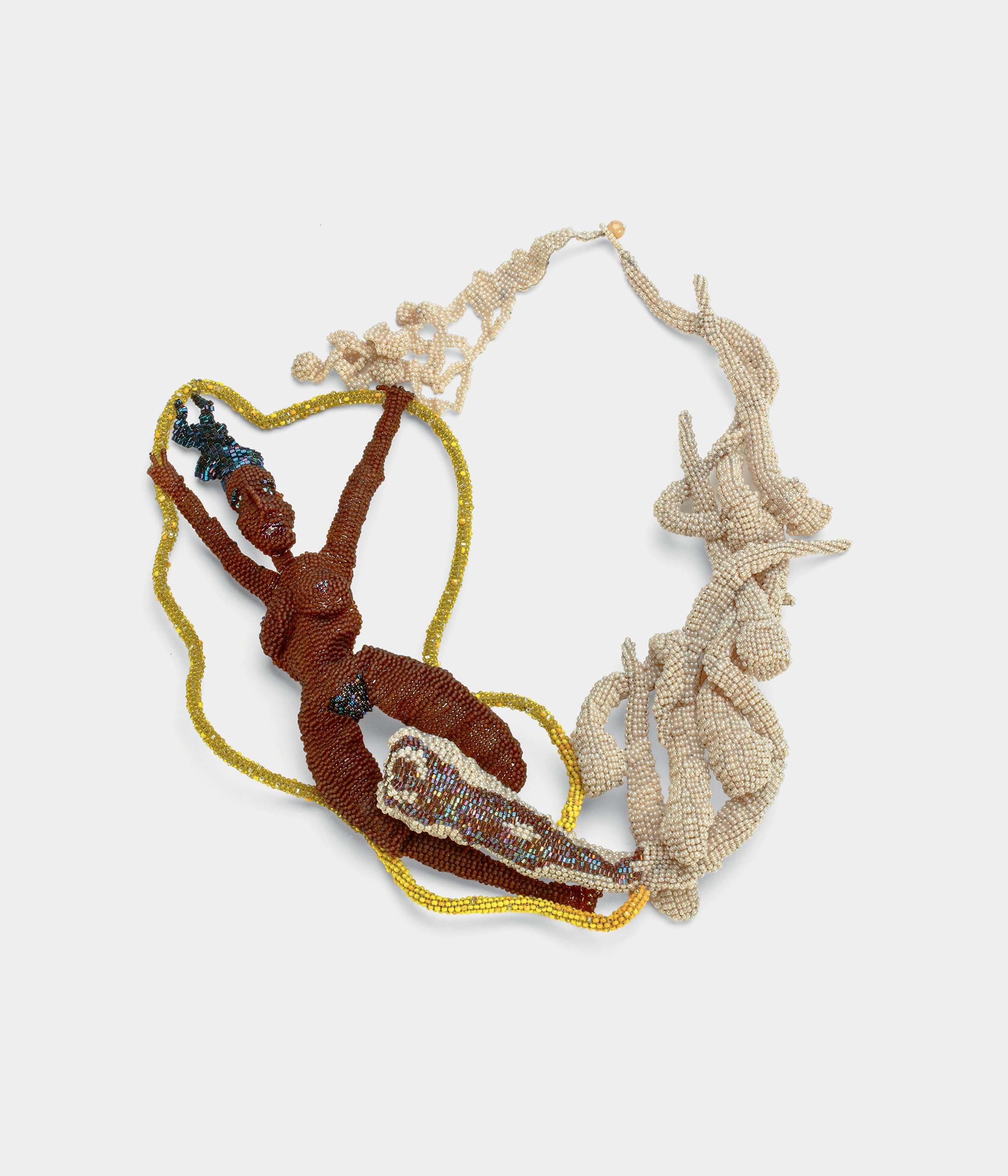

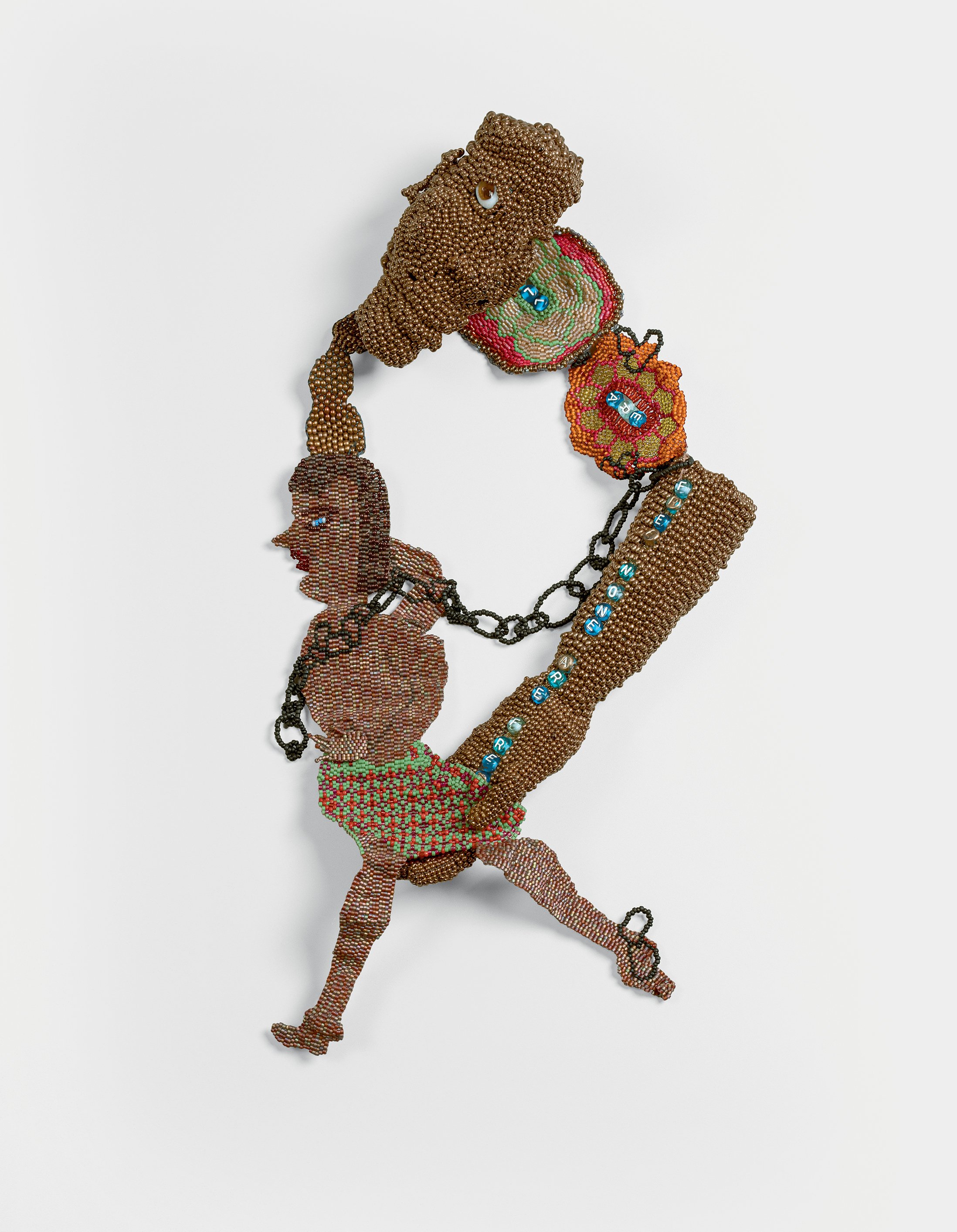



Sponsors
This exhibition and national tour are made possible by substantial grants from the Ford Foundation, Henry Luce Foundation, Terra Foundation for American Art, and The Andy Warhol Foundation for the Visual Arts. In Baltimore, the exhibition is also supported by the Alvin and Fanny B. Thalheimer Exhibition Endowment Fund, the Suzanne F. Cohen Exhibition Fund, Bank of America, Wagner Foundation, Joanne Gold and Andrew Stern, The Jacques and Natasha Gelman Foundation, Transamerica, the National Endowment for the Arts, the Clair Zamoiski Segal and Thomas H. Segal Contemporary Art Endowment Fund, Goya Contemporary Gallery and Martha Macks-Kahn, The Coby Foundation, Ltd., and the American Craft Council.
Courtesy of Joyce J. Scott
Joyce J. Scott
Joyce J. Scott (b. 1948, Baltimore, MD) earned her Bachelor of Fine Arts from the Maryland Institute College of Art and a Master of Fine Arts from the Instituto Allende in Mexico. In 2018, she was awarded an honorary fellowship from NYU, as well as honorary doctorates from both MICA and the California College of the Arts. In 2022, she was awarded an honorary doctorate from Johns Hopkins University. Her work has been the subject of numerous exhibitions, with major solo shows such as Joyce J. Scott: Harriet Tubman and Other Truths at Grounds for Sculpture, Hamilton, NJ (2018); Joyce J. Scott: Truths and Visions at the Museum of Contemporary Art, Cleveland (2015); Maryland to Murano: The Neckpieces & Sculpture of Joyce J. Scott at the Museum of Arts and Design, New York (2014-15); and Joyce J. Scott: Kickin’ It with the Old Masters at the BMA (2000). She has received commissions, grants, awards, residencies, and honors, including from MacArthur Foundation Fellowship (2016), Lifetime Achievement Award from the Women’s Caucus for the Arts, Anonymous Was a Woman, and Smithsonian Visionary Artist Award, among others. Scott’s work is also included in many public collections, including the BMA, Metropolitan Museum of Art, Brooklyn Museum of Art, Los Angeles County Museum of Art, National Museum of African American History and Culture, the Seattle Art Museum, and many others.
Baltimore Museum of Art
Founded in 1914, the Baltimore Museum of Art (BMA) inspires people of all ages and backgrounds through exhibitions, programs, and collections that tell an expansive story of art—challenging long-held narratives and embracing new voices. Our outstanding collection of more than 97,000 objects spans many eras and cultures and includes the world’s largest public holding of works by Henri Matisse; one of the nation’s finest collections of prints, drawings, and photographs; and a rapidly growing number of works by contemporary artists of diverse backgrounds. The museum is also distinguished by a neoclassical building designed by American architect John Russell Pope and two beautifully landscaped gardens featuring an array of modern and contemporary sculpture. The BMA is located three miles north of the Inner Harbor, adjacent to the main campus of Johns Hopkins University, and has a community branch at Lexington Market. General admission is free so that everyone can enjoy the power of art.
Visitor Information
General admission to the BMA is free. The BMA is open Wednesday through Sunday from 10 a.m. to 5 p.m., with extended hours on Thursdays until 9 p.m. The Sculpture Gardens are open Wednesday through Sunday, 10 a.m. to dusk. The museum and gardens are closed New Year’s Day, Juneteenth, July 4, Thanksgiving Day, and Christmas Day. The BMA is located at 10 Art Museum Drive, three miles north of Baltimore’s Inner Harbor. For general museum information, call 443-573-1700 or visit here.
For more information about this exhibition and other exhibitions at the Baltimore Museum of Art, please visit their site here. The museum can also be found on YouTube, Facebook, and Instagram.
Adam Pendleton: An Abstraction
Black Dada (A/A), 2024 silkscreen ink and black gesso on canvas, two parts 96" × 76" (243.8 cm × 193 cm) No. 91039
New York – Pace is pleased to present An Abstraction, an exhibition of recent paintings and drawings by New York- based artist Adam Pendleton, at its 540 West 25th Street gallery in New York. Pendleton’s first solo show at Pace’s New York gallery in ten years, An Abstraction follows a series of significant solo exhibitions by the artist at museums around the world, including the Museum of Modern Art in New York in 2021; the Montreal Museum of Fine Arts in 2022; and mumok - Museum Moderner Kunst Stiftung Ludwig Wien, Vienna in 2023. The return to his home city marks a continuation of his career-long project of creating spaces of engagement and “fighting for the right to exist in and through abstraction.”
Pendleton’s work indexes and documents the physical process of painting to create layered pictorial fields that—in their painterly, psychic, and verbal expressions—announce a new mode of visual composition for the 21st century. He is guided by a visual and structural philosophy he has termed “Black Dada,” an ongoing inquiry into Blackness and its relationship to abstraction and conceptions of the avant-garde. Investigating Blackness as a color and theoretical proposition, the artist’s work reflects a contrapuntal understanding of the world in both sensorial and conceptual terms.
Black Dada (B), 2024 silkscreen ink and black gesso on canvas, two parts 96" × 76" (243.8 cm × 193 cm) No. 91041
In An Abstraction, the artist’s 12 paintings and 13 drawings will hang within a monumental, site-specific architecture consisting of five black triangular forms. These sculptural walls will reorder the gallery into new, unexpected spaces and extend the visual language of the exhibited works.
Bringing together the artist’s Black Dada and Untitled (Days) bodies of work, the new paintings and drawings in the exhibition feature a variety of marks—spray painting, stenciled geometric forms, and expressionistic brushstrokes— to blur distinctions between painting, drawing, and photography and propose painting as a documentary and performative act.
Pendleton’s new Black Dada works imbue his iconic black and white compositions with focused and saturated colors. Each of the paintings and drawings in this body of work bears one or more typographic letters from the phrase “BLACK DADA,” rendered in a sans serif font amid the artist’s gestural marks. Continually transposing and overwriting these two modes of inscription, Pendleton cultivates a living library of his own ever-evolving gestures and processes.
Black Dada (K), 2024 silkscreen ink and black gesso on canvas, two parts 96" × 76" (243.8 cm × 193 cm) No. 91042
Paintings and drawings from Pendleton’s Untitled (Days) body of work will also be featured in An Abstraction. Using collagist strategies of indexing, daily mark-making, fragmentation, and recombination, these works create a cumulative portrait of the artist’s experimentations in the studio.
In spring 2025, the Hirshhorn Museum and Sculpture Garden in Washington, D.C. will present Love, Queen, a landmark exhibition of Pendleton’s work that will anchor the institution’s 50th anniversary year.


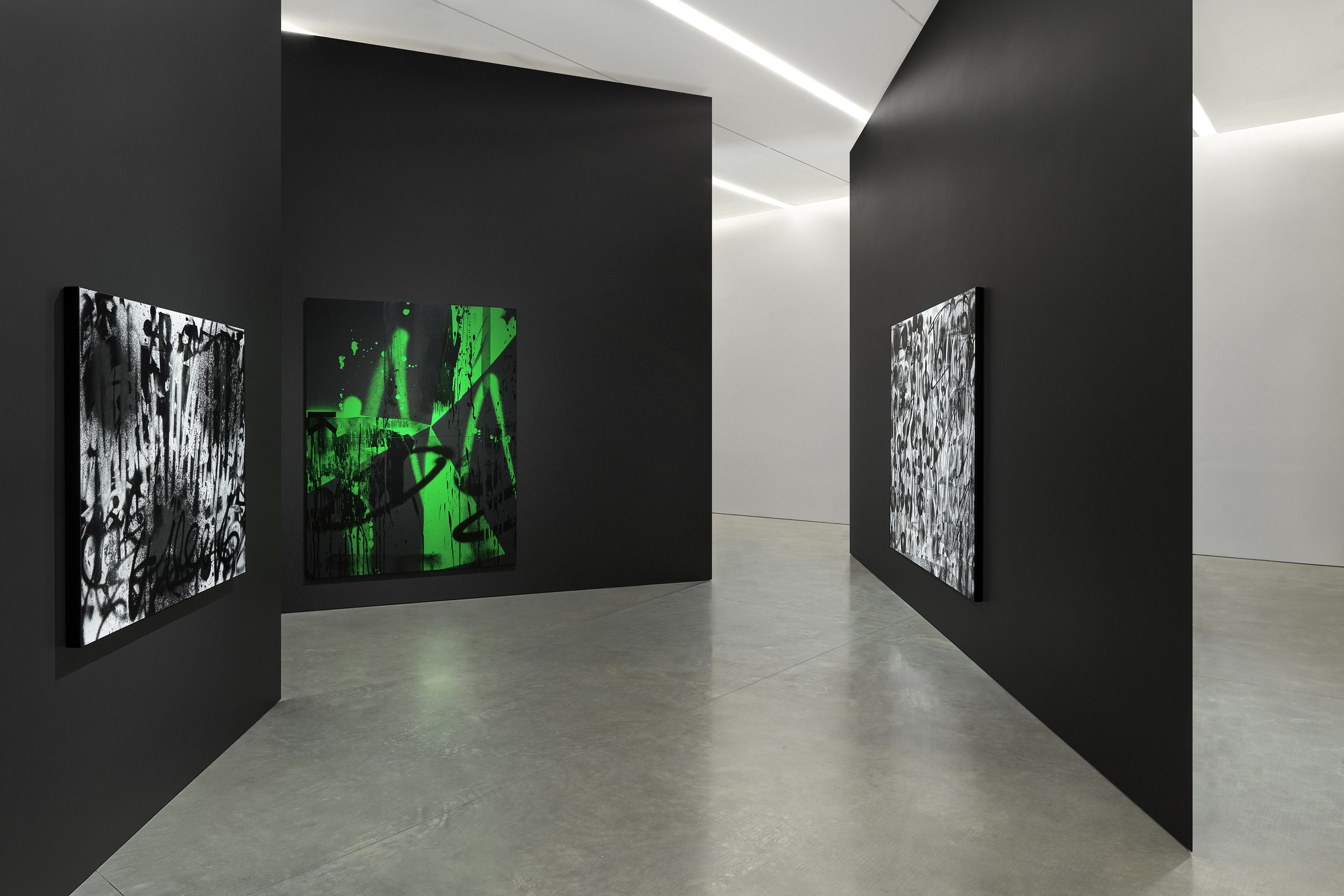

Adam Pendleton: An Abstraction 540 West 25th Street, New York, NY 10001 May 3 – August 16, 2024 Photography courtesy Pace Gallery
Born in Richmond, Virginia in 1984, Adam Pendleton completed the Artspace Independent Study Program in Pietrasanta, Italy, in 2002. His work has been featured at major museums around the world, including solo exhibitions at the Baltimore Museum of Art; Le Consortium, Dijon, France; Isabella Stewart Gardner Museum, Boston; KW Institute for Contemporary Art, Berlin; Museum of Contemporary Art Cleveland; and Museum of Contemporary Art Denver, among others. Recent solo and group exhibitions include Adam Pendleton: Who is Queen? (2021–22) at the Museum of Modern Art, New York; Adam Pendleton: These Things We’ve Done Together (2021–22) at the Montreal Museum of Fine Arts; Biennial: Quiet as It’s Kept (2022) at the Whitney Museum of American Art, New York; Adam Pendleton: Blackness, White and Light (2023–24) at the mumok - Museum Moderner Kunst Stiftung Ludwig Wien, Vienna; and Adam Pendleton: To Divide By (2023–24) at the Mildred Lane Kemper Art Museum, St. Louis.
Black Dada Drawing (L), 2024 silkscreen ink on paper in artist's frame 38" × 30-3/8" (96.5 cm × 77.2 cm) No. 91798
His work is in numerous public collections, including the Museum of Modern Art, New York; the Whitney Museum of American Art, New York; the Solomon R. Guggenheim Museum, New York; the Studio Museum in Harlem, New York; the Carnegie Museum of Art, Pittsburgh; the Museum of Contemporary Art Chicago; the Museum of Contemporary Art San Diego; and Tate, London.
Pace is a leading international art gallery representing some of the most influential contemporary artists and estates from the past century, holding decades-long relationships with Alexander Calder, Jean Dubuffet, Barbara Hepworth, Agnes Martin, Louise Nevelson, and Mark Rothko. Pace enjoys a unique U.S. heritage spanning East and West coasts through its early support of artists central to the Abstract Expressionist and Light and Space movements.
Since its founding by Arne Glimcher in 1960, Pace has developed a distinguished legacy as an artist-first gallery that mounts seminal historical and contemporary exhibitions. Under the current leadership of CEO Marc Glimcher, Pace continues to support its artists and share their visionary work with audiences worldwide by remaining at the forefront of innovation. Now in its seventh decade, the gallery advances its mission through a robust global program— comprising exhibitions, artist projects, public installations, institutional collaborations, performances, and interdisciplinary projects. Pace has a legacy in art bookmaking and has published over five hundred titles in close collaboration with artists, with a focus on original scholarship and on introducing new voices to the art historical canon.
Today, Pace has seven locations worldwide, including European footholds in London and Geneva as well as Berlin, where the gallery established an office in 2023. Pace maintains two galleries in New York—its headquarters at 540 West 25th Street, which welcomed almost 120,000 visitors and programmed 20 shows in its first six months, and an adjacent 8,000 sq. ft. exhibition space at 510 West 25th Street. Pace’s long and pioneering history in California includes a gallery in Palo Alto, which was open from 2016 to 2022. Pace’s engagement with Silicon Valley’s technology industry has had a lasting impact on the gallery at a global level, accelerating its initiatives connecting art and technology as well as its work with experiential artists. Pace consolidated its West Coast activity through its flagship in Los Angeles, which opened in 2022. Pace was one of the first international galleries to establish outposts in Asia, where it operates permanent gallery spaces in Hong Kong and Seoul, along with an office and viewing room in Beijing. In spring 2024, Pace will open its first gallery space in Japan in Tokyo’s new Azabudai Hills development.
The exhibition opened on May 3 and will be on view until August 16 2024 at Pace Gallery 510 West 25th Street in New York. For more information about this exhibition and others, please visit the Pace Gallery’s website here. Pace Gallery can be found on Instagram and Artsy, too.
teamLab: The World of Irreversible Change
teamLab: The World of Irreversible Change 510 West 25th Street, New York, NY 10001 May 10 – August 16, 2024 Photography courtesy Pace Gallery
New York – Pace is pleased to present an exhibition by teamLab at its 510 West 25th Street gallery in New York. Which opened on May 10 and will be on view until August 16, the show spotlights a single interactive digital artwork—titled The World of Irreversible Change—projected on a wall in the gallery. This presentation marks teamLab’s first solo exhibition in New York in ten years.
Founded by Toshiyuki Inoko in Tokyo in 2001, teamLab is an international collective of artists, programmers, engineers, CG animators, mathematicians, and architects. Known for its multisensory, immersive work, teamLab explores the relationships between humans and the world, encouraging new modes of perception through its pioneering, technologically advanced installations. In recent years, teamLab has presented solo exhibitions at the Asian Art Museum in San Francisco; Amos Rex in Helsinki; TANK Shanghai; and many other institutions and venues around the world.
The exhibition at Pace in New York, The World of Irreversible Change is projected on a large, freestanding, black-painted wall in a darkened gallery space. First presented by the collective in spring 2022 at the Aomori Museum of Art in Japan, this screen-based work, created by teamLab over five years, has never before been exhibited as a projection. Conceptually, The World of Irreversible Change centers on everyday life in an anonymous city during an unspecified epoch. Animated figures move throughout the panoramic village scene, which will change with the time of day and weather in New York. Scenery and stories will unfold each day, and the lives of the people in the city will continue eternally unless gallery visitors interact with the work, causing permanent disruption.
teamLab: The World of Irreversible Change 510 West 25th Street, New York, NY 10001 May 10 – August 16, 2024 Photography courtesy Pace Gallery
Over the course of its exhibition at Pace, The World of Irreversible Change can transform as a result of viewers’ engagement with it. If visitors continue to intervene with the work during its three-month presentation, the scenes of daily life will become increasingly agitated and chaotic, with fighting between individuals escalating into an all-out war. Peace and harmony will give way to fire and destruction, a devolution that speaks to the inherency and universality of violence in the human experience. The city will become forever devoid of people, while plants will begin populating its streets and ruins over time.
“In the ruined city where not a single person remains, the seasons still pass and the sun rises and sets with the time of the real world,” teamLab writes in a statement on The World of Irreversible Change. “After a while, new flora begin to grow in the burnt ruins of the city. The flora grow, bloom, and scatter repeatedly, changing daily with the real passage of time ... Once the world of this artwork begins to burn, the world from before can never be returned to. The people who interact with the artwork cause this outcome.”
Along with its forthcoming presentation of The World of Irreversible Change at Pace’s New York gallery, teamLab will present an interactive installation as part of Art@Harbour 2024 in Hong Kong, running from March 25 to June 2. The collective also recently established teamLab Borderless, a permanent museum of over 70 digital works presented as one continuous world within a multi-room exhibition space, in Tokyo’s Azabudai Hills development, which is also home to Pace’s new gallery in the Japanese capital, opening this summer. Following Tokyo, teamLab Borderless will open in Jeddah, Saudi Arabia and Hamburg, Germany, and teamLab is also preparing to open a massive 17,000 square-meter (nearly 183,000 square-feet) experiential art space in Abu Dhabi. Later this year, teamLab’s annual exhibition in the ancient forest of Mifuneyama Rakuen in Kyushu, Japan will take place for the tenth year.
Last year, in December 2023, the collective’s museum teamLab Planets Tokyo was ranked fifth on Google’s “Year in Search,” measured by activity on Google Maps.
teamLab, The World of Irreversible Change, 2024, © teamLab, courtesy Pace Gallery
teamLab (f. 2001) is an international art collective, an interdisciplinary group of various specialists such as artists, programmers, engineers, CG animators, mathematicians and architects whose collaborative practice seeks to navigate the confluence of art, science, technology, and the natural world.
teamLab aims to explore the relationship between the self and the world and new perceptions through art. In order to understand the world around them, people separate it into independent entities with perceived boundaries between them. teamLab seeks to transcend these boundaries in our perception of the world, of the relationship between the self and the world, and of the continuity of time. Everything exists in a long, fragile yet miraculous, borderless continuity of life.
teamLab’s works are in the permanent collection of Amos Rex, Helsinki; Art Gallery of New South Wales, Sydney; Art Gallery of South Australia, Adelaide; Asia Society Museum, New York; Asian Art Museum, San Francisco; Borusan Contemporary Art Collection, Istanbul; Museum of Contemporary Art, Los Angeles; and National Gallery of Victoria, Melbourne.
Pace is a leading international art gallery representing some of the most influential contemporary artists and estates from the past century, holding decades-long relationships with Alexander Calder, Jean Dubuffet, Barbara Hepworth, Agnes Martin, Louise Nevelson, and Mark Rothko. Pace enjoys a unique U.S. heritage spanning East and West coasts through its early support of artists central to the Abstract Expressionist and Light and Space movements.
Since its founding by Arne Glimcher in 1960, Pace has developed a distinguished legacy as an artist-first gallery that mounts seminal historical and contemporary exhibitions. Under the current leadership of CEO Marc Glimcher, Pace continues to support its artists and share their visionary work with audiences worldwide by remaining at the forefront of innovation. Now in its seventh decade, the gallery advances its mission through a robust global program— comprising exhibitions, artist projects, public installations, institutional collaborations, performances, and interdisciplinary projects. Pace has a legacy in art bookmaking and has published over five hundred titles in close collaboration with artists, with a focus on original scholarship and on introducing new voices to the art historical canon.
Today, Pace has seven locations worldwide, including European footholds in London and Geneva as well as Berlin, where the gallery established an office in 2023. Pace maintains two galleries in New York—its headquarters at 540 West 25th Street, which welcomed almost 120,000 visitors and programmed 20 shows in its first six months, and an adjacent 8,000 sq. ft. exhibition space at 510 West 25th Street. Pace’s long and pioneering history in California includes a gallery in Palo Alto, which was open from 2016 to 2022. Pace’s engagement with Silicon Valley’s technology industry has had a lasting impact on the gallery at a global level, accelerating its initiatives connecting art and technology as well as its work with experiential artists. Pace consolidated its West Coast activity through its flagship in Los Angeles, which opened in 2022. Pace was one of the first international galleries to establish outposts in Asia, where it operates permanent gallery spaces in Hong Kong and Seoul, along with an office and viewing room in Beijing. In spring 2024, Pace will open its first gallery space in Japan in Tokyo’s new Azabudai Hills development.
This exhibition opened on May 10 and will be on view until August 16, 2024, at Pace Gallery 510 West 25th Street in New York. For more information about this exhibition and others, please visit the Pace Gallery’s website here. Pace Gallery can be found on Instagram and Artsy, too.
Alicja Kwade and Agnes Martin: Space Between the Lines
Alicja Kwade and Agnes Martin: Space Between the Lines 1201 South La Brea Avenue, Los Angeles, CA 90019 May 18 – June 29, 2024 Photography by Jeff McLane, courtesy Pace Gallery
Los Angeles – Pace is pleased to present a two-artist exhibition of work by Alicja Kwade and Agnes Martin—co- curated by Kwade and Arne Glimcher, the gallery’s founder—at its Los Angeles space. On view from May 18 to June 29, this show will place works by Kwade, including two new large-scale sculptures, in dialogue with a selection of paintings and works on paper by Martin. This will be Kwade’s first significant presentation of new work in Los Angeles and her first major exhibition with Pace since joining the gallery in 2023.
Kwade is known internationally for sculptures, large-scale public installations, films, photographs, and works on paper that engage poetically and critically with scientific and philosophical concepts. Through a distinctive vocabulary encompassing reflection, repetition, and the manipulation of everyday objects and natural materials, the artist raises questions about structures and systems that govern and shape our daily lives. In her contemplative works, which dismantle boundaries of perception, she challenges commonly accepted ideas and beliefs while proposing new modes of seeing and understanding reality.
Alicja Kwade and Agnes Martin: Space Between the Lines 1201 South La Brea Avenue, Los Angeles, CA 90019 May 18 – June 29, 2024 Photography by Jeff McLane, courtesy Pace Gallery
The result of a longstanding conversation that Kwade has undertaken with Glimcher around the work of Agnes Martin, who was a close friend of Glimcher and whom he has represented since 1974, the exhibition at Pace’s LA gallery centers on the affinities and intersections between Kwade’s artistic concerns and those of Martin. Although separated by generations, several threads run through both artists’ practices—in particular, their focus on time and temporality as an organizing principle of perceptual experience. These artists also share a fascination with the relationship between truth and beauty. While Kwade’s work is often grounded by a conceptual armature, Martin sought to express a transcendental quietude and purity through painting. For both artists, ordered, mathematical systems, often expressed through their use of line, are integral to their approaches to artmaking. On a formal level, enactments of balance, negotiations of symmetry and non-symmetry, and explorations of liminal, in-between spaces cut across their works.
Alicja Kwade and Agnes Martin: Space Between the Lines 1201 South La Brea Avenue, Los Angeles, CA 90019 May 18 – June 29, 2024 Photography by Jeff McLane, courtesy Pace Gallery
“For some time, I have been interested in a dialogue between Agnes Martin’s paintings and the sculptures of Alicja Kwade,” Glimcher says of the exhibition, “Both artists have been involved in the possibilities of line, both bring a meditative sensibility, and both are interested in questions of time. Both make works that reveal themselves slowly, with time. I have always felt Agnes’s work is closer to music than it is to traditional painting, and with Alicja, there is a parallel sense of adjacency with other modes of perception.”
Two new large-scaled sculptures by Kwade—which are related to her ParaPivot series—will anchor the exhibition. In these works, titled Distorted Dream (2024) and Distorted Day (2024), carved stone orbs appear to float within a framework of polished steel plates and powder-coated steel frames, which intersect at oblique angles. Reflecting her interest in ancient astronomy, Kwade’s ParaPivot sculptures suggest imagined solar systems realized in miniature, in which steel supports chart the orbital pathways of planetary bodies. Meanwhile, the artist’s large-scale Jo’s snow (2023) sculptures, which consist of sculpted marble forms that naturalistically resemble piles of partially melted snow, will be on view in the gallery’s courtyard, installed across the grassy outdoor space.
Alicja Kwade and Agnes Martin: Space Between the Lines 1201 South La Brea Avenue, Los Angeles, CA 90019 May 18 – June 29, 2024 Photography by Jeff McLane, courtesy Pace Gallery
Highlights in the exhibition also include Martin’s painting, The Sea (2003), the only entirely black painting the artist ever made. In this composition, which Martin produced a year before her death, minutely incised horizontal lines of equal weights are painstakingly carved into the painted surface, producing a humming, vibratory effect reminiscent of flowing water. But Martin’s painting is in no way representational—she was interested, instead, in marking time in her work, creating material and durational encounters between her own body and the canvas. Like Kwade’s sculptures— whose open voids produce shifting views of Martin’s painting as viewers circumnavigate the gallery space—this painting, like the other works of Martin included in the exhibition, celebrates art’s phenomenological and perceptual powers.
Pace's exhibition in LA coincides with Kwade’s solo presentation at the Voorlinden Museum in the Netherlands, running through June 9. Among other recent presentations around the world, her work figured in the 2022 edition of Desert X AlUla in Saudi Arabia and the 57th Venice Biennale, Viva Arte Viva, in 2017.
Alicja Kwade and Agnes Martin: Space Between the Lines 1201 South La Brea Avenue, Los Angeles, CA 90019 May 18 – June 29, 2024 Photography by Jeff McLane, courtesy Pace Gallery
Alicja Kwade (b. 1979, Katowice, Poland) investigates and questions universally accepted notions of space, time, science, and philosophy by breaking down frames of perception in her work. Kwade’s multifaceted practice spans sculpture, installation, video, and photography. She utilizes quotidian and found objects such as rocks, mirrors, lamps, and clocks to explore profound ideas about the fabric of reality. Kwade’s use of elements such as copper, iron, human-made plastics, and recycled materials reflects her interest in both physics and chemistry, using art to bring core concepts together and examine the phenomena of the physical world. Her works often utilize the alchemical properties of her chosen materials to reveal the nature of the systems we use to understand the world, such as marking time and uncovering the origins of the universe, distilling complex ideas through form, material, and composition. Through her practice, Kwade examines planetary systems, molecular compositions, and mathematical frameworks, challenging conventional modes of thinking and exploring both the physical and metaphysical. While her work is often associated with Minimalism, Kwade approaches her practice with an eye toward Conceptual art.
Important exhibitions of Kwade’s work include Alicja Kwade: Von Explosionen zu Ikonen Piepenbrock Förderpreis für Skulptur 2008 WerkRaum. 25, Hamburger Bahnhof, Museum für Gegenwart, Berlin (2008); Alicja Kwade: Probleme massereicher Körper, Westfälischer Kunstverein, Münster, Germany (2010); Alicja Kwade: Monolog aus dem 11ten Stock, Haus am Waldsee, Berlin (2015); Alicja Kwade: Warten auf Gegenwart, Kunstmuseum St. Gallen, Switzerland (2014), which traveled to Kunsthalle Nürnberg, Germany (2015); Perception is Reality - Über die Abbildung von Wirklichkeit und Virtuellen Welten, Frankfurter Kunstverein, Germany (2017); Alicja Kwade: Out of Ousia, Kunsthal Charlottenborg, Copenhagen (2018); Alicja Kwade: “Being...”, Neuer Berliner Kunstverein, Berlin (2018); Alicja Kwade: LinienLand, Museum Haus Konstruktiv, Zurich (2018); Alicja Kwade: Kausalkonsequenz, Langen Foundation, Neuss, Germany (2020); Alicja Kwade: In Abwesenheit / In Absence, Berlinische Galerie – Landesmuseum für Moderne Kunst, Berlin (2021); Alicja Kwade: Au Cours Des Mondes, Place Vendôme, Paris (2022). In 2017, she participated in Viva Arte Viva, which was curated by Christine Macel at the 57th Venice Biennale. In 2019, The Metropolitan Museum of Art commissioned her to create ParaPivot, which was on view at the roof garden through October of that year. Her work is held in numerous public collections worldwide, including Centre Pompidou, Paris; Kunsthalle Mannheim, Germany; Los Angeles County Museum of Art; Louisiana Museum of Modern Art, Humlebæk, Denmark; and Wroclaw Contemporary Museum, Poland. Kwade lives and works in Berlin.
Agnes Martin (b. 1912, Macklin, Saskatchewan, Canada; d. 2004, Taos, New Mexico), one of the most influential painters of her generation, left an indelible mark on the history of modern and contemporary art. Growing up in western Canada, she moved between New Mexico and New York throughout her early career. For a pivotal decade starting in 1957, Martin lived and worked in Coenties Slip, a neighborhood in lower Manhattan she shared with emerging artists including Ellsworth Kelly, before returning to New Mexico in 1968. Inspired by the transcendent qualities of paintings by Mark Rothko and Ad Reinhardt, Martin considered herself to be an Abstract Expressionist. Nonetheless, her oeuvre played a critical role in heralding the advent of Minimalism, influencing, among others, Eva Hesse’s sculptural practice and Sol LeWitt’s wall drawings. Characterized by austere lines and grids superimposed upon muted grounds of color, Martin’s paintings elegantly negotiate the confines of structure and space, draftsmanship, and the metaphysical.
Pace is a leading international art gallery representing some of the most influential contemporary artists and estates from the past century, holding decades-long relationships with Alexander Calder, Jean Dubuffet, Barbara Hepworth, Agnes Martin, Louise Nevelson, and Mark Rothko. Pace enjoys a unique U.S. heritage spanning East and West coasts through its early support of artists central to the Abstract Expressionist and Light and Space movements.
Since its founding by Arne Glimcher in 1960, Pace has developed a distinguished legacy as an artist-first gallery that mounts seminal historical and contemporary exhibitions. Under the current leadership of CEO Marc Glimcher, Pace continues to support its artists and share their visionary work with audiences worldwide by remaining at the forefront of innovation. Now in its seventh decade, the gallery advances its mission through a robust global program— comprising exhibitions, artist projects, public installations, institutional collaborations, performances, and interdisciplinary projects. Pace has a legacy in art bookmaking and has published over five hundred titles in close collaboration with artists, with a focus on original scholarship and on introducing new voices to the art historical canon.
Today, Pace has seven locations worldwide, including European footholds in London and Geneva as well as Berlin, where the gallery established an office in 2023. Pace maintains two galleries in New York—its headquarters at 540 West 25th Street, which welcomed almost 120,000 visitors and programmed 20 shows in its first six months, and an adjacent 8,000 sq. ft. exhibition space at 510 West 25th Street. Pace’s long and pioneering history in California includes a gallery in Palo Alto, which was open from 2016 to 2022. Pace’s engagement with Silicon Valley’s technology industry has had a lasting impact on the gallery at a global level, accelerating its initiatives connecting art and technology as well as its work with experiential artists. Pace consolidated its West Coast activity through its flagship in Los Angeles, which opened in 2022. Pace was one of the first international galleries to establish outposts in Asia, where it operates permanent gallery spaces in Hong Kong and Seoul, along with an office and viewing room in Beijing. In 2024, Pace will open its first gallery space in Japan in Tokyo’s new Azabudai Hills development.
This exhibition opened on May 18th at 1201 S La Brea Ave Los Angeles and will close on June 29, 2024. For more information about this exhibition and others, please visit the Pace Gallery’s website here. Pace Gallery can be found on Instagram and Artsy, too.
Michaël Borremans : The Monkey
Michaël Borremans The Monkey, 2023 Oil on canvas © Michaël Borremans Courtesy the artist and David Zwirner
David Zwirner is pleased to announce The Monkey, an exhibition of new paintings by Belgian artist Michaël Borremans, taking place at the gallery’s London location. In these works, Borremans continues to explore surface and artifice in his careful consideration of mise-en-scène, combining technical mastery with subject matter that defies straightforward interpretation to create works that are simultaneously humorous and unnerving, familiar and enigmatic. This will be Borremans’s eighth solo exhibition with the gallery and his second at David Zwirner London.
The title of the exhibition is taken from several new portrait paintings that depict the eponymous primate, who is shown in these works from the shoulders up, adorned in blue and gold regalia. The portraits invoke The Monkey Painter (1739/1740) by the great eighteenth-century French painter Jean Siméon Chardin, showing a simian in painter’s garb at work on a canvas. Borremans’s monkey, as the artist noted in a recent interview with director Luca Guadagnino, “is a self-portrait” but “not just a self-portrait.” Rather, the artist said, “It’s a universal version of the portrait of the painter, the figure of the artist.”1
Installation view, Michaël Borremans, The Monkey, David Zwirner, London, 2024. Courtesy David Zwirner
While Chardin’s famous work appears to have been based on an actual monkey, the dull gaze and softly blurred and glossy features of Borremans’s monkey reveals that the subject of his portraits is not a live animal but a small, glazed sculptural figurine. Borremans created these works by meticulous application of layer upon layer of translucent oil paint, giving the monkeys a quality of timelessness and depth that parallels the sculptural nature of the shiny figurine. At the same time, cast within the format and traditional associations of the portraiture genre, the monkey appears discomfitingly sentient. Reflecting on these qualities in a recent essay that will appear in a new publication by David Zwirner Books, writer Katya Tylevich notes: “The artist loves a dry laugh mixed with the somber medium of oil on canvas. In The Monkey, however, the joke comes wrapped in razor blades. This body of work feels sharp and dangerous. The laugh more acidic.”2
Another work, also titled The Monkey (2023) but portraying a young man in three-quarter profile gazing out toward the frame, reinforces the fluid, conceptual, and ambiguous nature of these paintings. Like the monkey figurine, his hard, round helmet reflects gleaming light off its smooth surface, complicating any literal reading of the human subjects as animate and the monkey sculptures as inanimate. In several other portraits of human figures, Borremans paints his subjects in costumes that have appeared in previous bodies of works—lustrous hooded puffer jackets, which seemingly place them in our present day, or in the future, though little is revealed about the setting in which they are shown.
Michaël Borremans The Talent, 2023 Oil on canvas © Michaël Borremans Courtesy the artist and David Zwirner
The works’ titles—such as The Talent (2023) and The Talent II (2023)—connect the portrayed subjects to certain historical archetypes, yet their appearances resist clear narratives. In these two related paintings, Borremans presents a figure from the torso up, clad in generic cowboy and Western attire that the artist sourced from Hollywood studios during a recent trip to Los Angeles. If Borremans gives his monkey an uncanny alertness, the cowboy outfit “makes his human model into a figurine.”3 As Tylevich further observes, “Borremans creates an imbalance between viewer and subject. He muddies the presupposed allegory of the human figure. Representations of our own image often evoke empathy. But Borremans makes us question whether his images feel anything for us in return.”4
Complementing the portraits are a group of small-format panel paintings of landscapes that likewise build on the motifs and ambiguities of similar works from The Acrobat, the artist’s closely related 2022 solo exhibition at David Zwirner New York. Though the portraits and landscapes directly engage and subvert their respective genres, Borremans also sees them as linked: “A portrait of mine can be perceived as a landscape because it also appeals to the subconscious,” states the artist. “The work is never literal, it can never be perceived that way. It’s more emotional.”5 In these landscapes, Borremans uses scale as a tool of mystification that unsettles the relationships and hierarchies between subjects and objects. The Gardener (2023) shows a forested tableaux with the monkey figurine making a reappearance at a size that dwarfs a vitrine-like structure and several human figures below. The Smell and The Smell II (both 2023) include enlarged Cadillac hood ornaments that appear massive compared to the miniaturized cars and reclining humans in the middle and foreground. Here, as in the portraits, Borremans sets the literal and figurative stage, allowing unseen and unspoken tensions to simmer beneath the surface of his works, drawing the viewer into them.
The Monkey follows the April 2024 opening of Borremans’s solo exhibition The Promise at Prada Rong Zhai, Shanghai, as well as The Acrobat—a show much lauded by critics including John Vincler of the New York Times, who stated that Borremans “may be the greatest living figurative painter.”6
Michaël Borremans The Smell, 2023 Oil on wood © Michaël Borremans Courtesy the artist and David Zwirner
Michaël Borremans (b. 1963) was born in Geraardsbergen, Belgium, and in 1996 he received his M.F.A. from Hogeschool voor Wetenschap en Kunst, Campus St. Lucas, in Ghent. Borremans continues to live and work in Ghent.
David Zwirner has represented the artist’s work since 2001. In 2022, the solo exhibition Michaël Borremans: The Acrobat was on view at David Zwirner New York. Previous solo presentations of the artist’s work at the gallery include Fire from the Sun (Hong Kong, 2018), Black Mould (London, 2015), The Devil’s Dress (New York, 2011), Taking Turns (New York, 2009), Horse Hunting (New York, 2006), and Trickland (New York, 2003).
Borremans’s work has been the subject of solo exhibitions at a number of prominent institutions. A comprehensive solo exhibition will open at Museum Voorlinden in Wassenaar, the Netherlands, in November 2024. In April 2024, Prada Rong Zhai opened Michaël Borremans: The Promise, the presentation of which is installed in a 1918 historic home in the Jing’an district of Shanghai. In 2020, the two-person presentation, Michaël Borremans | Mark Manders: Double Silence, was on view at the 21st Century Museum of Contemporary Art, Kanazawa, Japan. Also in 2020, Michaël Borremans: The Duck was on view at Galerie Rudolfinum, Prague. Michaël Borremans: Fixture was presented at the Centro de Arte Contemporáneo de Málaga, Spain, in 2015–2016. A major museum survey, Michaël Borremans: As sweet as it gets, which included one hundred works from the past two decades, was on view at the Palais des Beaux-Arts in Brussels in 2014. The exhibition traveled later in the year to the Tel Aviv Museum of Art, followed by the Dallas Museum of Art in 2015. Michaël Borremans: The Advantage, the artist’s first solo museum show in Japan, was also on view in 2014 at the Hara Museum of Contemporary Art, Tokyo.



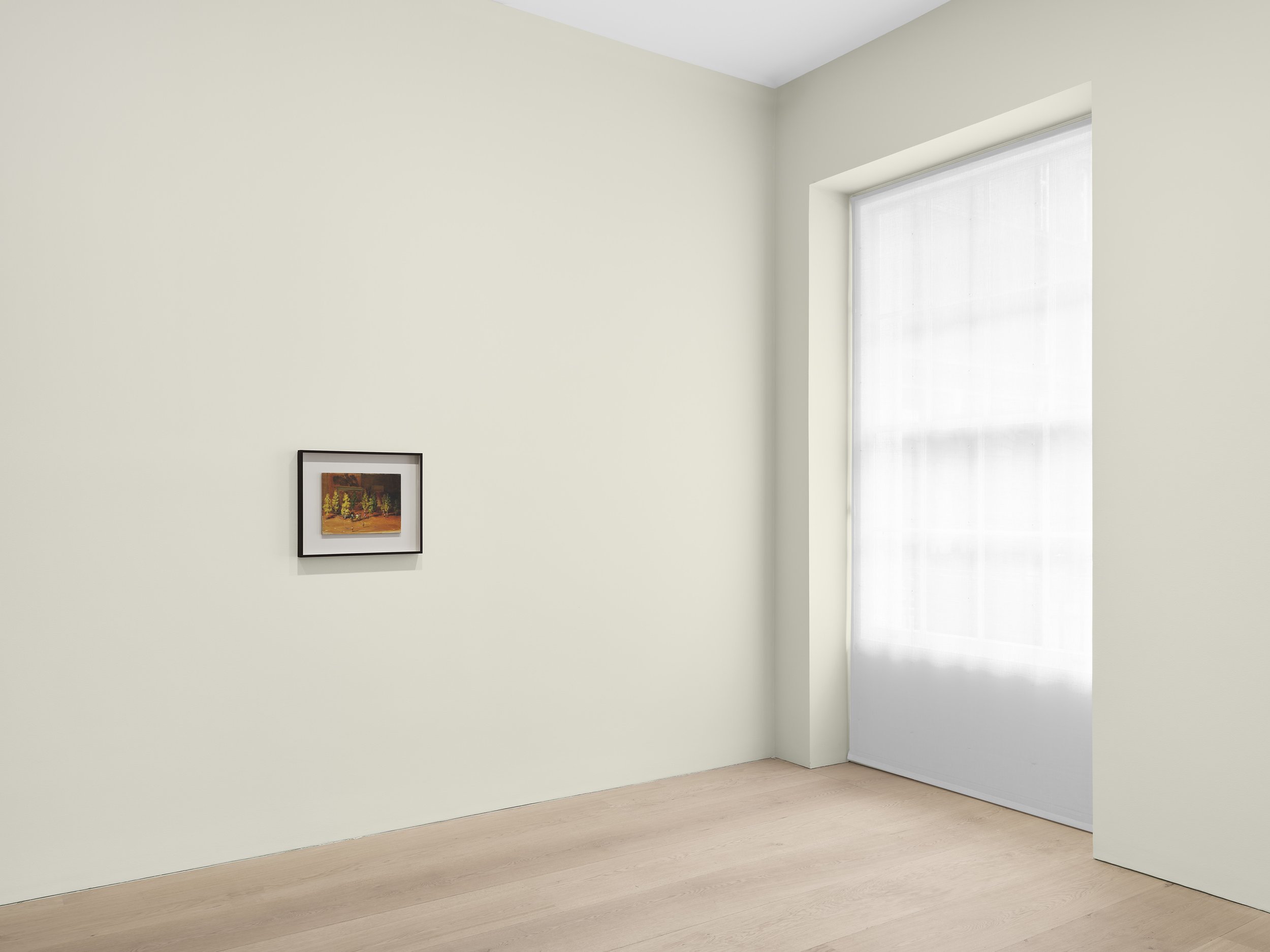

Installation view, Michaël Borremans, The Monkey, David Zwirner, London, 2024. Courtesy David Zwirner
In 2011, Michaël Borremans: Eating the Beard, a comprehensive solo show, was presented at the Württembergischer Kunstverein Stuttgart, and traveled to the Műcsarnok Kunsthalle, Budapest, and the Kunsthalle Helsinki. In 2010, he had a solo exhibition at the Kunstnernes Hus in Oslo, as well as commissioned work on view at the Royal Palace in Brussels. Other venues that have hosted solo exhibitions include the Kestner Gesellschaft, Hanover, Germany (2009); de Appel Arts Centre, Amsterdam (2007); Stedelijk Museum voor Actuele Kunst (S.M.A.K.), Ghent (2005; traveled to Parasol unit foundation for contemporary art, London, and Royal Hibernian Academy, Dublin); Cleveland Museum of Art (2005); Kunsthalle Bremerhaven, Germany (2004); and the Museum für Gegenwartskunst, Basel (2004).
Work by the artist is held in public collections internationally, including the Art Institute of Chicago; Cleveland Museum of Art; Dallas Museum of Art; Hammer Museum, Los Angeles; High Museum of Art, Atlanta; Israel Museum, Jerusalem; Los Angeles County Museum of Art; Musée d’Art Moderne de la Ville de Paris; Museum of Contemporary Art, Los Angeles; Museum of Fine Arts, Boston; The Museum of Modern Art, New York; National Gallery of Canada, Ottawa; San Francisco Museum of Modern Art; Stedelijk Museum voor Actuele Kunst (S.M.A.K.), Ghent; and the Walker Art Center, Minneapolis.
Citations:
1 Michaël Borremans, quoted in “Michaël Borremans Reveals His True Colors to Luca Guadagnino,” Interview (Spring 2024), accessed online.
2 Katya Tylevich, Michaël Borremans: The Monkey. Exh. cat. (New York: David Zwirner Books, 2024), p. 8.
3 Ibid., p. 56.
4 Ibid., pp. 9–10.
5 “Michaël Borremans in Conversation with Julian Taffel,” Marfa Journal (April 2024), n.p.
6 John Vincler, “Art We Saw This Spring,” New York Times (June 8, 2022), accessed online.
This exhibit will open on June 6th and will conclude on July 26th, 2024. For more information about this exhibit, visit David Zwirner’s site; please follow the gallery on Instagram. The gallery can also be found on Artsy here.
Gisela Colón: MATÉRIA PRIMA
Installation view, Gisela Colón, MATÉRIA PRIMA, Museu Nacional da República in Brasília, Brasilia, BR Credit: Courtesy of the Museu Nacional da República in Brasília and the artist. Photography: Diego Bresani
Museu Nacional da República in Brasília is proud to present Gisela Colón: MATÉRIA PRIMA, a multi-part exhibition of recent works by the Puerto Rican-American sculptor, whose ecofeminist artworks address ecological, cosmic, and universal concerns. The exhibition is curated by Simon Watson and Sara Seilert, director, National Museum of the Republic. The exhibition opened on March 21, 2024, and will close on June 3, 2024.
Installation view, Gisela Colón, MATÉRIA PRIMA, Museu Nacional da República in Brasília, Brasilia, BR Credit: Courtesy of the Museu Nacional da República in Brasília and the artist. Photography: Diego Bresani
Gisela Colón (b. 1966) is a Puerto Rican-American contemporary artist whose organic, totemic, light-activated sculptures and monumental environmental installations explore human perception and challenge viewers to experience transformation in real time and space. Through an artistic process that employs high-tech materials like optical acrylics and carbon fiber, as well as matter harvested from sites of the artist’s own life, Colón is known for pioneering a language of “organic minimalism” that recalls the energy of the earth, ancestral biological memories, and concepts of time, gravity, and universal forces of nature. Gisela Colón: MATÉRIA PRIMA marks the artist's first presentation in Brazil.
Organized by independent curator Simon Watson and National Museum director Sara Seilert, the three-part presentation begins outside the museum, where Colón showcases one of her monumental, carbon fiber “parabolic monoliths,” a form she has embedded in the Land Art interventions she’s created at sites around the world. Created specifically for Brasília, the 25-foot-tall monolith Plasmatic: The Fourth State of Matter (Parabolic Monolith Oxygen) references collective Latin American colonial histories, while simultaneously responding to Oscar Niemeyer’s archetypally modernist architecture of the site. Colón employs the word “plasmatic”-- referring to the fourth state of matter created under superheated, intense pressure-- as a metaphor to describe the Latinx experience. “Like plasma,” she says, “we are born of deep oppression, becoming mountains bursting from geological forces beneath the earth, or supernovae exploding into space. The mutable, iridescent surface of the sculpture poetically embodies the evolutionary nature of our colonial struggle, while engaging in a synergistic dialogue with the cultural, ethnographic, and historic conditions of this remarkable Brazilian site.”
At the same time, the monolith’s form evokes the aerodynamic geometries of projectiles used in surveillance and war, and recalls the fraught history of militarized colonialism in the Caribbean, as well as the artist’s own complicated personal experiences with gun violence. Yet for Colón the monolith also echoes, in its soaring verticality, the arresting mountainous peaks of Puerto Rico’s El Yunque Rainforest and the Cordillera Central, an enduring source of materia prima for her. In Colón’s hands, the violence of a projectile is subsumed into the primal, enigmatic form of the mountain, in a decolonial act of transformative healing. Through the monolith, Colón reconfigures entangled histories into a universal language, transmuting forms of violence, displacement, and death into vessels of healing, light, and life,
Inside, under the museum’s iconic dome, Colón channels the force of mountainous geological structures with an immersive installation of works inseveral mediums: six large photo murals, seven 8-foot-high translucent totems, and three luminous sculptures of organic form from Colón’s Pod series. The photo murals present visual documentation of Colón’s international environmental activations around the world, allowing the viewer to travel metaphorically through time and space, through varied geological terrains and historic geographies including the 4500-year-old Egyptian site of the Pyramids of Giza; a remote desert in AlUla, Saudi Arabia, located on the 10,000-year-old spice route; a 17th-century baroque forest in the Netherlands; the Wadi Hanifa River, the only existing waterway in Riyadh, Saudi Arabia; the medieval-era fortification known as the Citadel Salah al-Din in Old Cairo, Egypt, a UNESCO world heritage site; and the resplendent gardens of Regent’s Park in London, England.
Installation view, Gisela Colón, MATÉRIA PRIMA, Museu Nacional da República in Brasília, Brasilia, BR Credit: Courtesy of the Museu Nacional da República in Brasília and the artist. Photography: Diego Bresani
In the same space, three cell-like Pod sculptures reflect Colón’s investigation into color theory, which she conducts through the production of a prismatic experience of light without the use of paint—a method the artist terms “structural color.” Created as vessels of structural color, the sculptures present a fluid color spectrum when seen from different points of view, a function of light refraction that is manifested across the natural world. Thus Colón’s asymmetrical, “humanized” forms embody characteristics of organic life, changing and transforming their physical qualities depending on environmental factors and facilitating a perceptual experience of color as light in real time, while allowing viewers to imagine “impossible” perceptual phenomena like imaginary colors.
Surrounding the Pods, Colón’s array of luminous, cosmic totems rise from the floor to create a topography of translucent, mountainous trees growing in an other-worldly forest. Beyond their large scale and apparent weight, each work articulates a distinctive sense of gravity, accomplished through their palpable response and interaction with surrounding light. Viewers themselves, in both their presence and perception, play an essential role in animating these radiant forms.
Colón’s manipulation of innovative 21st-century materials like optical acrylics and high-technology aerospace carbon fiber paradoxically hijacks the typical functions of these materials in service of militarism and surveillance, and diverts them into the service of transcendence. Colón explains, “I employ as source material the raw energy found in nature, ancestral biological memories, and universal cosmic forces.”
Installation view, Gisela Colón, MATÉRIA PRIMA, Museu Nacional da República in Brasília, Brasilia, BR Credit: Courtesy of the Museu Nacional da República in Brasília and the artist. Photography: Diego Bresani
Gisela Colón’s first monumental Monolith sculpture, realized in 2016, was acquired by the Los Angeles County Museum of Art (LACMA), and was recently featured in the definitive survey exhibition organized by the museum, Light, Space, Surface: Art from the Los Angeles County Museum of Art. Carol Eliel, Senior Curator of Modern Art, wrote about Colón’s work: “[She] understands her work in terms more universal than most artists, referring to her sculptures as
objects that interact not only with the light, viewers, and their immediate environment, but also with the energy of ‘the earth, of the planet’…her Monoliths– tall, freestanding, cast carbon-fiber forms-- in particular draw on the futuristic in tandem with the mysteries of ancient cultural artifacts and structures….”
Photography: Inna Svyatsky
About the artist
Born in 1966, in Vancouver, Canada to a Puerto Rican father studying abroad, Colón was raised in San Juan, Puerto Rico and spent her formative years there. The experiences of her youth exploring the biodiversity of the Caribbean island and creating art with her mother, who was a painter, planted the seeds for her later art practice. Colón graduated from Universidad de Puerto Rico–Recinto de Río Piedras (1987) and Southwestern Law School (1990), and continued to maintain a painting practice until 2012, when she shifted her focus to sculpture. Colón has exhibited internationally throughout the United States, Europe, the Middle East, and Latin America. Notable public exhibitions include The Future is Now for Saudi Arabia’s Land Art Biennial, Desert X AlUla (2020); Forever is Now, a site-specific presentation at the Pyramids of Giza, a UNESCO world heritage site dating back 4,500 years (2021); Godheads - Idols in Times of Crises in the Oude Warande Forest in the Netherlands (2022); One Thousand Galaxies of Light (Starfield), an immersive light installation at the Wadi Hanifa River, in Riyadh, Saudi Arabia (2022); and If The Walls Could Talk / Reclaimed Stones: Foundations of Civilization, Past, Present, Future, at the UNESCO World Heritage Site, the Citadel of Salah al-Din, in Cairo, Egypt (2023). Colón’s work was recently featured in the Los Angeles County Museum of Art’s (LACMA) historic survey exhibition Light, Space, Surface: Art from the Los Angeles County Museum of Art; the Addison Gallery of American Art, Andover, Massachusetts (2021-2022); and the Frist Art Museum, Nashville, Tennessee (2022). Most recently, Colón presented a solo exhibition, The Feminist Divine, at SCAD Museum of Art, Savannah, Georgia (2022). Her work is currently on view in an exhibition of works from the permanent collection of New York’s El Museo del Barrio, Something Beautiful: Reframing La Colección. Forthcoming international projects also include Materia Prima del Caribe: Viajando Através del Tiempo con Luz, Carbón, Balas, Tierra, Agua, y Sal, a collaborative exchange project for La Bienal de la Habana, Cuba (2024).
Gisela Colón’s work resides in institutional collections such as the Los Angeles County Museum of Art, Los Angeles, CA; Wadsworth Atheneum Museum of Art, Hartford, CT; El Museo del Barrio, New York, NY; SCAD Museum of Art, Savannah, GA; Norton Museum of Art, Palm Beach, FL; Museum of Contemporary Art San Diego, San Diego, CA; Perez Art Museum Miami, Miami, FL; Mint Museum, North Carolina; Palm Springs Art Museum, Palm Springs, CA; Grand Rapids Museum of Art, Grand Rapids, MI; and Daum Museum of Contemporary Art, Sedalia, MO.
Publication
An illustrated monograph will accompany this exhibition, containing a scholarly essay by Joachim Pissarro, Bershad Professor of Art History and Director of the Hunter College Galleries, Hunter College, New York, and former Curator in MoMA’s Department of Painting and Sculpture, as well as an interview by Susanna Temkin, curator at El Museo del Barrio, New York.
About Curator Simon Watson
Born in Canada and raised in England and the United States, Simon Watson is an independent curator and art advisor based in New York and São Paulo. A veteran of the cultural scene on three continents, over the past four decades he has curated and organized more than 350 art exhibitions for galleries and museums. His area of curatorial expertise is in spotting visual artists with outstanding potential, many of whom are now seen internationally in the blue chip category and are represented by some of the most established galleries in the world.
Gisela Colón: MATÉRIA PRIMA at Museu Nacional da República marks the second major exhibition Watson has curated the work of Gisela Colón. Their first project was in the legendary site-specific sculpture exhibition Forever Is Now (2022), on the Giza plateau outside Cairo, Egypt, for which Colón created a monumental “rising sun” sculpture positioned in front of the ancient Sphinx.
About Curator Sara Seilert
Sara Seilert is a curator of contemporary art and director of the National Museum of the Republic, being the first woman to hold this position at the institution. Master in Information Science (2023) from the University of Brasília (UnB), with research on the formation of contemporary art museum collections, specifically the collection of the National Museum of the Republic. With a bachelor's degree and degree in Fine Arts from the University of Brasília (2012), she works as a Cultural Activities Analyst with a specialization in Fine and Visual Arts at the Secretariat of Culture and Creative Economy of the Federal District. He has experience in the area of art education and museum management.
About Museu Nacional da República
The National Museum of the Republic (Museu Nacional da República) is a public cultural exhibition site managed by the Department of Culture and Creative Economy of the Federal District. The Museu acquires, preserves, researches, communicates, and exhibits the heritage of Brazilian society, and is host to traveling exhibitions of renowned Brazilian and international artists. Part of the Republic's Cultural Group, the Museu was designed by Oscar Niemeyer and featured in the Brasilia Pilot Plan Report, prepared in 1957 by Lúcio Costa to be part of the Southern Cultural Sector of the New Capital. One of the great, modern architectural monuments of Brasilia’s Esplanade of Ministries, the all- concrete Museu is famous for its white dome and sculptural entrance ramp. Construction of the building began in 1999; it features 14,500 square meters (156,000 square feet) of exhibition area and was inaugurated on December 15, 2006-- the same day that Oscar Niemeyer turned 99 years old.
Museum exhibition hours
March 21 – June 3, 2024
Tuesday to Sunday from 9am to 6:30pm
The exhibition will close on June 3rd of this year. For more information about this exhibition and others, please visit the Museu Nacional da República website here. They can also be found on Instagram here and Facebook here.
Gisela Colón : Mountains Are Inside Me
New York, NY - Efraín López is pleased to present Mountains Are Inside Me, an exhibition of new works by Puerto Rican- American sculptor, Gisela Colón. The exhibition will be on view from April 30 through June 22, 2024. For her first solo show at the gallery, the artist will present two new sculptural works alongside an early painting, a suite of intimately- scaled works on paper, and an architectural intervention. Mountains Are Inside Me will be accompanied by an essay authored by curator César García-Alvarez.
Gisela Colón’s sculptural practice explores identity, transformation, energy, time, and space. Her work is grounded in minimal organic aesthetics that refuse stasis, and instead embrace transformation and transcendence. Throughout her practice, Colón employs strategies of abstraction to both subsume and conceal the complexities of identity and personal narrative. Her work crosses geographic, political, and national boundaries, to form multicultural dialogues and create space for Latinx voices.
Contextualizing the origin of the monolithic form, the presentation opens with an early painting titled Pinnacle (El Yunque), 1996. Conjured from her observations and experiences in El Yunque, the tropical rainforest of her homeland in Puerto Rico, this work marks the first appearance of the monolithic structure that has become the principal occupation of Colón’s work. The artist’s use of abstraction and universal geometries belies an alternate reality shaped by complex diasporic conditions. Colon’s monoliths simultaneously evoke the fraught collective history of militarized colonialism in the Caribbean and draw upon her own layered experiences with gun violence. Shaped by a process of healing and transformation, the soaring verticality of the monoliths reflects the mountainous peaks of Puerto Rico’s captivating geology, an enduring source of materia prima for the artist.
Anchoring the main exhibition space, Tierra de Substrato Arecibo Hematita (Parabolic Monolith Hematite), builds upon Colón’s distinctive organic minimalist language while further elucidating her personal history and often-illegible identity as a diasporic Puerto Rican artist. In Tierra de Substrato Arecibo Hematita, Colón's use of red earth from her family’s plot of land in Arecibo connects formative moments of a childhood surrounded by violence and displacement to an early fascination with outer space and the cosmos nurtured at the Observatory de Arecibo—until recently the largest telescope in the world. A deeply personal work, Tierra de Substrato Arecibo Hematita, is the bedrock that lies beneath the artist’s own biographical story, concealed within layers calcified by the broader implications of Puerto Rico's stratified history with colonialism. The distinctive ochre color of Puerto Rico’s red earth comes from the mineral hematite, an iron oxide formed over time. Hematite, one of the earliest pigments used by man, appears in ancient cave drawings throughout the world, as well as on other planetary bodies. In Tierra de Substrato Arecibo Hematita, Colón constructs a vessel that imagines an expansive cosmic world filled with the energy of nature, ancestral memories, and a universal consciousness larger than any single individual. In imagining this vast expanse of space and time, subjective lived experiences on a human scale are absorbed into the universal, infinite form of the monolith—a structure shared across time by geological formations, prehistoric archeological structures, and ancient architectures. Colón’s larger-than-life totemic structure encapsulates a transformative moment in time, where the complexities of an infinite cosmos, composed of cosmic matter and energy, swirl within its confines.










Installation view, Gisela Colón, Mountains Are Inside Me, Efraín López, New York Credit: Courtesy of Efraín López and the artist. Photography: Inna Svyatsky
While rooted in Colón’s personal relationship to land and encounters with violence, Tierra de Substrato Arecibo Hematita works to absorb the specificities of individualized negative experiences to form a transformative vessel of healing, light, and life. In this work, Colón has invited us to consider what lies beneath the surface and sits within the infinite potentiality of the cosmic world, grounded in the raw dirt that bore ancestral life on earth.
About the Artist
Gisela Colón (American b. 1966, Vancouver, Canada, raised 1967, San Juan, Puerto Rico) is a Puerto Rican-American artist whose dynamic sculptures offer mutable, perceptual experiences through the refraction, reflection, and emission of light. Generated with advanced production methods such as carbon fiber casting meant for aerospace applications, Colón’s curvilinear forms emanate a seductive, iridescent glow, fluctuating in color based on environmental conditions and where the viewer stands in relation to the work. Colón coined the term “Organic Minimalism” to describe the dual condition of her work: reductive yet active and seemingly alive. While situated within the lineage of Minimalism, Colón’s practice refuses the stasis and rigidity of structure typical of work by her male predecessors, embracing the transformative and transcendent. Informed by the natural world and rich biodiversity of her home island of Puerto Rico, her work invokes the “feminine divine” as a method of creating space for underrepresented People.
Colón has exhibited internationally throughout the United States, Europe, Egypt, the Middle East, and Latin America. Notable public exhibitions include The Future is Now for the Land Art Biennial, Desert X, Godheads - Idols in Times of Crises in the Oude Warande Forest (Netherlands 2022), and One Thousand Galaxies of Light (Starfield), an immersive light installation at the Wadi Hanifa River, Riyadh, Saudi Arabia (November 2022). Colón's work was recently featured in the Los Angeles County Museum of Art's (LACMA's) historical survey exhibition Light, Space, Surface: Art from the Los Angeles County Museum of Art, the Addison Gallery of American Art, Andover, Massachusetts (2021-2022), and. Most recently, Colón presented a solo exhibition, The Feminist Divine, at the SCAD Museum of Art, Savannah, Georgia (2022). Her work is currently on view in an exhibition of works from the permanent collection of New York’s El Museo del Barrio, Something Beautiful: Reframing La Colección. Forthcoming international projects also include Materia Prima del Caribe: Viajando Através del Tiempo con Luz, Carbón, Balas, Tierra, Agua, y Sal, a collaborative exchange project for La Bienal de la Habana, Cuba (2024).
Gisela Colón’s work resides in institutional collections such as the Los Angeles County Museum of Art, Los Angeles, CA; Wadsworth Atheneum Museum of Art, Hartford, CT; El Museo del Barrio, New York, NY; SCAD Museum of Art, Savannah, GA; Norton Museum of Art, Palm Beach, FL; Museum of Contemporary Art San Diego, San Diego, CA; Perez Art Museum Miami, Miami, FL; Mint Museum, North Carolina; Palm Springs Art Museum, Palm Springs, CA; Grand Rapids Museum of Art, Grand Rapids, MI; and Daum Museum of Contemporary Art, Sedalia, MO.
About Efraín López
Efraín López is a Puerto Rican-American art dealer and exhibition maker based in New York City. Between 2012 and 2018, López founded and directed his eponymous gallery in Chicago, where he presented an ambitious and rigorous exhibition program, often giving artists their first solo presentation in the United States. His long-standing commitment to the career development of emerging artists has led to placements in major museum collections worldwide. In June of 2023 López opened Efraín López, a contemporary art gallery in New York's Tribeca neighborhood. The program is conceptual, multidisciplinary, and globally minded, engaging both emerging and established artists.
For more information about this exhibition and others please visit the Efraín López here
Paul McCartney Photographs 1963–64: Eyes of the Storm
Paul McCartney. Self-portrait. London, 1963. Pigmented inkjet print. © 1963 Paul McCartney under exclusive license to MPL Archive LLP
As The Beatles captured the hearts of millions, Paul McCartney captured it all on his Pentax film camera. Paul McCartney Photographs 1963–64: Eyes of the Storm takes visitors inside the 1963–64 frenzy of Beatlemania, as the band’s first U.S. tour skyrocketed them to global fame. More than 250 of McCartney’s photographs, recently rediscovered in his archives, reveal his singular vantage point at the center of this whirlwind of attention and adoration—illuminating both the historical, and the personal, moments McCartney and his bandmates experienced together. First on view at the National Portrait Gallery in London, England, the exhibition makes its New York debut at the Brooklyn Museum, opened on May 3, 2024, and is supported by Bloomberg Philanthropies.
Paul McCartney. John and George. Paris, January 1964. Pigmented inkjet print. © 1964 Paul McCartney under exclusive license to MPL Archive LLP
“Since first arriving in New York in February 1964, Paul McCartney has built a strong, everlasting connection to the city. His vibrant photographs from The Beatles’ first visit capture the energy of the city, the excitement of the American fans, and the frenzy of the band’s status as celebrities. Yet the images also record The Beatles’ fun and delight with each other. Through McCartney’s lens, we feel the intensity of being at the center of such extraordinary events,” says Catherine Futter, Director of Curatorial Affairs and Senior Curator of Decorative Arts.
Paul McCartney. Self-portraits. Paris, January 1964. Pigmented inkjet print. © 1964 Paul McCartney under exclusive license to MPL Archive LLP
In an immersive installation of photography, video clips, and archival material, Eyes of the Storm traces the period when The Beatles played concert halls in Liverpool and London and began to tour internationally, first to Paris and then to the United States. McCartney’s photographs convey the intensity of the band’s touring schedule in the U.S., as the Fab Four were swept from concerts to hotels to the road with rabid fans and paparazzi at their heels, from New York and Washington, DC, to Miami. The band’s arrival in New York signaled a turning point in popular culture, as their first televised performance on The Ed Sullivan Show was watched by around seventy-three million people and launched The Beatles into superstardom.
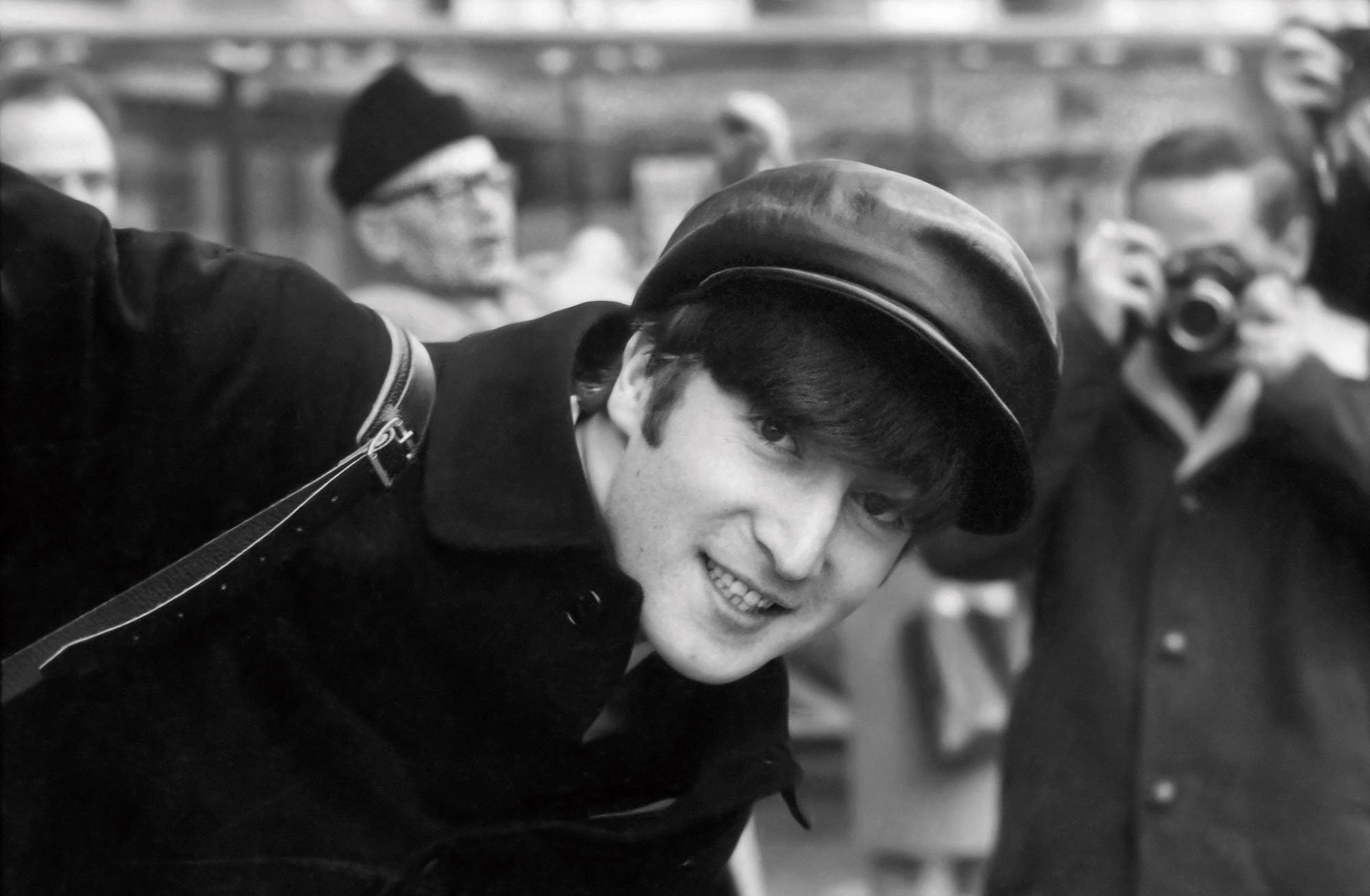

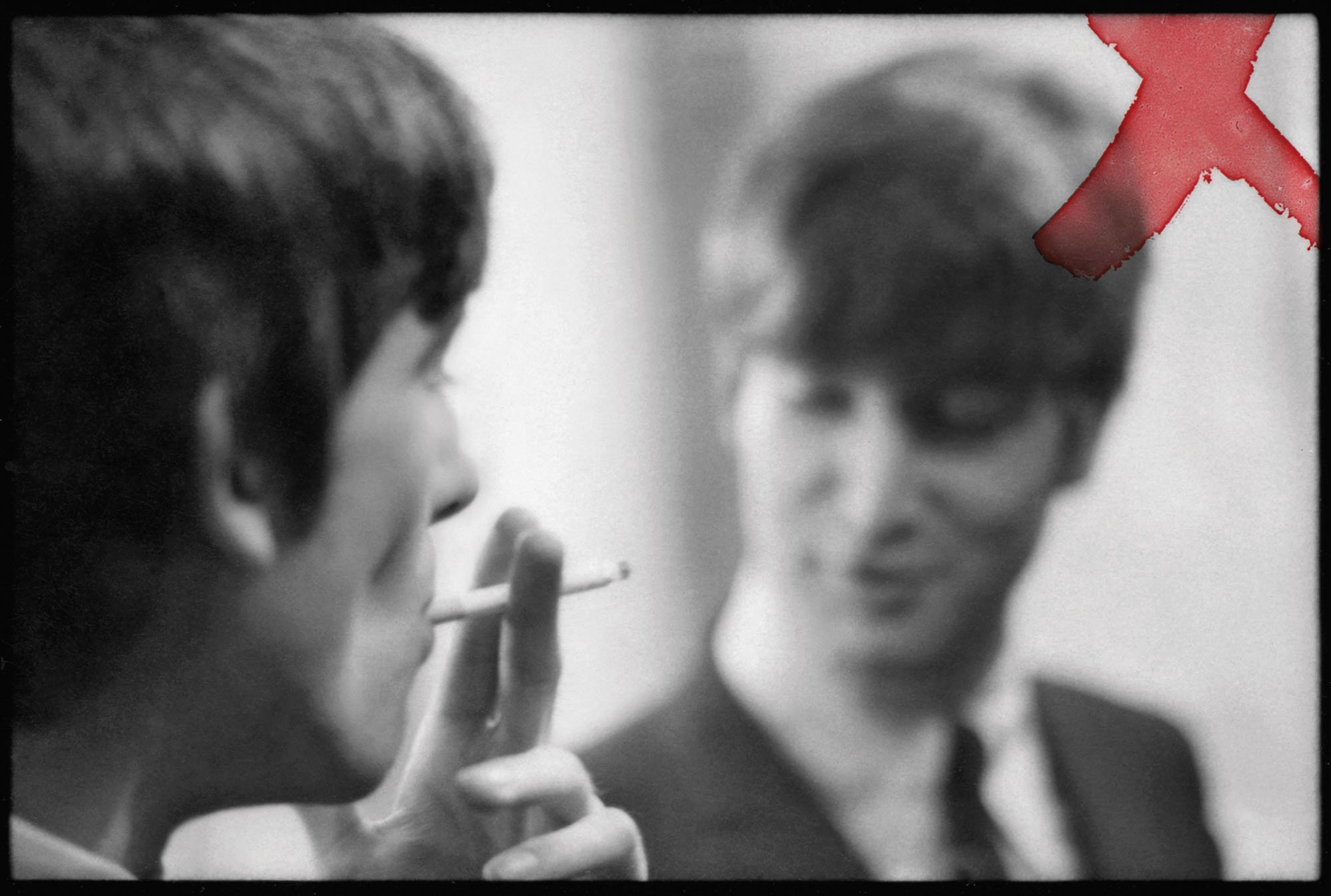



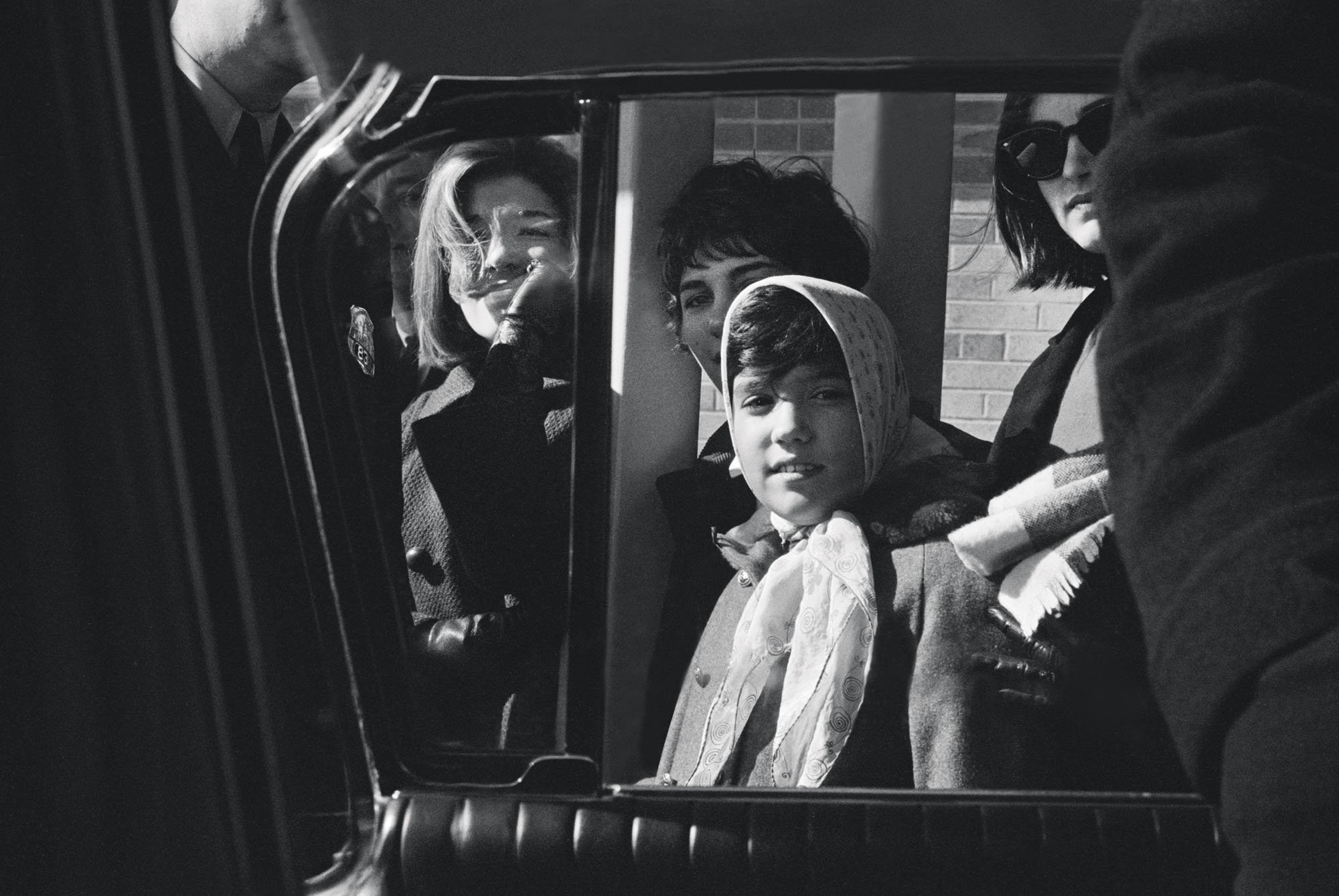


McCartney’s explorations in photography reflect his commitment to both the musical and visual arts. The range of work, from portraiture and landscape photos to documentary images, reveals McCartney’s familiarity with the formal styles of early 1960s photography. References to New Wave, documentary filmmaking, and photojournalism can be found across the exhibition.
Paul McCartney. West 58th Street, crossing 6th Avenue. New York, February 1964. Pigmented inkjet print. © 1964 Paul McCartney under exclusive license to MPL Archive LLP
Eyes of the Storm not only showcases McCartney’s artistic versatility but also serves as a personal and historical archive. In addition to documenting the demands of touring and nonstop media attention, the photographs evoke an affectionate family album, picturing his fellow band members, John Lennon, George Harrison, and Ringo Starr, at a time when their lives were changing irrevocably. The exhibition gives visitors a highly personal glimpse into an extraordinary time period of one of music’s enduring legends. Born in Liverpool, England, Paul McCartney rose to prominence as a founding member of The Beatles. Throughout his lifetime, McCartney has played a pivotal role in shaping the landscape of popular music and culture more broadly.









Installation view, Paul McCartney Photographs 1963-64: Eyes of the Storm, May 3, 2024 - August 18, 2024. (Photo: Danny Perez)
Paul McCartney Photographs 1963–64: Eyes of the Storm has been organized by the National Portrait Gallery, London, England, in collaboration with Paul McCartney. It is curated by Paul McCartney with Sarah Brown for MPL Communications and Rosie Broadley for the National Portrait Gallery. The presentation at the Brooklyn Museum is organized by Catherine Futter, Director of Curatorial Affairs and Senior Curator of Decorative Arts, and Jennie Tang, Executive Assistant to the Deputy Director of Art and the Director of Curatorial Affairs.
Lead Sponsor
About Bloomberg Philanthropies:
Bloomberg Philanthropies invests in 700 cities and 150 countries around the world to ensure better, longer lives for the greatest number of people. The organization focuses on five key areas for creating lasting change: the Arts, Education, Environment, Government Innovation, and Public Health. Bloomberg Philanthropies encompasses all of Michael R. Bloomberg’s giving, including his foundation, corporate, and personal philanthropy as well as Bloomberg Associates, a pro bono consultancy that works in cities around the world. In 2022, Bloomberg Philanthropies distributed $1.7 billion. For more information, about Bloomberg Philanthropies, please visit here and sign up for their newsletter, or follow them on Facebook, Instagram, YouTube, Twitter, and LinkedIn.
The exhibit opened on May 3rd, 2024, and the exhibit will close on August 18 of this year. Please visit the Brooklyn Museum’s site for more information about the exhibit. The Museum can also be found on Instagram, TikTok, YouTube, and Facebook.





































